Effect of Motivation on Organizational Progress
VerifiedAdded on 2020/12/10
|72
|24850
|447
Report
AI Summary
This report investigates the impact of employee motivation on organizational progress, particularly in the hospitality sector. It analyzes the concept of motivation, examines business growth factors, and explores the relationship between employee motivation and business growth. The report uses a case study of Hilton Hotel to illustrate these concepts and provides recommendations for enhancing employee motivation to drive business success.
Contribute Materials
Your contribution can guide someone’s learning journey. Share your
documents today.
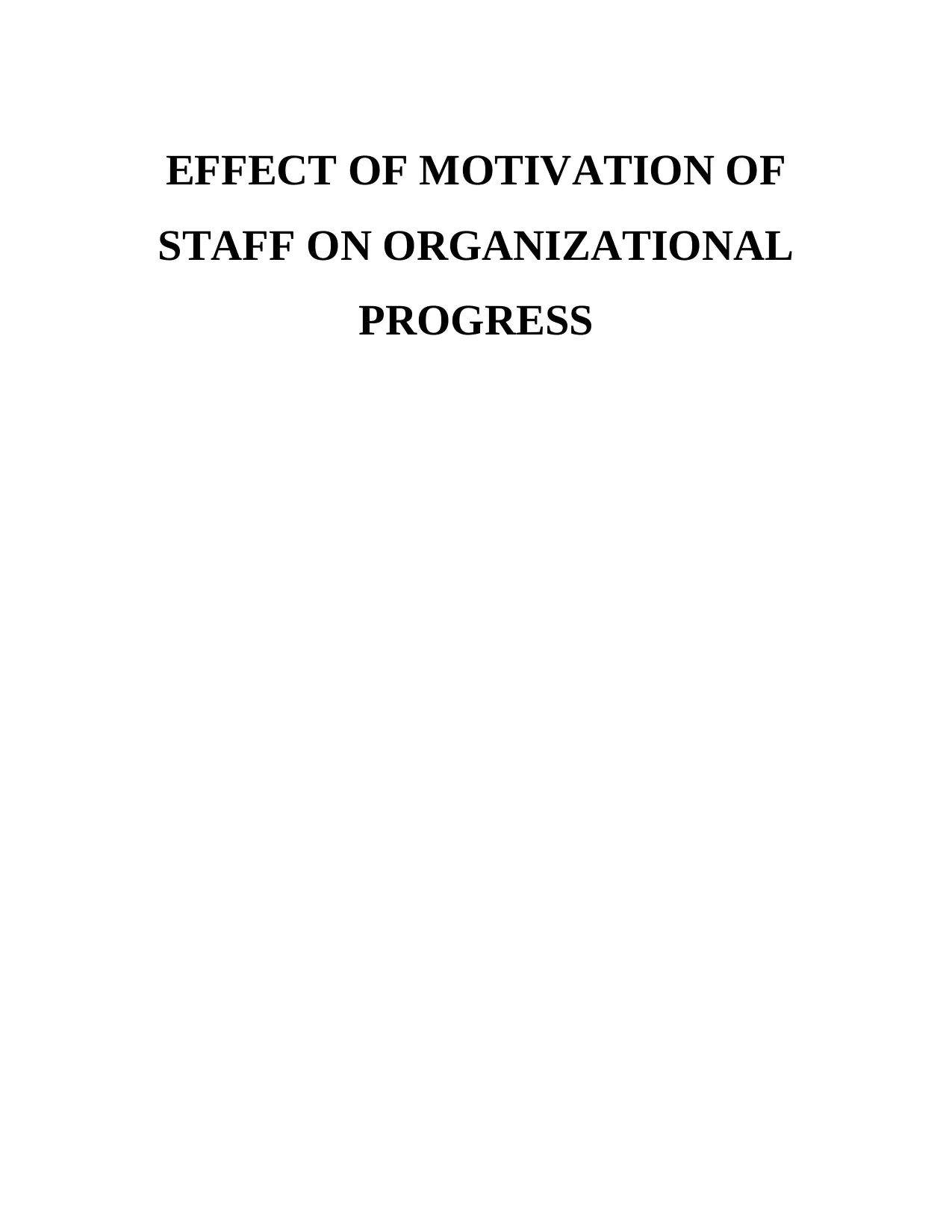
EFFECT OF MOTIVATION OF
STAFF ON ORGANIZATIONAL
PROGRESS
STAFF ON ORGANIZATIONAL
PROGRESS
Secure Best Marks with AI Grader
Need help grading? Try our AI Grader for instant feedback on your assignments.

TABLE OF CONTENTS
Abstract............................................................................................................................................1
Title: “Impact of motivation of an employee on the business growth of a company- A Case
Study on Hilton hotel”.....................................................................................................................3
INTRODUCTION...........................................................................................................................3
Overview.....................................................................................................................................3
Research purpose........................................................................................................................6
Significance of the Study............................................................................................................6
Research Objectives....................................................................................................................7
Structure of the Study.................................................................................................................7
LITERATURE REVIEW................................................................................................................9
Overview.....................................................................................................................................9
Concept of motivation for an employee in hospitality sector business.......................................9
Analysis of Business growth of organization ..........................................................................12
Motivation of an employee and business growth of hospitality enterprise...............................17
Recommending ways through employee motivation can be raised for high business growth. 22
Conclusion................................................................................................................................24
METHODOLOGY AND RESEARCH DESIGN.........................................................................24
Overview...................................................................................................................................24
Research type............................................................................................................................24
Research philosophy.................................................................................................................26
Research approach ...................................................................................................................29
Research design.........................................................................................................................30
Data Collection.........................................................................................................................32
Access and ethical issues.................................................................................................33
Data Analysis............................................................................................................................34
Conclusion................................................................................................................................35
PRESENTATION AND DISCUSSION OF THE FINDINGS.....................................................35
Discussion.................................................................................................................................57
Abstract............................................................................................................................................1
Title: “Impact of motivation of an employee on the business growth of a company- A Case
Study on Hilton hotel”.....................................................................................................................3
INTRODUCTION...........................................................................................................................3
Overview.....................................................................................................................................3
Research purpose........................................................................................................................6
Significance of the Study............................................................................................................6
Research Objectives....................................................................................................................7
Structure of the Study.................................................................................................................7
LITERATURE REVIEW................................................................................................................9
Overview.....................................................................................................................................9
Concept of motivation for an employee in hospitality sector business.......................................9
Analysis of Business growth of organization ..........................................................................12
Motivation of an employee and business growth of hospitality enterprise...............................17
Recommending ways through employee motivation can be raised for high business growth. 22
Conclusion................................................................................................................................24
METHODOLOGY AND RESEARCH DESIGN.........................................................................24
Overview...................................................................................................................................24
Research type............................................................................................................................24
Research philosophy.................................................................................................................26
Research approach ...................................................................................................................29
Research design.........................................................................................................................30
Data Collection.........................................................................................................................32
Access and ethical issues.................................................................................................33
Data Analysis............................................................................................................................34
Conclusion................................................................................................................................35
PRESENTATION AND DISCUSSION OF THE FINDINGS.....................................................35
Discussion.................................................................................................................................57

CONCLUDING THOUGHTS ON THE CONTRIBUTION OF THIS RESEARCH, ITS
LIMITATIONS AND SUGGESTIONS FOR FURTHER RESEARCH......................................61
Conclusion ...............................................................................................................................61
Recommendations.......................................................................................................................1
REFERENCES................................................................................................................................3
LIMITATIONS AND SUGGESTIONS FOR FURTHER RESEARCH......................................61
Conclusion ...............................................................................................................................61
Recommendations.......................................................................................................................1
REFERENCES................................................................................................................................3

Abstract
In the present scenario, employees are considered as heart of organizations as they play
very important for every role whether it is success or failure. Motivation is replicated as very
vital factor which encourages one to give their best performance in order to attain objectives of
enterprises. The strong positive motivation helps in enabling the raised output of employees but
on the contrary, negative output decrease performance as well. The motivation is categorised in
two types as extrinsic and intrinsic. Extrinsic motivation signifies about motivational stimuli of
individual which has been originated from outside. In simple words, it can be explained as desire
for performing task which are controlled through outside source. Therefore, motivating
employee is important job which has to be taken care by human resource manager. It helps in
retaining staff, improving the quality of work by implementing positive attitude towards
company. It can be presented from the evaluation that aspect pertaining to job security has
significant impact on employee motivation. Moreover, employees prefer to stay in the firm for
long duration which offer opportunities to them in relation to growth in terms of both monetary
and non-monetary.
1
In the present scenario, employees are considered as heart of organizations as they play
very important for every role whether it is success or failure. Motivation is replicated as very
vital factor which encourages one to give their best performance in order to attain objectives of
enterprises. The strong positive motivation helps in enabling the raised output of employees but
on the contrary, negative output decrease performance as well. The motivation is categorised in
two types as extrinsic and intrinsic. Extrinsic motivation signifies about motivational stimuli of
individual which has been originated from outside. In simple words, it can be explained as desire
for performing task which are controlled through outside source. Therefore, motivating
employee is important job which has to be taken care by human resource manager. It helps in
retaining staff, improving the quality of work by implementing positive attitude towards
company. It can be presented from the evaluation that aspect pertaining to job security has
significant impact on employee motivation. Moreover, employees prefer to stay in the firm for
long duration which offer opportunities to them in relation to growth in terms of both monetary
and non-monetary.
1
Secure Best Marks with AI Grader
Need help grading? Try our AI Grader for instant feedback on your assignments.
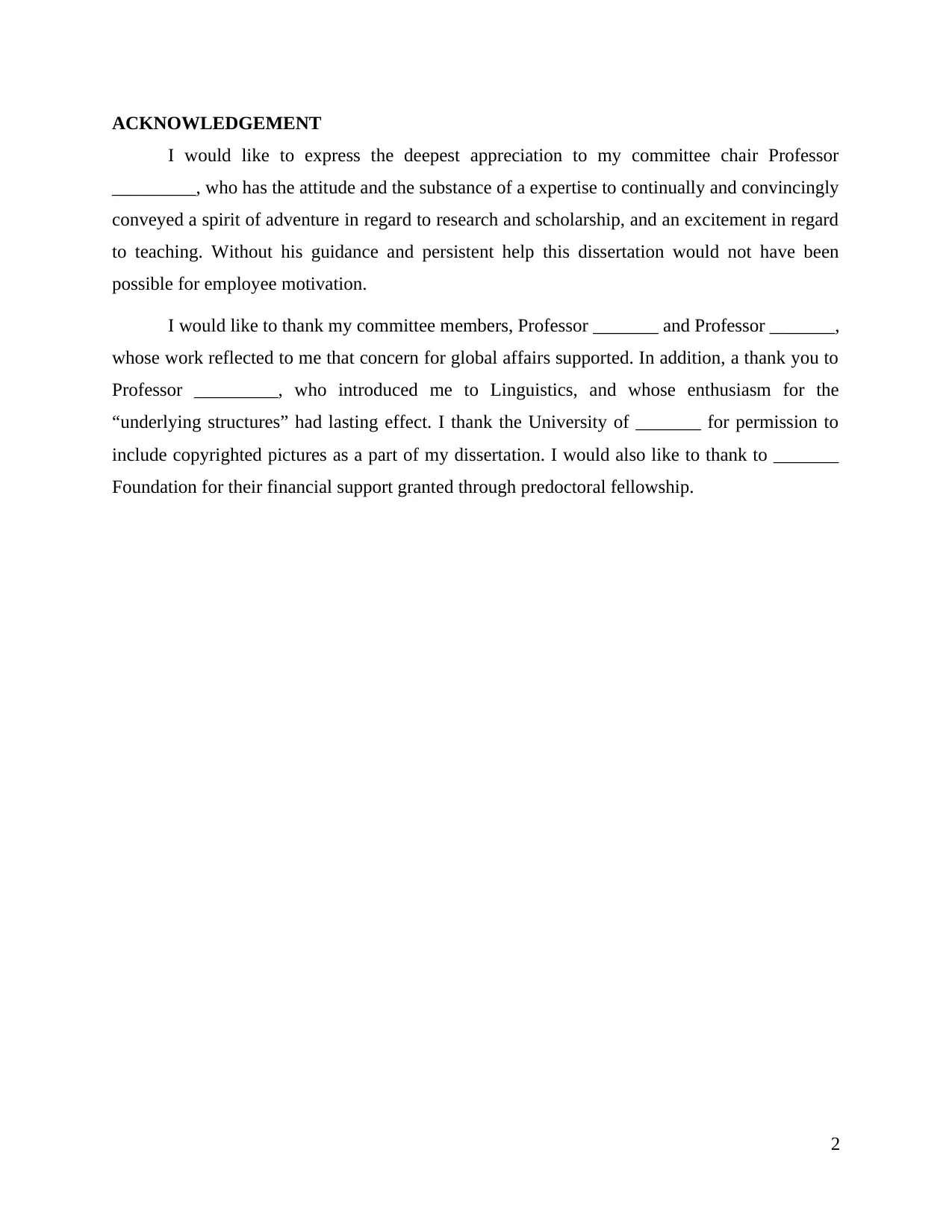
ACKNOWLEDGEMENT
I would like to express the deepest appreciation to my committee chair Professor
_________, who has the attitude and the substance of a expertise to continually and convincingly
conveyed a spirit of adventure in regard to research and scholarship, and an excitement in regard
to teaching. Without his guidance and persistent help this dissertation would not have been
possible for employee motivation.
I would like to thank my committee members, Professor _______ and Professor _______,
whose work reflected to me that concern for global affairs supported. In addition, a thank you to
Professor _________, who introduced me to Linguistics, and whose enthusiasm for the
“underlying structures” had lasting effect. I thank the University of _______ for permission to
include copyrighted pictures as a part of my dissertation. I would also like to thank to _______
Foundation for their financial support granted through predoctoral fellowship.
2
I would like to express the deepest appreciation to my committee chair Professor
_________, who has the attitude and the substance of a expertise to continually and convincingly
conveyed a spirit of adventure in regard to research and scholarship, and an excitement in regard
to teaching. Without his guidance and persistent help this dissertation would not have been
possible for employee motivation.
I would like to thank my committee members, Professor _______ and Professor _______,
whose work reflected to me that concern for global affairs supported. In addition, a thank you to
Professor _________, who introduced me to Linguistics, and whose enthusiasm for the
“underlying structures” had lasting effect. I thank the University of _______ for permission to
include copyrighted pictures as a part of my dissertation. I would also like to thank to _______
Foundation for their financial support granted through predoctoral fellowship.
2

Title: “Impact of motivation of an employee on the business growth of a company-
A Case Study on Hilton hotel”.
INTRODUCTION
Overview
Motivation is derived through the word 'motive' which can be elaborated as inner state of
mind that directs and activates the behaviour. Generally, it is originated from internal to
everyone and externalized through behaviour. In simple words, this in one's willingness to exert
efforts towards attainment of goals and objectives. This is replicated as very vital factor which
encourages one to give their best performance in order to attain objectives of enterprises. The
strong positive motivation helps in enabling the raised output of employees but on the contrary,
negative output decrease performance as well. The key element in personnel management is
replicated as motivation. Motivation is a process for stimulating people to actions for attaining
objectives and in context of work, the psychological factors which stimulate behaviour of people.
This could be desire of money, recognition, job satisfaction, success, team work etc. The most
important role of management is for creating willingness in employees for performing best as per
their capabilities.
In the present scenario, managers and researchers had belief that organizational goals and
objectives are not attainable with absence of enduring commitment of employees and members
of business unit. The world is facing enormous alteration as globalization of business is raising
along with advancement of technologies. The major alterations are reshaping significantly for
worse and better as well. It leads to alterations in the way business is done and behaviour of
employees and managers. On basis of organizational perspective it is desire to attain success, it is
highly essential for adopting changes. As they are reshaping the entire world and operations of
organization which led to alterations in employee characteristics. Motivation is defined as state
of multiple indefinite factors which cause person to perform his responsibilities in special aspect.
Its factors are indefinite due to constant alteration with time. This has been stated that employee
would not operate in special way if there is absence of encouragement to perform the specific
task.
The motivation could be understood in three parts; as first is about arousal which directly
deals with drive or energy from action of any individual. Second is all about referring choice that
3
A Case Study on Hilton hotel”.
INTRODUCTION
Overview
Motivation is derived through the word 'motive' which can be elaborated as inner state of
mind that directs and activates the behaviour. Generally, it is originated from internal to
everyone and externalized through behaviour. In simple words, this in one's willingness to exert
efforts towards attainment of goals and objectives. This is replicated as very vital factor which
encourages one to give their best performance in order to attain objectives of enterprises. The
strong positive motivation helps in enabling the raised output of employees but on the contrary,
negative output decrease performance as well. The key element in personnel management is
replicated as motivation. Motivation is a process for stimulating people to actions for attaining
objectives and in context of work, the psychological factors which stimulate behaviour of people.
This could be desire of money, recognition, job satisfaction, success, team work etc. The most
important role of management is for creating willingness in employees for performing best as per
their capabilities.
In the present scenario, managers and researchers had belief that organizational goals and
objectives are not attainable with absence of enduring commitment of employees and members
of business unit. The world is facing enormous alteration as globalization of business is raising
along with advancement of technologies. The major alterations are reshaping significantly for
worse and better as well. It leads to alterations in the way business is done and behaviour of
employees and managers. On basis of organizational perspective it is desire to attain success, it is
highly essential for adopting changes. As they are reshaping the entire world and operations of
organization which led to alterations in employee characteristics. Motivation is defined as state
of multiple indefinite factors which cause person to perform his responsibilities in special aspect.
Its factors are indefinite due to constant alteration with time. This has been stated that employee
would not operate in special way if there is absence of encouragement to perform the specific
task.
The motivation could be understood in three parts; as first is about arousal which directly
deals with drive or energy from action of any individual. Second is all about referring choice that
3
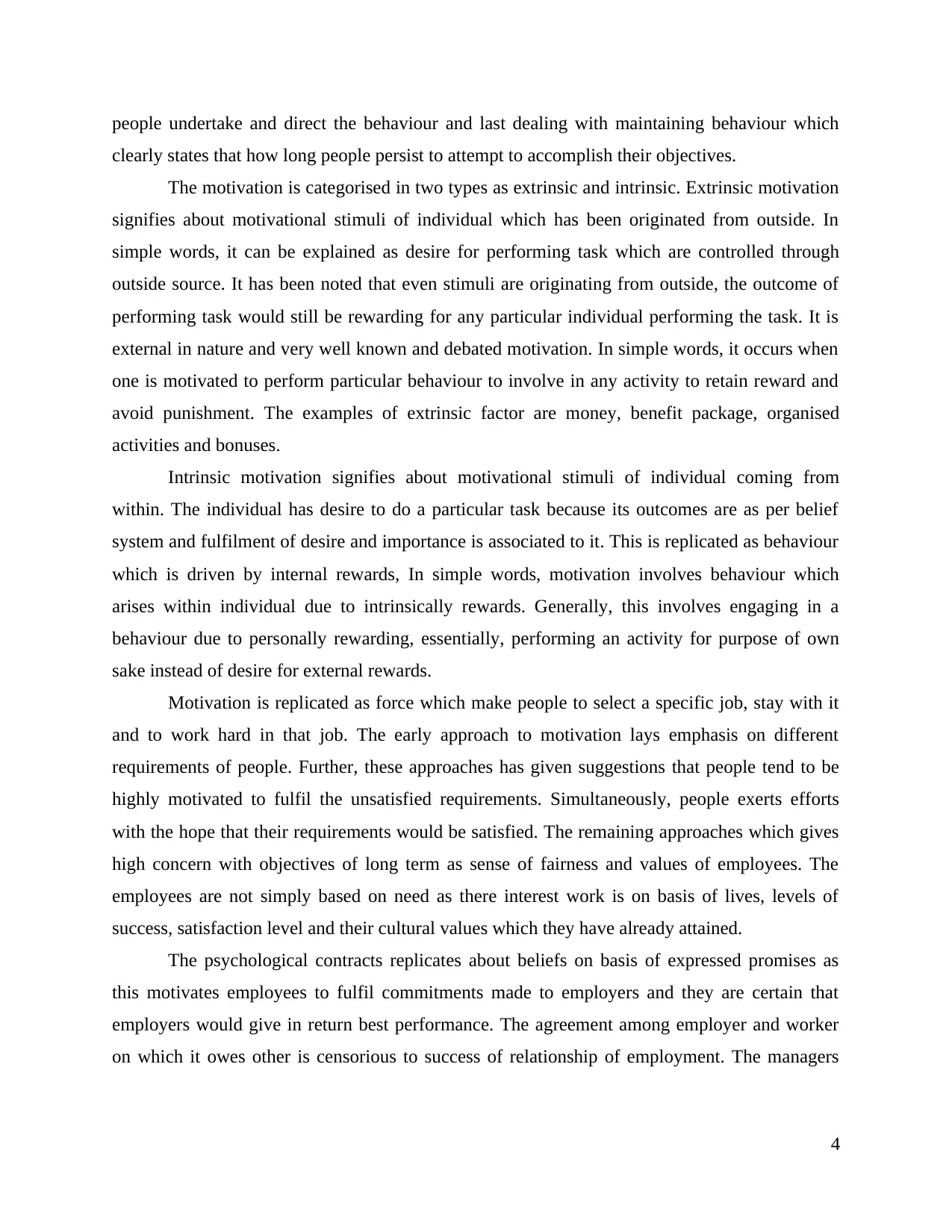
people undertake and direct the behaviour and last dealing with maintaining behaviour which
clearly states that how long people persist to attempt to accomplish their objectives.
The motivation is categorised in two types as extrinsic and intrinsic. Extrinsic motivation
signifies about motivational stimuli of individual which has been originated from outside. In
simple words, it can be explained as desire for performing task which are controlled through
outside source. It has been noted that even stimuli are originating from outside, the outcome of
performing task would still be rewarding for any particular individual performing the task. It is
external in nature and very well known and debated motivation. In simple words, it occurs when
one is motivated to perform particular behaviour to involve in any activity to retain reward and
avoid punishment. The examples of extrinsic factor are money, benefit package, organised
activities and bonuses.
Intrinsic motivation signifies about motivational stimuli of individual coming from
within. The individual has desire to do a particular task because its outcomes are as per belief
system and fulfilment of desire and importance is associated to it. This is replicated as behaviour
which is driven by internal rewards, In simple words, motivation involves behaviour which
arises within individual due to intrinsically rewards. Generally, this involves engaging in a
behaviour due to personally rewarding, essentially, performing an activity for purpose of own
sake instead of desire for external rewards.
Motivation is replicated as force which make people to select a specific job, stay with it
and to work hard in that job. The early approach to motivation lays emphasis on different
requirements of people. Further, these approaches has given suggestions that people tend to be
highly motivated to fulfil the unsatisfied requirements. Simultaneously, people exerts efforts
with the hope that their requirements would be satisfied. The remaining approaches which gives
high concern with objectives of long term as sense of fairness and values of employees. The
employees are not simply based on need as there interest work is on basis of lives, levels of
success, satisfaction level and their cultural values which they have already attained.
The psychological contracts replicates about beliefs on basis of expressed promises as
this motivates employees to fulfil commitments made to employers and they are certain that
employers would give in return best performance. The agreement among employer and worker
on which it owes other is censorious to success of relationship of employment. The managers
4
clearly states that how long people persist to attempt to accomplish their objectives.
The motivation is categorised in two types as extrinsic and intrinsic. Extrinsic motivation
signifies about motivational stimuli of individual which has been originated from outside. In
simple words, it can be explained as desire for performing task which are controlled through
outside source. It has been noted that even stimuli are originating from outside, the outcome of
performing task would still be rewarding for any particular individual performing the task. It is
external in nature and very well known and debated motivation. In simple words, it occurs when
one is motivated to perform particular behaviour to involve in any activity to retain reward and
avoid punishment. The examples of extrinsic factor are money, benefit package, organised
activities and bonuses.
Intrinsic motivation signifies about motivational stimuli of individual coming from
within. The individual has desire to do a particular task because its outcomes are as per belief
system and fulfilment of desire and importance is associated to it. This is replicated as behaviour
which is driven by internal rewards, In simple words, motivation involves behaviour which
arises within individual due to intrinsically rewards. Generally, this involves engaging in a
behaviour due to personally rewarding, essentially, performing an activity for purpose of own
sake instead of desire for external rewards.
Motivation is replicated as force which make people to select a specific job, stay with it
and to work hard in that job. The early approach to motivation lays emphasis on different
requirements of people. Further, these approaches has given suggestions that people tend to be
highly motivated to fulfil the unsatisfied requirements. Simultaneously, people exerts efforts
with the hope that their requirements would be satisfied. The remaining approaches which gives
high concern with objectives of long term as sense of fairness and values of employees. The
employees are not simply based on need as there interest work is on basis of lives, levels of
success, satisfaction level and their cultural values which they have already attained.
The psychological contracts replicates about beliefs on basis of expressed promises as
this motivates employees to fulfil commitments made to employers and they are certain that
employers would give in return best performance. The agreement among employer and worker
on which it owes other is censorious to success of relationship of employment. The managers
4
Paraphrase This Document
Need a fresh take? Get an instant paraphrase of this document with our AI Paraphraser
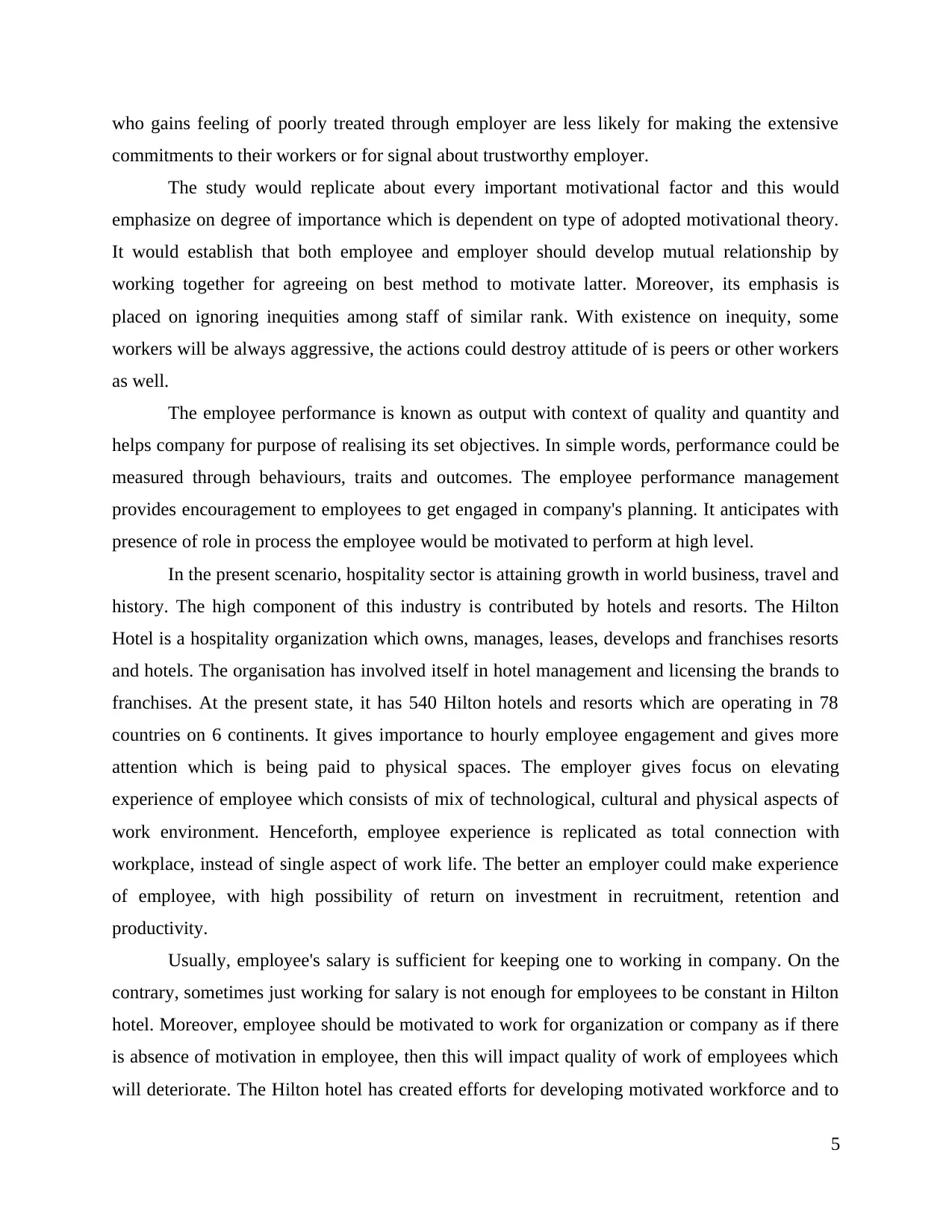
who gains feeling of poorly treated through employer are less likely for making the extensive
commitments to their workers or for signal about trustworthy employer.
The study would replicate about every important motivational factor and this would
emphasize on degree of importance which is dependent on type of adopted motivational theory.
It would establish that both employee and employer should develop mutual relationship by
working together for agreeing on best method to motivate latter. Moreover, its emphasis is
placed on ignoring inequities among staff of similar rank. With existence on inequity, some
workers will be always aggressive, the actions could destroy attitude of is peers or other workers
as well.
The employee performance is known as output with context of quality and quantity and
helps company for purpose of realising its set objectives. In simple words, performance could be
measured through behaviours, traits and outcomes. The employee performance management
provides encouragement to employees to get engaged in company's planning. It anticipates with
presence of role in process the employee would be motivated to perform at high level.
In the present scenario, hospitality sector is attaining growth in world business, travel and
history. The high component of this industry is contributed by hotels and resorts. The Hilton
Hotel is a hospitality organization which owns, manages, leases, develops and franchises resorts
and hotels. The organisation has involved itself in hotel management and licensing the brands to
franchises. At the present state, it has 540 Hilton hotels and resorts which are operating in 78
countries on 6 continents. It gives importance to hourly employee engagement and gives more
attention which is being paid to physical spaces. The employer gives focus on elevating
experience of employee which consists of mix of technological, cultural and physical aspects of
work environment. Henceforth, employee experience is replicated as total connection with
workplace, instead of single aspect of work life. The better an employer could make experience
of employee, with high possibility of return on investment in recruitment, retention and
productivity.
Usually, employee's salary is sufficient for keeping one to working in company. On the
contrary, sometimes just working for salary is not enough for employees to be constant in Hilton
hotel. Moreover, employee should be motivated to work for organization or company as if there
is absence of motivation in employee, then this will impact quality of work of employees which
will deteriorate. The Hilton hotel has created efforts for developing motivated workforce and to
5
commitments to their workers or for signal about trustworthy employer.
The study would replicate about every important motivational factor and this would
emphasize on degree of importance which is dependent on type of adopted motivational theory.
It would establish that both employee and employer should develop mutual relationship by
working together for agreeing on best method to motivate latter. Moreover, its emphasis is
placed on ignoring inequities among staff of similar rank. With existence on inequity, some
workers will be always aggressive, the actions could destroy attitude of is peers or other workers
as well.
The employee performance is known as output with context of quality and quantity and
helps company for purpose of realising its set objectives. In simple words, performance could be
measured through behaviours, traits and outcomes. The employee performance management
provides encouragement to employees to get engaged in company's planning. It anticipates with
presence of role in process the employee would be motivated to perform at high level.
In the present scenario, hospitality sector is attaining growth in world business, travel and
history. The high component of this industry is contributed by hotels and resorts. The Hilton
Hotel is a hospitality organization which owns, manages, leases, develops and franchises resorts
and hotels. The organisation has involved itself in hotel management and licensing the brands to
franchises. At the present state, it has 540 Hilton hotels and resorts which are operating in 78
countries on 6 continents. It gives importance to hourly employee engagement and gives more
attention which is being paid to physical spaces. The employer gives focus on elevating
experience of employee which consists of mix of technological, cultural and physical aspects of
work environment. Henceforth, employee experience is replicated as total connection with
workplace, instead of single aspect of work life. The better an employer could make experience
of employee, with high possibility of return on investment in recruitment, retention and
productivity.
Usually, employee's salary is sufficient for keeping one to working in company. On the
contrary, sometimes just working for salary is not enough for employees to be constant in Hilton
hotel. Moreover, employee should be motivated to work for organization or company as if there
is absence of motivation in employee, then this will impact quality of work of employees which
will deteriorate. The Hilton hotel has created efforts for developing motivated workforce and to
5
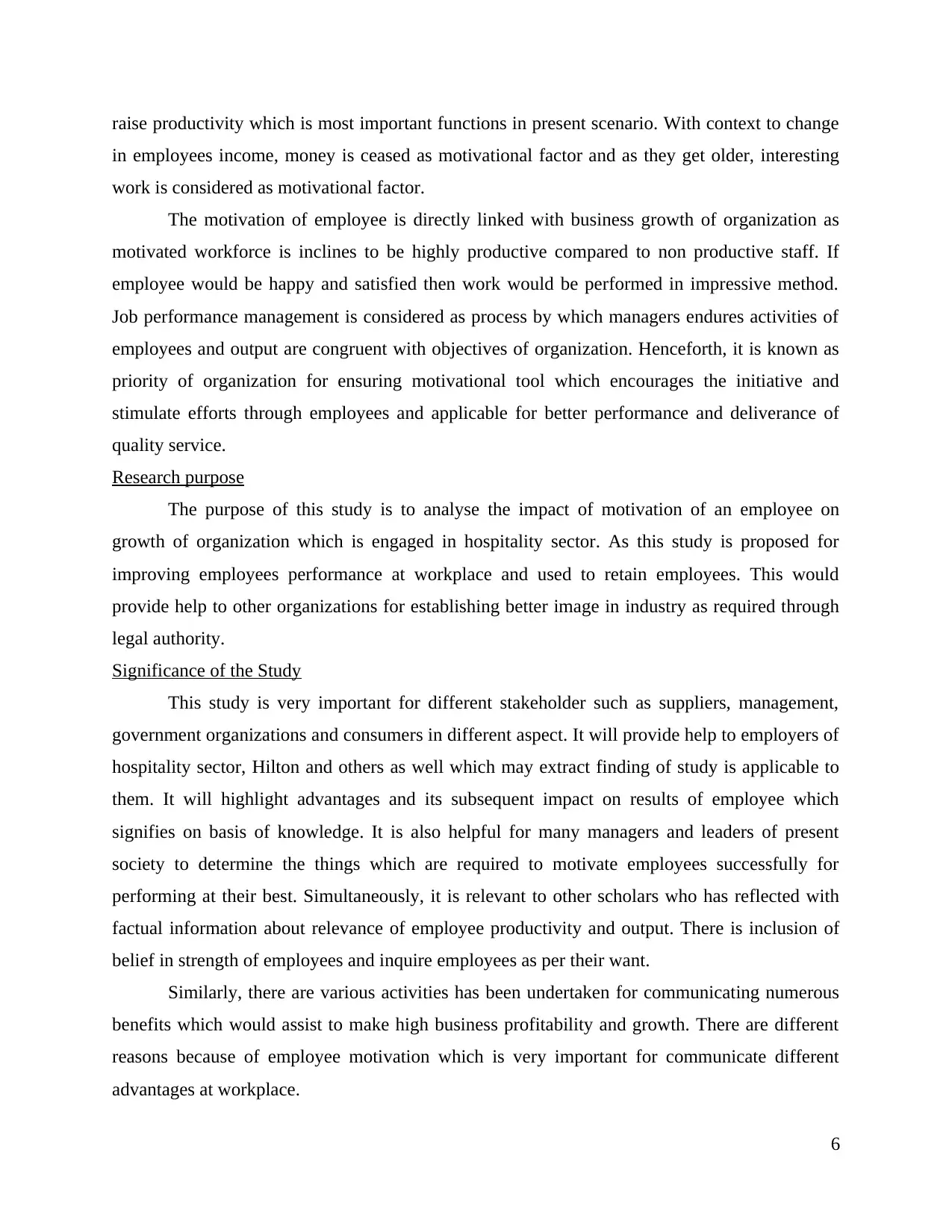
raise productivity which is most important functions in present scenario. With context to change
in employees income, money is ceased as motivational factor and as they get older, interesting
work is considered as motivational factor.
The motivation of employee is directly linked with business growth of organization as
motivated workforce is inclines to be highly productive compared to non productive staff. If
employee would be happy and satisfied then work would be performed in impressive method.
Job performance management is considered as process by which managers endures activities of
employees and output are congruent with objectives of organization. Henceforth, it is known as
priority of organization for ensuring motivational tool which encourages the initiative and
stimulate efforts through employees and applicable for better performance and deliverance of
quality service.
Research purpose
The purpose of this study is to analyse the impact of motivation of an employee on
growth of organization which is engaged in hospitality sector. As this study is proposed for
improving employees performance at workplace and used to retain employees. This would
provide help to other organizations for establishing better image in industry as required through
legal authority.
Significance of the Study
This study is very important for different stakeholder such as suppliers, management,
government organizations and consumers in different aspect. It will provide help to employers of
hospitality sector, Hilton and others as well which may extract finding of study is applicable to
them. It will highlight advantages and its subsequent impact on results of employee which
signifies on basis of knowledge. It is also helpful for many managers and leaders of present
society to determine the things which are required to motivate employees successfully for
performing at their best. Simultaneously, it is relevant to other scholars who has reflected with
factual information about relevance of employee productivity and output. There is inclusion of
belief in strength of employees and inquire employees as per their want.
Similarly, there are various activities has been undertaken for communicating numerous
benefits which would assist to make high business profitability and growth. There are different
reasons because of employee motivation which is very important for communicate different
advantages at workplace.
6
in employees income, money is ceased as motivational factor and as they get older, interesting
work is considered as motivational factor.
The motivation of employee is directly linked with business growth of organization as
motivated workforce is inclines to be highly productive compared to non productive staff. If
employee would be happy and satisfied then work would be performed in impressive method.
Job performance management is considered as process by which managers endures activities of
employees and output are congruent with objectives of organization. Henceforth, it is known as
priority of organization for ensuring motivational tool which encourages the initiative and
stimulate efforts through employees and applicable for better performance and deliverance of
quality service.
Research purpose
The purpose of this study is to analyse the impact of motivation of an employee on
growth of organization which is engaged in hospitality sector. As this study is proposed for
improving employees performance at workplace and used to retain employees. This would
provide help to other organizations for establishing better image in industry as required through
legal authority.
Significance of the Study
This study is very important for different stakeholder such as suppliers, management,
government organizations and consumers in different aspect. It will provide help to employers of
hospitality sector, Hilton and others as well which may extract finding of study is applicable to
them. It will highlight advantages and its subsequent impact on results of employee which
signifies on basis of knowledge. It is also helpful for many managers and leaders of present
society to determine the things which are required to motivate employees successfully for
performing at their best. Simultaneously, it is relevant to other scholars who has reflected with
factual information about relevance of employee productivity and output. There is inclusion of
belief in strength of employees and inquire employees as per their want.
Similarly, there are various activities has been undertaken for communicating numerous
benefits which would assist to make high business profitability and growth. There are different
reasons because of employee motivation which is very important for communicate different
advantages at workplace.
6
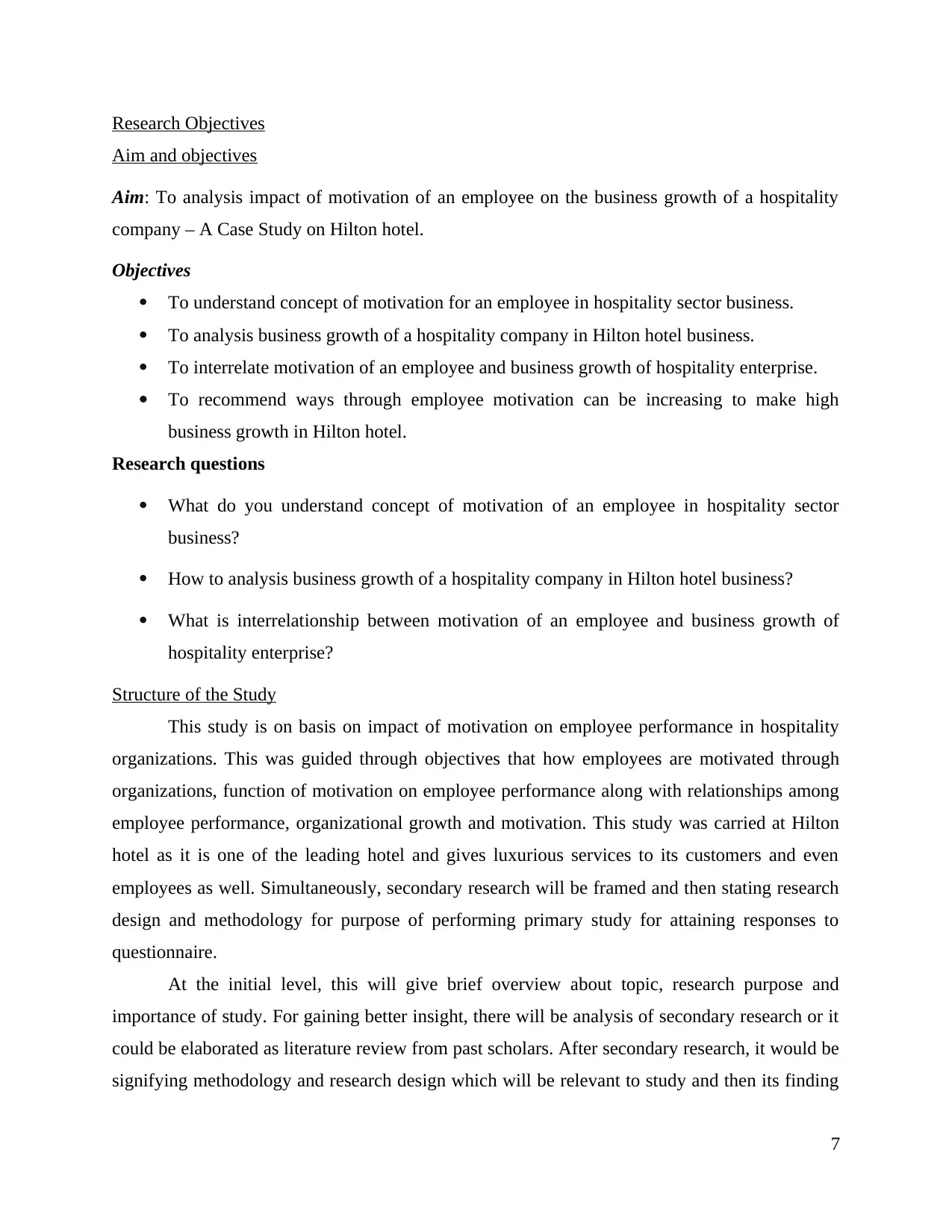
Research Objectives
Aim and objectives
Aim: To analysis impact of motivation of an employee on the business growth of a hospitality
company – A Case Study on Hilton hotel.
Objectives
To understand concept of motivation for an employee in hospitality sector business.
To analysis business growth of a hospitality company in Hilton hotel business.
To interrelate motivation of an employee and business growth of hospitality enterprise.
To recommend ways through employee motivation can be increasing to make high
business growth in Hilton hotel.
Research questions
What do you understand concept of motivation of an employee in hospitality sector
business?
How to analysis business growth of a hospitality company in Hilton hotel business?
What is interrelationship between motivation of an employee and business growth of
hospitality enterprise?
Structure of the Study
This study is on basis on impact of motivation on employee performance in hospitality
organizations. This was guided through objectives that how employees are motivated through
organizations, function of motivation on employee performance along with relationships among
employee performance, organizational growth and motivation. This study was carried at Hilton
hotel as it is one of the leading hotel and gives luxurious services to its customers and even
employees as well. Simultaneously, secondary research will be framed and then stating research
design and methodology for purpose of performing primary study for attaining responses to
questionnaire.
At the initial level, this will give brief overview about topic, research purpose and
importance of study. For gaining better insight, there will be analysis of secondary research or it
could be elaborated as literature review from past scholars. After secondary research, it would be
signifying methodology and research design which will be relevant to study and then its finding
7
Aim and objectives
Aim: To analysis impact of motivation of an employee on the business growth of a hospitality
company – A Case Study on Hilton hotel.
Objectives
To understand concept of motivation for an employee in hospitality sector business.
To analysis business growth of a hospitality company in Hilton hotel business.
To interrelate motivation of an employee and business growth of hospitality enterprise.
To recommend ways through employee motivation can be increasing to make high
business growth in Hilton hotel.
Research questions
What do you understand concept of motivation of an employee in hospitality sector
business?
How to analysis business growth of a hospitality company in Hilton hotel business?
What is interrelationship between motivation of an employee and business growth of
hospitality enterprise?
Structure of the Study
This study is on basis on impact of motivation on employee performance in hospitality
organizations. This was guided through objectives that how employees are motivated through
organizations, function of motivation on employee performance along with relationships among
employee performance, organizational growth and motivation. This study was carried at Hilton
hotel as it is one of the leading hotel and gives luxurious services to its customers and even
employees as well. Simultaneously, secondary research will be framed and then stating research
design and methodology for purpose of performing primary study for attaining responses to
questionnaire.
At the initial level, this will give brief overview about topic, research purpose and
importance of study. For gaining better insight, there will be analysis of secondary research or it
could be elaborated as literature review from past scholars. After secondary research, it would be
signifying methodology and research design which will be relevant to study and then its finding
7
Secure Best Marks with AI Grader
Need help grading? Try our AI Grader for instant feedback on your assignments.
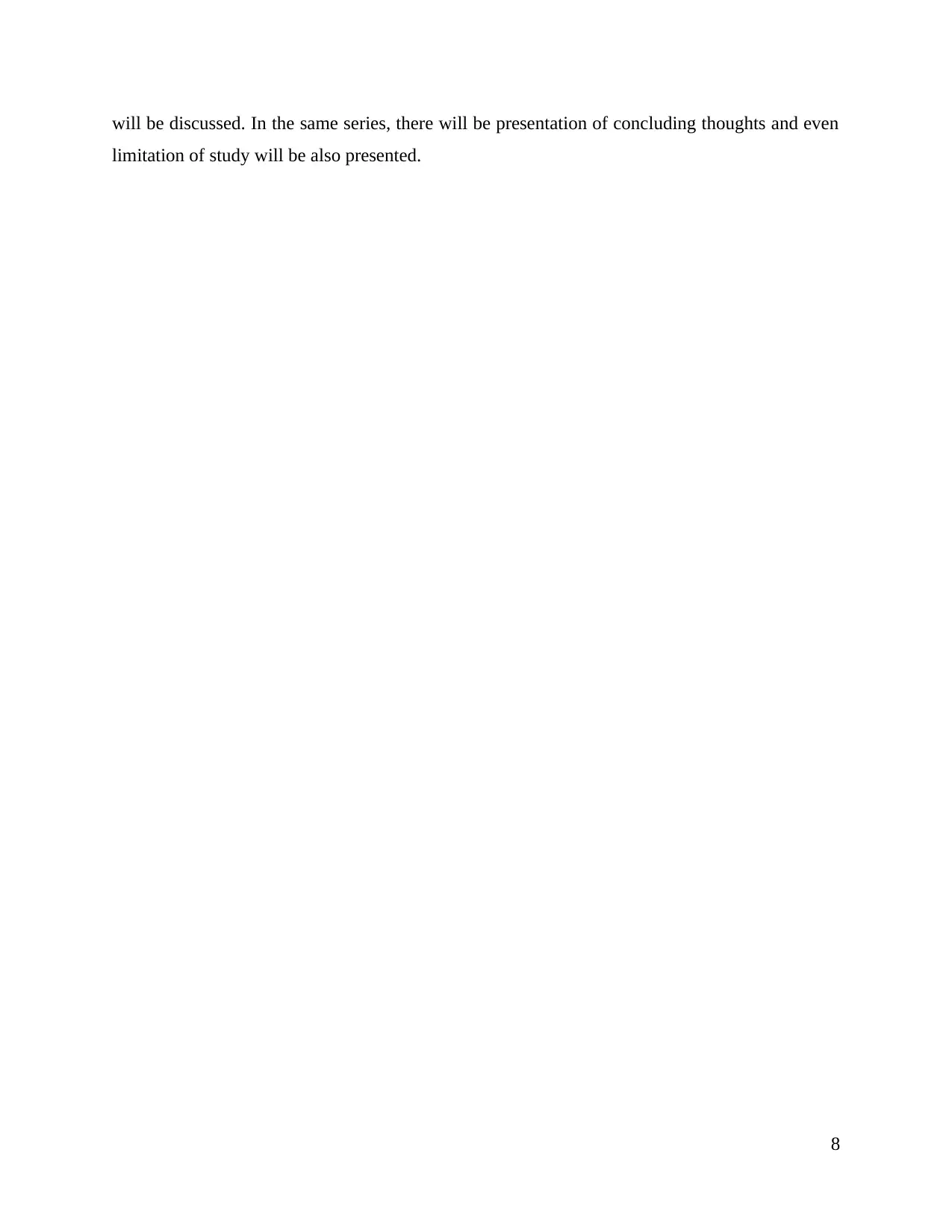
will be discussed. In the same series, there will be presentation of concluding thoughts and even
limitation of study will be also presented.
8
limitation of study will be also presented.
8
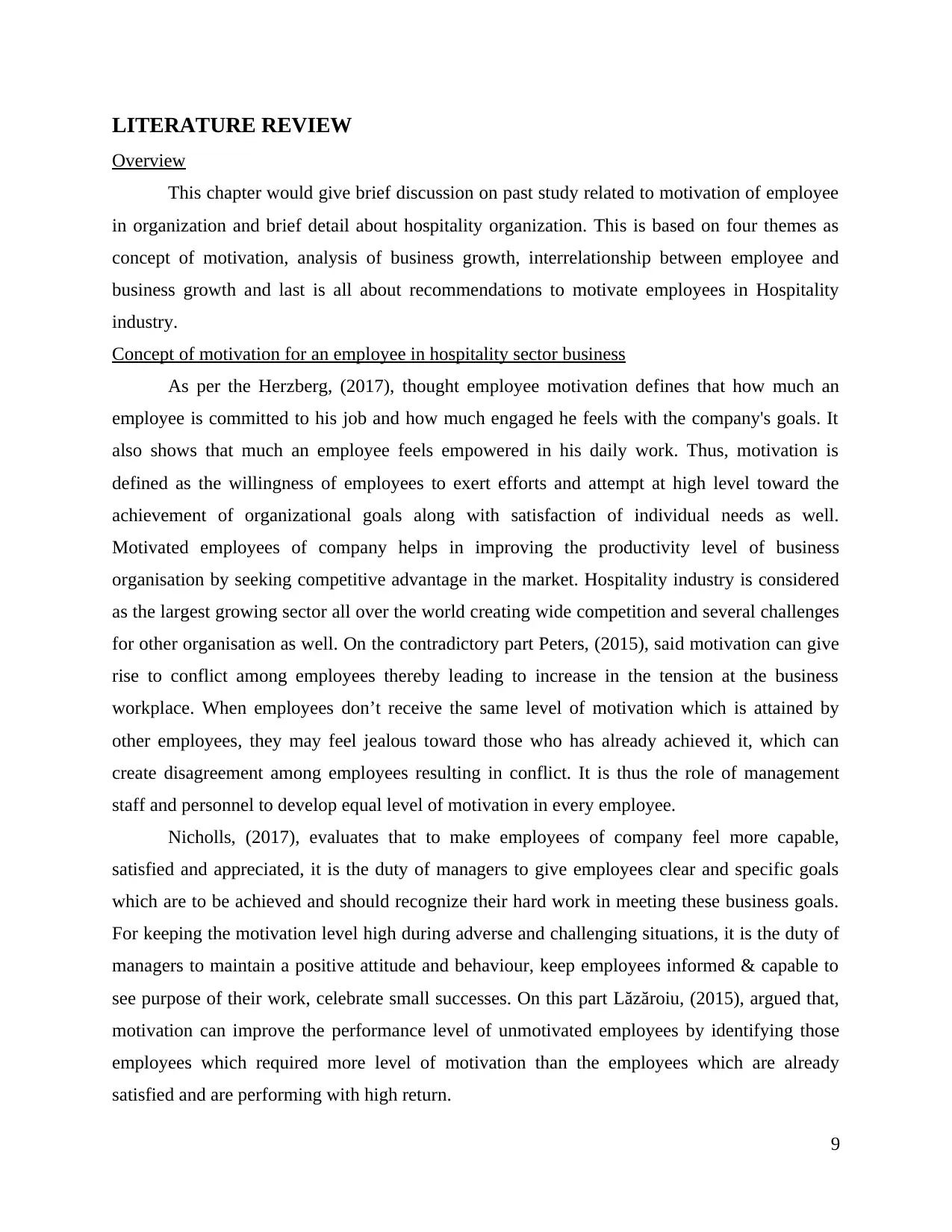
LITERATURE REVIEW
Overview
This chapter would give brief discussion on past study related to motivation of employee
in organization and brief detail about hospitality organization. This is based on four themes as
concept of motivation, analysis of business growth, interrelationship between employee and
business growth and last is all about recommendations to motivate employees in Hospitality
industry.
Concept of motivation for an employee in hospitality sector business
As per the Herzberg, (2017), thought employee motivation defines that how much an
employee is committed to his job and how much engaged he feels with the company's goals. It
also shows that much an employee feels empowered in his daily work. Thus, motivation is
defined as the willingness of employees to exert efforts and attempt at high level toward the
achievement of organizational goals along with satisfaction of individual needs as well.
Motivated employees of company helps in improving the productivity level of business
organisation by seeking competitive advantage in the market. Hospitality industry is considered
as the largest growing sector all over the world creating wide competition and several challenges
for other organisation as well. On the contradictory part Peters, (2015), said motivation can give
rise to conflict among employees thereby leading to increase in the tension at the business
workplace. When employees don’t receive the same level of motivation which is attained by
other employees, they may feel jealous toward those who has already achieved it, which can
create disagreement among employees resulting in conflict. It is thus the role of management
staff and personnel to develop equal level of motivation in every employee.
Nicholls, (2017), evaluates that to make employees of company feel more capable,
satisfied and appreciated, it is the duty of managers to give employees clear and specific goals
which are to be achieved and should recognize their hard work in meeting these business goals.
For keeping the motivation level high during adverse and challenging situations, it is the duty of
managers to maintain a positive attitude and behaviour, keep employees informed & capable to
see purpose of their work, celebrate small successes. On this part Lăzăroiu, (2015), argued that,
motivation can improve the performance level of unmotivated employees by identifying those
employees which required more level of motivation than the employees which are already
satisfied and are performing with high return.
9
Overview
This chapter would give brief discussion on past study related to motivation of employee
in organization and brief detail about hospitality organization. This is based on four themes as
concept of motivation, analysis of business growth, interrelationship between employee and
business growth and last is all about recommendations to motivate employees in Hospitality
industry.
Concept of motivation for an employee in hospitality sector business
As per the Herzberg, (2017), thought employee motivation defines that how much an
employee is committed to his job and how much engaged he feels with the company's goals. It
also shows that much an employee feels empowered in his daily work. Thus, motivation is
defined as the willingness of employees to exert efforts and attempt at high level toward the
achievement of organizational goals along with satisfaction of individual needs as well.
Motivated employees of company helps in improving the productivity level of business
organisation by seeking competitive advantage in the market. Hospitality industry is considered
as the largest growing sector all over the world creating wide competition and several challenges
for other organisation as well. On the contradictory part Peters, (2015), said motivation can give
rise to conflict among employees thereby leading to increase in the tension at the business
workplace. When employees don’t receive the same level of motivation which is attained by
other employees, they may feel jealous toward those who has already achieved it, which can
create disagreement among employees resulting in conflict. It is thus the role of management
staff and personnel to develop equal level of motivation in every employee.
Nicholls, (2017), evaluates that to make employees of company feel more capable,
satisfied and appreciated, it is the duty of managers to give employees clear and specific goals
which are to be achieved and should recognize their hard work in meeting these business goals.
For keeping the motivation level high during adverse and challenging situations, it is the duty of
managers to maintain a positive attitude and behaviour, keep employees informed & capable to
see purpose of their work, celebrate small successes. On this part Lăzăroiu, (2015), argued that,
motivation can improve the performance level of unmotivated employees by identifying those
employees which required more level of motivation than the employees which are already
satisfied and are performing with high return.
9

Graves and Sarkis, (2018), also identifies that by giving the decision-making
responsibility to the employees of company they feel a sense of belongingness in the company
which can lead to raise in the motivation and job satisfaction level. Motivation also helps in
improving the work-life balance of employees. As per the view point of Hitka and Balážová,
2015), due to employee motivation, employees of the company become sometime so focus on
obtaining incentives and bonus that they feel satisfied on reaching or attainment of the set
defined goals and objectives, and don’t even try to achieve far more than the set defined goals.
Some employees target is to achieve more and more incentive rather than focusing on
performing better for making customers and clients satisfied.
Koster, (2017), has assessed that it is responsibility of human resource managers to
maximise the level of motivation among the employees of the company which thereby assists in
accomplishment of the organisational goals and objectives along with the individual employees
goals and objectives. Business organisation like hospitality sector can survive on the motivated
employees performance which is defined as the accumulation of different processes thereby
influencing the direct behaviour for accomplishment of specific business goals. Against this
Mamycheva and et.al., (2016), has stated that, motivation among employees of the company
results in making the person to behave in some specific as well as some goal-oriented manner.
Employee only emphasizes on attaining its own personal goals and objectives which has been set
by employee himself. This includes growth in position, increment in salary, promotion etc. This
hampers the overall organisational goals and objectives up to a certain level.
As per the view point of Casey and Sieber, (2016), motivation on the internal basis helps
employees in focusing on work in which they have interest and thus can brings satisfaction
among them so as to feel better. Also, there is another way of motivating the employees of
Hospitality sector industry is by offering bonus, reward, challenges, incentives etc. It is
considered as the external mode of motivation which assists in improving the performance and
functioning at the workplace. Also it will help in increasing the overall productivity and
profitability of the business organisation engaged in the hospitality sector. On this part
Syaifullah, Titisari and Puspitasari, (2019), has argued that if company is motivating its
employees with the financial rewards like bonuses, incentives, rewards and commissions then
there may be chance that such rewards are of inconsistent nature. If business is operating at small
level and is having high profitability during that year, then it might be able to rewards all of its
10
responsibility to the employees of company they feel a sense of belongingness in the company
which can lead to raise in the motivation and job satisfaction level. Motivation also helps in
improving the work-life balance of employees. As per the view point of Hitka and Balážová,
2015), due to employee motivation, employees of the company become sometime so focus on
obtaining incentives and bonus that they feel satisfied on reaching or attainment of the set
defined goals and objectives, and don’t even try to achieve far more than the set defined goals.
Some employees target is to achieve more and more incentive rather than focusing on
performing better for making customers and clients satisfied.
Koster, (2017), has assessed that it is responsibility of human resource managers to
maximise the level of motivation among the employees of the company which thereby assists in
accomplishment of the organisational goals and objectives along with the individual employees
goals and objectives. Business organisation like hospitality sector can survive on the motivated
employees performance which is defined as the accumulation of different processes thereby
influencing the direct behaviour for accomplishment of specific business goals. Against this
Mamycheva and et.al., (2016), has stated that, motivation among employees of the company
results in making the person to behave in some specific as well as some goal-oriented manner.
Employee only emphasizes on attaining its own personal goals and objectives which has been set
by employee himself. This includes growth in position, increment in salary, promotion etc. This
hampers the overall organisational goals and objectives up to a certain level.
As per the view point of Casey and Sieber, (2016), motivation on the internal basis helps
employees in focusing on work in which they have interest and thus can brings satisfaction
among them so as to feel better. Also, there is another way of motivating the employees of
Hospitality sector industry is by offering bonus, reward, challenges, incentives etc. It is
considered as the external mode of motivation which assists in improving the performance and
functioning at the workplace. Also it will help in increasing the overall productivity and
profitability of the business organisation engaged in the hospitality sector. On this part
Syaifullah, Titisari and Puspitasari, (2019), has argued that if company is motivating its
employees with the financial rewards like bonuses, incentives, rewards and commissions then
there may be chance that such rewards are of inconsistent nature. If business is operating at small
level and is having high profitability during that year, then it might be able to rewards all of its
10
Paraphrase This Document
Need a fresh take? Get an instant paraphrase of this document with our AI Paraphraser
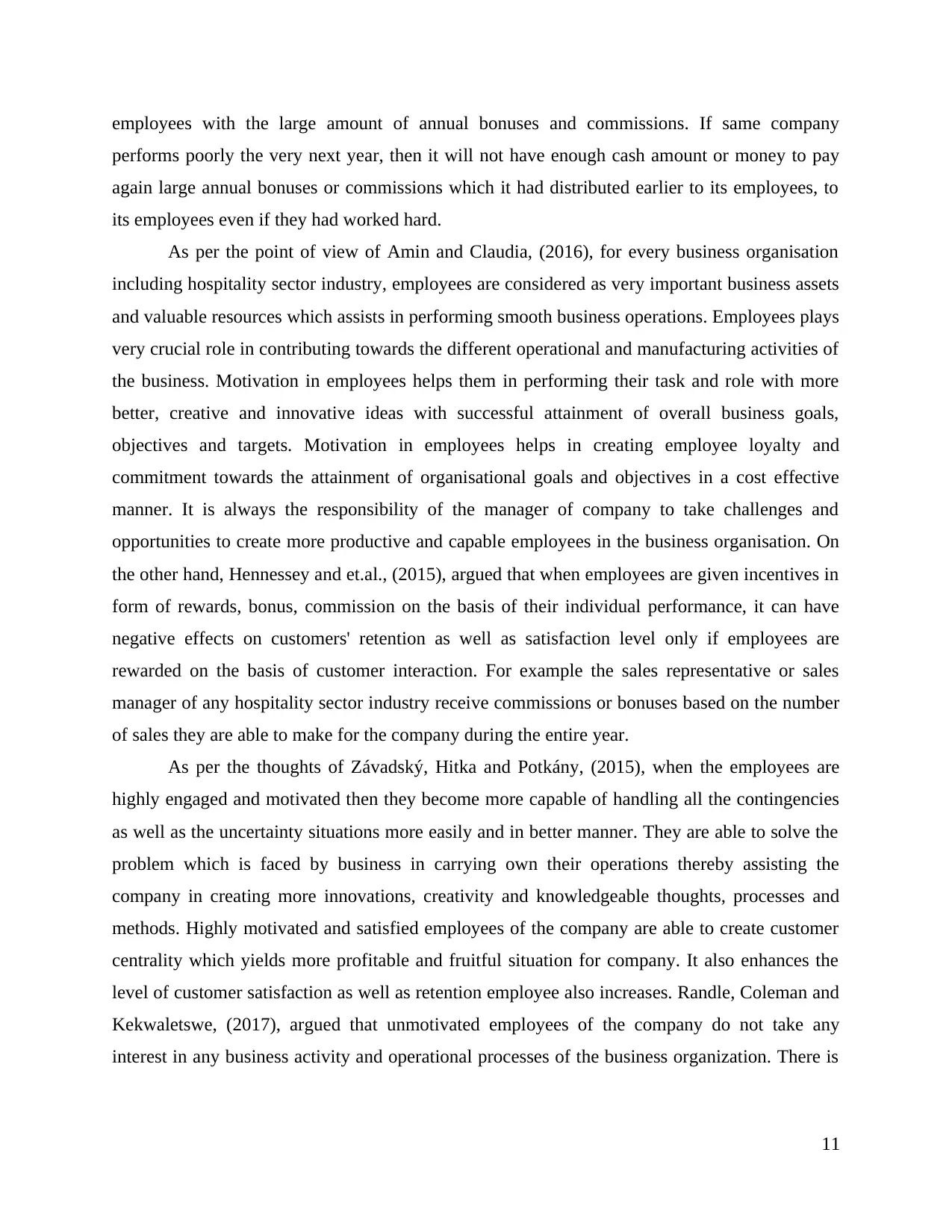
employees with the large amount of annual bonuses and commissions. If same company
performs poorly the very next year, then it will not have enough cash amount or money to pay
again large annual bonuses or commissions which it had distributed earlier to its employees, to
its employees even if they had worked hard.
As per the point of view of Amin and Claudia, (2016), for every business organisation
including hospitality sector industry, employees are considered as very important business assets
and valuable resources which assists in performing smooth business operations. Employees plays
very crucial role in contributing towards the different operational and manufacturing activities of
the business. Motivation in employees helps them in performing their task and role with more
better, creative and innovative ideas with successful attainment of overall business goals,
objectives and targets. Motivation in employees helps in creating employee loyalty and
commitment towards the attainment of organisational goals and objectives in a cost effective
manner. It is always the responsibility of the manager of company to take challenges and
opportunities to create more productive and capable employees in the business organisation. On
the other hand, Hennessey and et.al., (2015), argued that when employees are given incentives in
form of rewards, bonus, commission on the basis of their individual performance, it can have
negative effects on customers' retention as well as satisfaction level only if employees are
rewarded on the basis of customer interaction. For example the sales representative or sales
manager of any hospitality sector industry receive commissions or bonuses based on the number
of sales they are able to make for the company during the entire year.
As per the thoughts of Závadský, Hitka and Potkány, (2015), when the employees are
highly engaged and motivated then they become more capable of handling all the contingencies
as well as the uncertainty situations more easily and in better manner. They are able to solve the
problem which is faced by business in carrying own their operations thereby assisting the
company in creating more innovations, creativity and knowledgeable thoughts, processes and
methods. Highly motivated and satisfied employees of the company are able to create customer
centrality which yields more profitable and fruitful situation for company. It also enhances the
level of customer satisfaction as well as retention employee also increases. Randle, Coleman and
Kekwaletswe, (2017), argued that unmotivated employees of the company do not take any
interest in any business activity and operational processes of the business organization. There is
11
performs poorly the very next year, then it will not have enough cash amount or money to pay
again large annual bonuses or commissions which it had distributed earlier to its employees, to
its employees even if they had worked hard.
As per the point of view of Amin and Claudia, (2016), for every business organisation
including hospitality sector industry, employees are considered as very important business assets
and valuable resources which assists in performing smooth business operations. Employees plays
very crucial role in contributing towards the different operational and manufacturing activities of
the business. Motivation in employees helps them in performing their task and role with more
better, creative and innovative ideas with successful attainment of overall business goals,
objectives and targets. Motivation in employees helps in creating employee loyalty and
commitment towards the attainment of organisational goals and objectives in a cost effective
manner. It is always the responsibility of the manager of company to take challenges and
opportunities to create more productive and capable employees in the business organisation. On
the other hand, Hennessey and et.al., (2015), argued that when employees are given incentives in
form of rewards, bonus, commission on the basis of their individual performance, it can have
negative effects on customers' retention as well as satisfaction level only if employees are
rewarded on the basis of customer interaction. For example the sales representative or sales
manager of any hospitality sector industry receive commissions or bonuses based on the number
of sales they are able to make for the company during the entire year.
As per the thoughts of Závadský, Hitka and Potkány, (2015), when the employees are
highly engaged and motivated then they become more capable of handling all the contingencies
as well as the uncertainty situations more easily and in better manner. They are able to solve the
problem which is faced by business in carrying own their operations thereby assisting the
company in creating more innovations, creativity and knowledgeable thoughts, processes and
methods. Highly motivated and satisfied employees of the company are able to create customer
centrality which yields more profitable and fruitful situation for company. It also enhances the
level of customer satisfaction as well as retention employee also increases. Randle, Coleman and
Kekwaletswe, (2017), argued that unmotivated employees of the company do not take any
interest in any business activity and operational processes of the business organization. There is
11
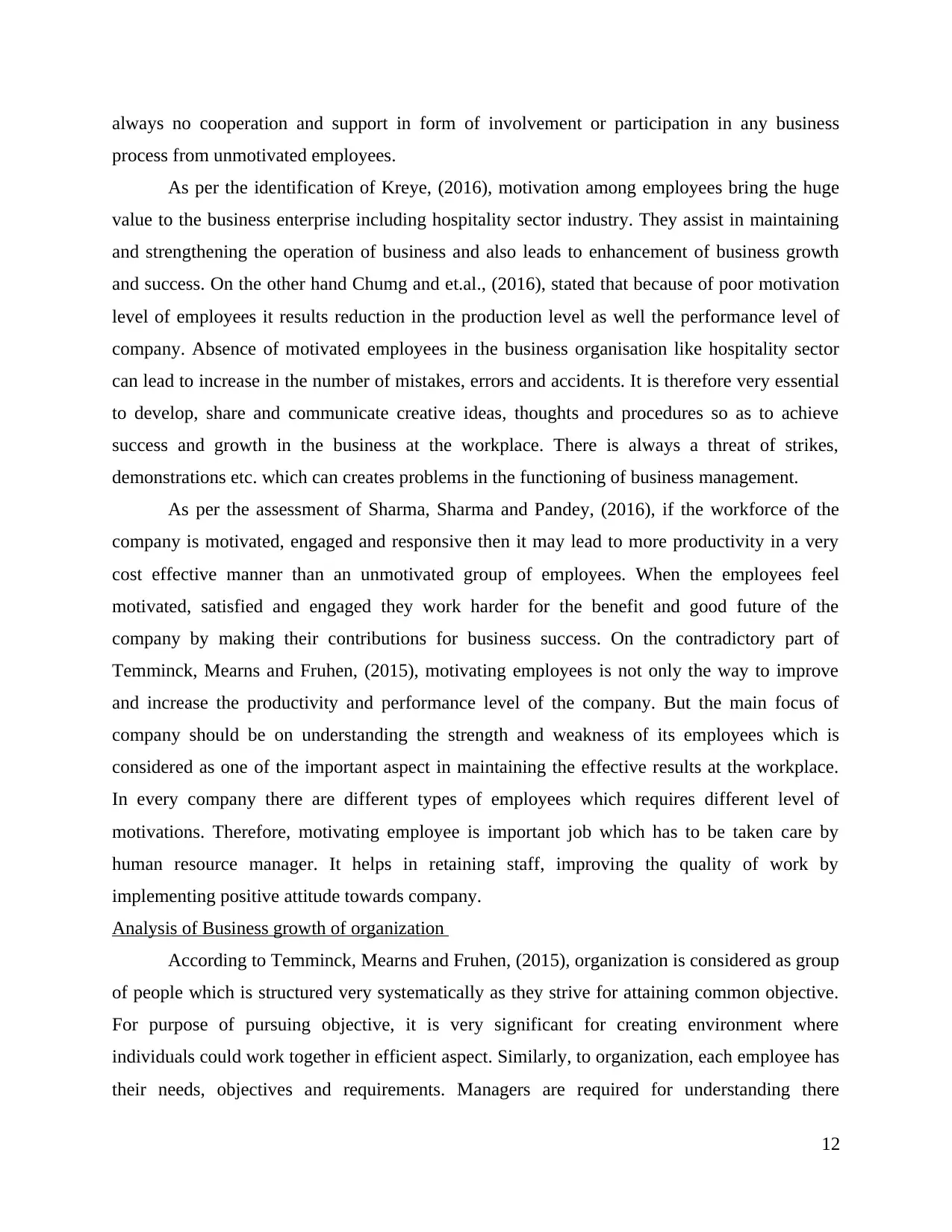
always no cooperation and support in form of involvement or participation in any business
process from unmotivated employees.
As per the identification of Kreye, (2016), motivation among employees bring the huge
value to the business enterprise including hospitality sector industry. They assist in maintaining
and strengthening the operation of business and also leads to enhancement of business growth
and success. On the other hand Chumg and et.al., (2016), stated that because of poor motivation
level of employees it results reduction in the production level as well the performance level of
company. Absence of motivated employees in the business organisation like hospitality sector
can lead to increase in the number of mistakes, errors and accidents. It is therefore very essential
to develop, share and communicate creative ideas, thoughts and procedures so as to achieve
success and growth in the business at the workplace. There is always a threat of strikes,
demonstrations etc. which can creates problems in the functioning of business management.
As per the assessment of Sharma, Sharma and Pandey, (2016), if the workforce of the
company is motivated, engaged and responsive then it may lead to more productivity in a very
cost effective manner than an unmotivated group of employees. When the employees feel
motivated, satisfied and engaged they work harder for the benefit and good future of the
company by making their contributions for business success. On the contradictory part of
Temminck, Mearns and Fruhen, (2015), motivating employees is not only the way to improve
and increase the productivity and performance level of the company. But the main focus of
company should be on understanding the strength and weakness of its employees which is
considered as one of the important aspect in maintaining the effective results at the workplace.
In every company there are different types of employees which requires different level of
motivations. Therefore, motivating employee is important job which has to be taken care by
human resource manager. It helps in retaining staff, improving the quality of work by
implementing positive attitude towards company.
Analysis of Business growth of organization
According to Temminck, Mearns and Fruhen, (2015), organization is considered as group
of people which is structured very systematically as they strive for attaining common objective.
For purpose of pursuing objective, it is very significant for creating environment where
individuals could work together in efficient aspect. Similarly, to organization, each employee has
their needs, objectives and requirements. Managers are required for understanding there
12
process from unmotivated employees.
As per the identification of Kreye, (2016), motivation among employees bring the huge
value to the business enterprise including hospitality sector industry. They assist in maintaining
and strengthening the operation of business and also leads to enhancement of business growth
and success. On the other hand Chumg and et.al., (2016), stated that because of poor motivation
level of employees it results reduction in the production level as well the performance level of
company. Absence of motivated employees in the business organisation like hospitality sector
can lead to increase in the number of mistakes, errors and accidents. It is therefore very essential
to develop, share and communicate creative ideas, thoughts and procedures so as to achieve
success and growth in the business at the workplace. There is always a threat of strikes,
demonstrations etc. which can creates problems in the functioning of business management.
As per the assessment of Sharma, Sharma and Pandey, (2016), if the workforce of the
company is motivated, engaged and responsive then it may lead to more productivity in a very
cost effective manner than an unmotivated group of employees. When the employees feel
motivated, satisfied and engaged they work harder for the benefit and good future of the
company by making their contributions for business success. On the contradictory part of
Temminck, Mearns and Fruhen, (2015), motivating employees is not only the way to improve
and increase the productivity and performance level of the company. But the main focus of
company should be on understanding the strength and weakness of its employees which is
considered as one of the important aspect in maintaining the effective results at the workplace.
In every company there are different types of employees which requires different level of
motivations. Therefore, motivating employee is important job which has to be taken care by
human resource manager. It helps in retaining staff, improving the quality of work by
implementing positive attitude towards company.
Analysis of Business growth of organization
According to Temminck, Mearns and Fruhen, (2015), organization is considered as group
of people which is structured very systematically as they strive for attaining common objective.
For purpose of pursuing objective, it is very significant for creating environment where
individuals could work together in efficient aspect. Similarly, to organization, each employee has
their needs, objectives and requirements. Managers are required for understanding there
12
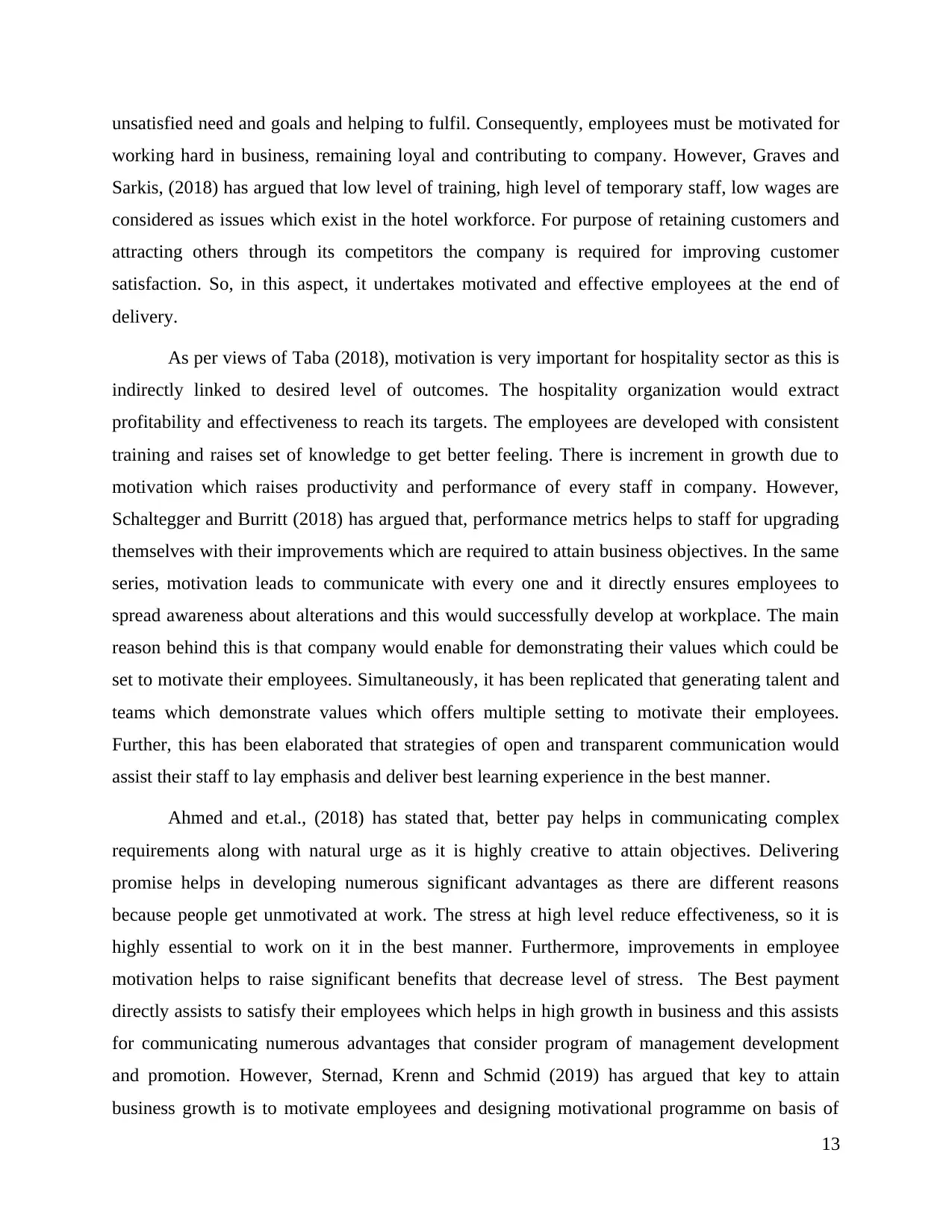
unsatisfied need and goals and helping to fulfil. Consequently, employees must be motivated for
working hard in business, remaining loyal and contributing to company. However, Graves and
Sarkis, (2018) has argued that low level of training, high level of temporary staff, low wages are
considered as issues which exist in the hotel workforce. For purpose of retaining customers and
attracting others through its competitors the company is required for improving customer
satisfaction. So, in this aspect, it undertakes motivated and effective employees at the end of
delivery.
As per views of Taba (2018), motivation is very important for hospitality sector as this is
indirectly linked to desired level of outcomes. The hospitality organization would extract
profitability and effectiveness to reach its targets. The employees are developed with consistent
training and raises set of knowledge to get better feeling. There is increment in growth due to
motivation which raises productivity and performance of every staff in company. However,
Schaltegger and Burritt (2018) has argued that, performance metrics helps to staff for upgrading
themselves with their improvements which are required to attain business objectives. In the same
series, motivation leads to communicate with every one and it directly ensures employees to
spread awareness about alterations and this would successfully develop at workplace. The main
reason behind this is that company would enable for demonstrating their values which could be
set to motivate their employees. Simultaneously, it has been replicated that generating talent and
teams which demonstrate values which offers multiple setting to motivate their employees.
Further, this has been elaborated that strategies of open and transparent communication would
assist their staff to lay emphasis and deliver best learning experience in the best manner.
Ahmed and et.al., (2018) has stated that, better pay helps in communicating complex
requirements along with natural urge as it is highly creative to attain objectives. Delivering
promise helps in developing numerous significant advantages as there are different reasons
because people get unmotivated at work. The stress at high level reduce effectiveness, so it is
highly essential to work on it in the best manner. Furthermore, improvements in employee
motivation helps to raise significant benefits that decrease level of stress. The Best payment
directly assists to satisfy their employees which helps in high growth in business and this assists
for communicating numerous advantages that consider program of management development
and promotion. However, Sternad, Krenn and Schmid (2019) has argued that key to attain
business growth is to motivate employees and designing motivational programme on basis of
13
working hard in business, remaining loyal and contributing to company. However, Graves and
Sarkis, (2018) has argued that low level of training, high level of temporary staff, low wages are
considered as issues which exist in the hotel workforce. For purpose of retaining customers and
attracting others through its competitors the company is required for improving customer
satisfaction. So, in this aspect, it undertakes motivated and effective employees at the end of
delivery.
As per views of Taba (2018), motivation is very important for hospitality sector as this is
indirectly linked to desired level of outcomes. The hospitality organization would extract
profitability and effectiveness to reach its targets. The employees are developed with consistent
training and raises set of knowledge to get better feeling. There is increment in growth due to
motivation which raises productivity and performance of every staff in company. However,
Schaltegger and Burritt (2018) has argued that, performance metrics helps to staff for upgrading
themselves with their improvements which are required to attain business objectives. In the same
series, motivation leads to communicate with every one and it directly ensures employees to
spread awareness about alterations and this would successfully develop at workplace. The main
reason behind this is that company would enable for demonstrating their values which could be
set to motivate their employees. Simultaneously, it has been replicated that generating talent and
teams which demonstrate values which offers multiple setting to motivate their employees.
Further, this has been elaborated that strategies of open and transparent communication would
assist their staff to lay emphasis and deliver best learning experience in the best manner.
Ahmed and et.al., (2018) has stated that, better pay helps in communicating complex
requirements along with natural urge as it is highly creative to attain objectives. Delivering
promise helps in developing numerous significant advantages as there are different reasons
because people get unmotivated at work. The stress at high level reduce effectiveness, so it is
highly essential to work on it in the best manner. Furthermore, improvements in employee
motivation helps to raise significant benefits that decrease level of stress. The Best payment
directly assists to satisfy their employees which helps in high growth in business and this assists
for communicating numerous advantages that consider program of management development
and promotion. However, Sternad, Krenn and Schmid (2019) has argued that key to attain
business growth is to motivate employees and designing motivational programme on basis of
13
Secure Best Marks with AI Grader
Need help grading? Try our AI Grader for instant feedback on your assignments.
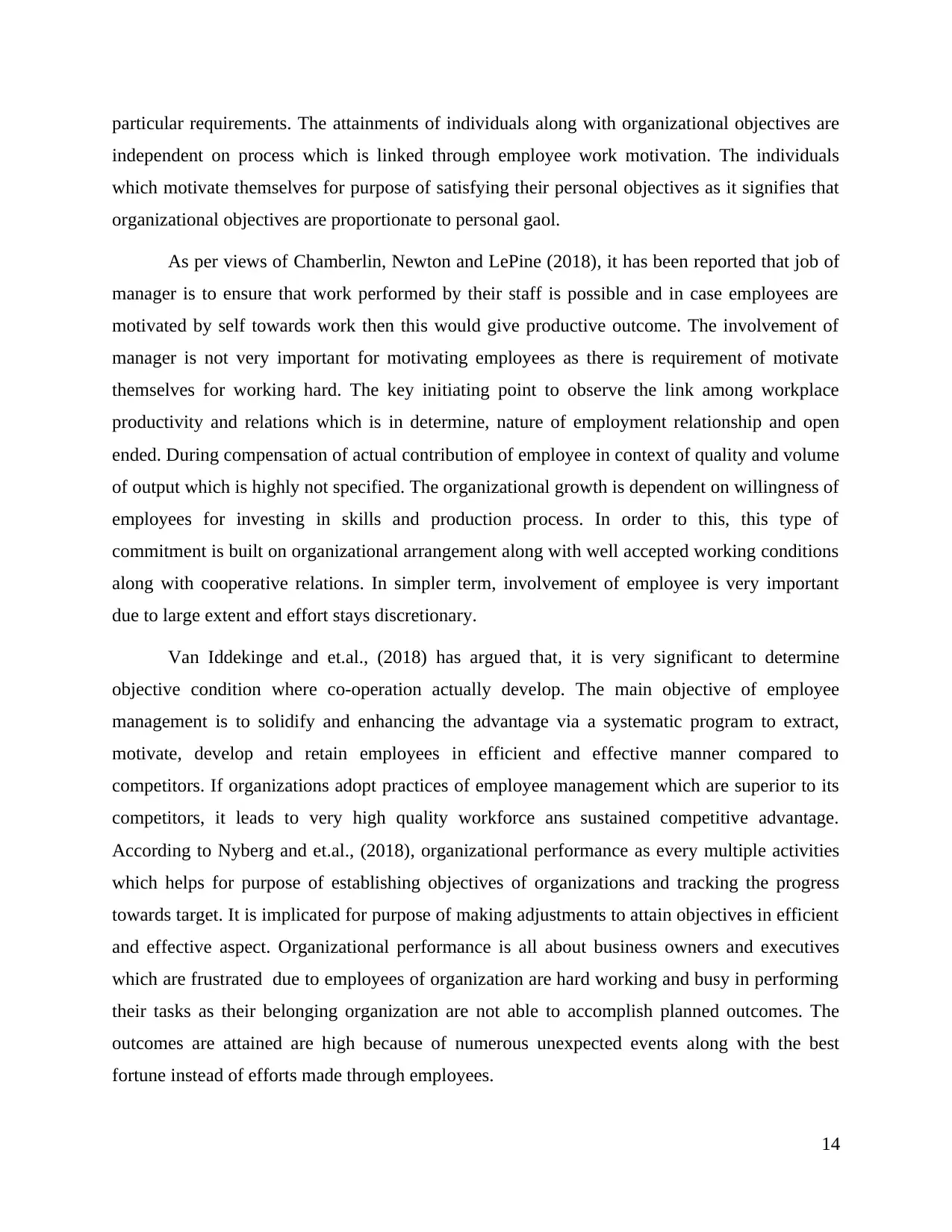
particular requirements. The attainments of individuals along with organizational objectives are
independent on process which is linked through employee work motivation. The individuals
which motivate themselves for purpose of satisfying their personal objectives as it signifies that
organizational objectives are proportionate to personal gaol.
As per views of Chamberlin, Newton and LePine (2018), it has been reported that job of
manager is to ensure that work performed by their staff is possible and in case employees are
motivated by self towards work then this would give productive outcome. The involvement of
manager is not very important for motivating employees as there is requirement of motivate
themselves for working hard. The key initiating point to observe the link among workplace
productivity and relations which is in determine, nature of employment relationship and open
ended. During compensation of actual contribution of employee in context of quality and volume
of output which is highly not specified. The organizational growth is dependent on willingness of
employees for investing in skills and production process. In order to this, this type of
commitment is built on organizational arrangement along with well accepted working conditions
along with cooperative relations. In simpler term, involvement of employee is very important
due to large extent and effort stays discretionary.
Van Iddekinge and et.al., (2018) has argued that, it is very significant to determine
objective condition where co-operation actually develop. The main objective of employee
management is to solidify and enhancing the advantage via a systematic program to extract,
motivate, develop and retain employees in efficient and effective manner compared to
competitors. If organizations adopt practices of employee management which are superior to its
competitors, it leads to very high quality workforce ans sustained competitive advantage.
According to Nyberg and et.al., (2018), organizational performance as every multiple activities
which helps for purpose of establishing objectives of organizations and tracking the progress
towards target. It is implicated for purpose of making adjustments to attain objectives in efficient
and effective aspect. Organizational performance is all about business owners and executives
which are frustrated due to employees of organization are hard working and busy in performing
their tasks as their belonging organization are not able to accomplish planned outcomes. The
outcomes are attained are high because of numerous unexpected events along with the best
fortune instead of efforts made through employees.
14
independent on process which is linked through employee work motivation. The individuals
which motivate themselves for purpose of satisfying their personal objectives as it signifies that
organizational objectives are proportionate to personal gaol.
As per views of Chamberlin, Newton and LePine (2018), it has been reported that job of
manager is to ensure that work performed by their staff is possible and in case employees are
motivated by self towards work then this would give productive outcome. The involvement of
manager is not very important for motivating employees as there is requirement of motivate
themselves for working hard. The key initiating point to observe the link among workplace
productivity and relations which is in determine, nature of employment relationship and open
ended. During compensation of actual contribution of employee in context of quality and volume
of output which is highly not specified. The organizational growth is dependent on willingness of
employees for investing in skills and production process. In order to this, this type of
commitment is built on organizational arrangement along with well accepted working conditions
along with cooperative relations. In simpler term, involvement of employee is very important
due to large extent and effort stays discretionary.
Van Iddekinge and et.al., (2018) has argued that, it is very significant to determine
objective condition where co-operation actually develop. The main objective of employee
management is to solidify and enhancing the advantage via a systematic program to extract,
motivate, develop and retain employees in efficient and effective manner compared to
competitors. If organizations adopt practices of employee management which are superior to its
competitors, it leads to very high quality workforce ans sustained competitive advantage.
According to Nyberg and et.al., (2018), organizational performance as every multiple activities
which helps for purpose of establishing objectives of organizations and tracking the progress
towards target. It is implicated for purpose of making adjustments to attain objectives in efficient
and effective aspect. Organizational performance is all about business owners and executives
which are frustrated due to employees of organization are hard working and busy in performing
their tasks as their belonging organization are not able to accomplish planned outcomes. The
outcomes are attained are high because of numerous unexpected events along with the best
fortune instead of efforts made through employees.
14
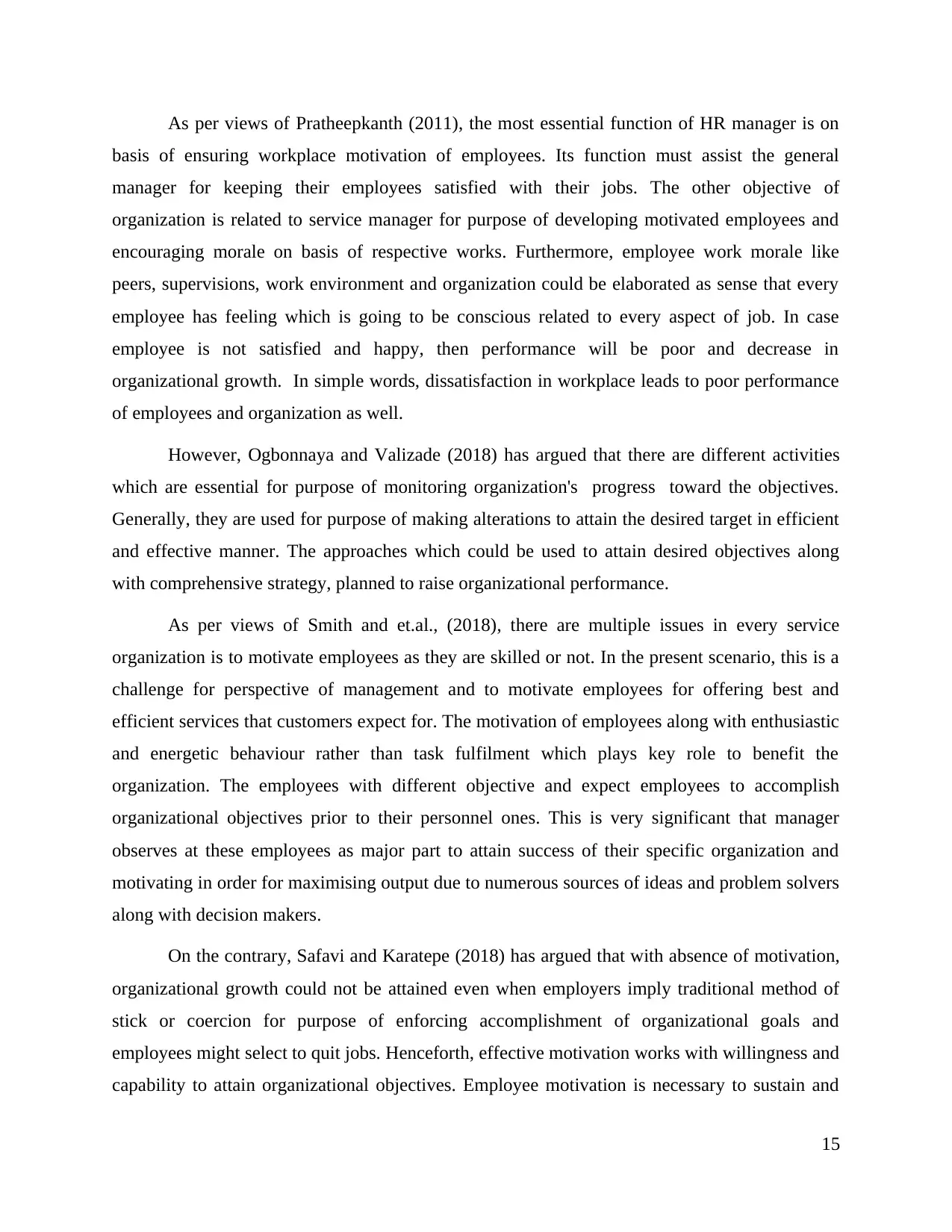
As per views of Pratheepkanth (2011), the most essential function of HR manager is on
basis of ensuring workplace motivation of employees. Its function must assist the general
manager for keeping their employees satisfied with their jobs. The other objective of
organization is related to service manager for purpose of developing motivated employees and
encouraging morale on basis of respective works. Furthermore, employee work morale like
peers, supervisions, work environment and organization could be elaborated as sense that every
employee has feeling which is going to be conscious related to every aspect of job. In case
employee is not satisfied and happy, then performance will be poor and decrease in
organizational growth. In simple words, dissatisfaction in workplace leads to poor performance
of employees and organization as well.
However, Ogbonnaya and Valizade (2018) has argued that there are different activities
which are essential for purpose of monitoring organization's progress toward the objectives.
Generally, they are used for purpose of making alterations to attain the desired target in efficient
and effective manner. The approaches which could be used to attain desired objectives along
with comprehensive strategy, planned to raise organizational performance.
As per views of Smith and et.al., (2018), there are multiple issues in every service
organization is to motivate employees as they are skilled or not. In the present scenario, this is a
challenge for perspective of management and to motivate employees for offering best and
efficient services that customers expect for. The motivation of employees along with enthusiastic
and energetic behaviour rather than task fulfilment which plays key role to benefit the
organization. The employees with different objective and expect employees to accomplish
organizational objectives prior to their personnel ones. This is very significant that manager
observes at these employees as major part to attain success of their specific organization and
motivating in order for maximising output due to numerous sources of ideas and problem solvers
along with decision makers.
On the contrary, Safavi and Karatepe (2018) has argued that with absence of motivation,
organizational growth could not be attained even when employers imply traditional method of
stick or coercion for purpose of enforcing accomplishment of organizational goals and
employees might select to quit jobs. Henceforth, effective motivation works with willingness and
capability to attain organizational objectives. Employee motivation is necessary to sustain and
15
basis of ensuring workplace motivation of employees. Its function must assist the general
manager for keeping their employees satisfied with their jobs. The other objective of
organization is related to service manager for purpose of developing motivated employees and
encouraging morale on basis of respective works. Furthermore, employee work morale like
peers, supervisions, work environment and organization could be elaborated as sense that every
employee has feeling which is going to be conscious related to every aspect of job. In case
employee is not satisfied and happy, then performance will be poor and decrease in
organizational growth. In simple words, dissatisfaction in workplace leads to poor performance
of employees and organization as well.
However, Ogbonnaya and Valizade (2018) has argued that there are different activities
which are essential for purpose of monitoring organization's progress toward the objectives.
Generally, they are used for purpose of making alterations to attain the desired target in efficient
and effective manner. The approaches which could be used to attain desired objectives along
with comprehensive strategy, planned to raise organizational performance.
As per views of Smith and et.al., (2018), there are multiple issues in every service
organization is to motivate employees as they are skilled or not. In the present scenario, this is a
challenge for perspective of management and to motivate employees for offering best and
efficient services that customers expect for. The motivation of employees along with enthusiastic
and energetic behaviour rather than task fulfilment which plays key role to benefit the
organization. The employees with different objective and expect employees to accomplish
organizational objectives prior to their personnel ones. This is very significant that manager
observes at these employees as major part to attain success of their specific organization and
motivating in order for maximising output due to numerous sources of ideas and problem solvers
along with decision makers.
On the contrary, Safavi and Karatepe (2018) has argued that with absence of motivation,
organizational growth could not be attained even when employers imply traditional method of
stick or coercion for purpose of enforcing accomplishment of organizational goals and
employees might select to quit jobs. Henceforth, effective motivation works with willingness and
capability to attain organizational objectives. Employee motivation is necessary to sustain and
15
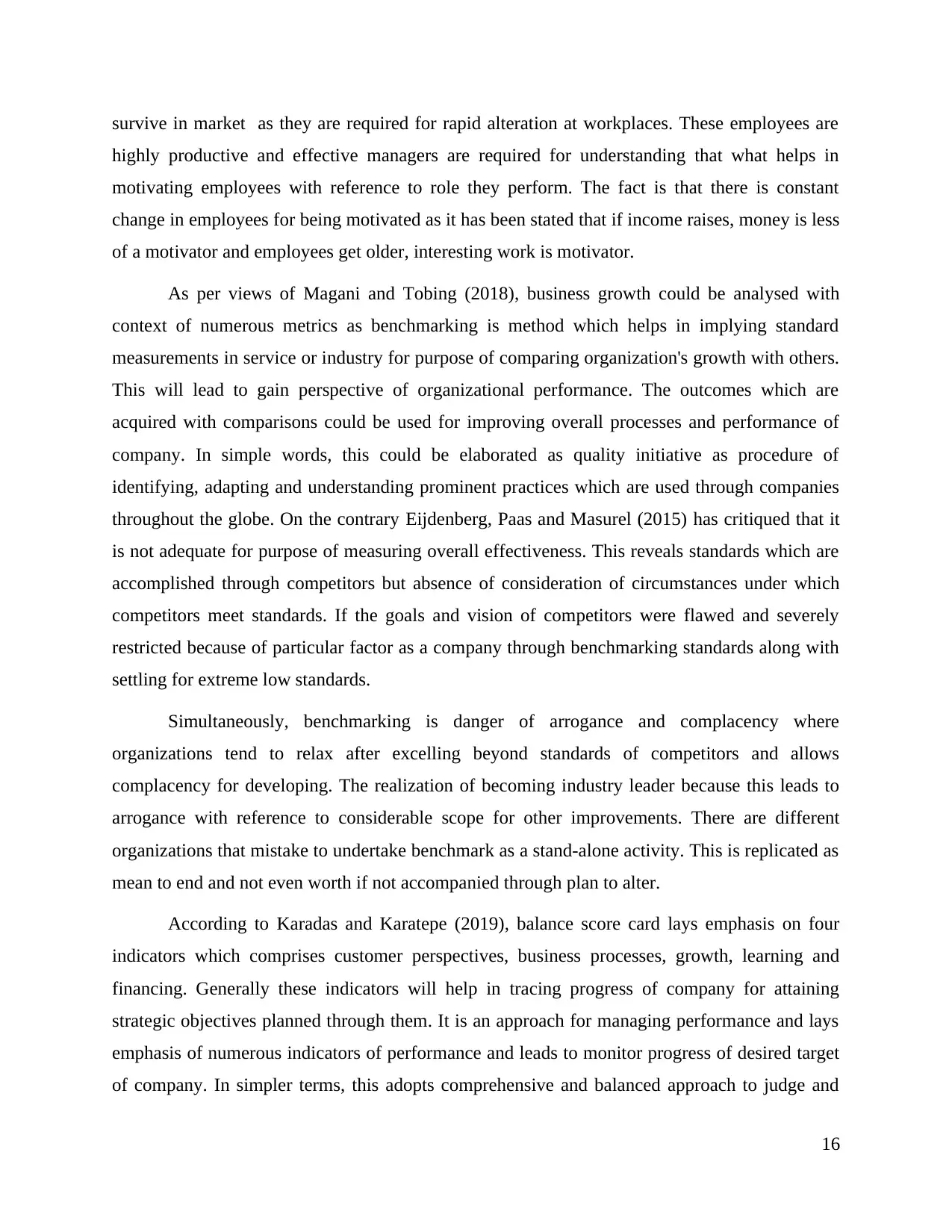
survive in market as they are required for rapid alteration at workplaces. These employees are
highly productive and effective managers are required for understanding that what helps in
motivating employees with reference to role they perform. The fact is that there is constant
change in employees for being motivated as it has been stated that if income raises, money is less
of a motivator and employees get older, interesting work is motivator.
As per views of Magani and Tobing (2018), business growth could be analysed with
context of numerous metrics as benchmarking is method which helps in implying standard
measurements in service or industry for purpose of comparing organization's growth with others.
This will lead to gain perspective of organizational performance. The outcomes which are
acquired with comparisons could be used for improving overall processes and performance of
company. In simple words, this could be elaborated as quality initiative as procedure of
identifying, adapting and understanding prominent practices which are used through companies
throughout the globe. On the contrary Eijdenberg, Paas and Masurel (2015) has critiqued that it
is not adequate for purpose of measuring overall effectiveness. This reveals standards which are
accomplished through competitors but absence of consideration of circumstances under which
competitors meet standards. If the goals and vision of competitors were flawed and severely
restricted because of particular factor as a company through benchmarking standards along with
settling for extreme low standards.
Simultaneously, benchmarking is danger of arrogance and complacency where
organizations tend to relax after excelling beyond standards of competitors and allows
complacency for developing. The realization of becoming industry leader because this leads to
arrogance with reference to considerable scope for other improvements. There are different
organizations that mistake to undertake benchmark as a stand-alone activity. This is replicated as
mean to end and not even worth if not accompanied through plan to alter.
According to Karadas and Karatepe (2019), balance score card lays emphasis on four
indicators which comprises customer perspectives, business processes, growth, learning and
financing. Generally these indicators will help in tracing progress of company for attaining
strategic objectives planned through them. It is an approach for managing performance and lays
emphasis of numerous indicators of performance and leads to monitor progress of desired target
of company. In simpler terms, this adopts comprehensive and balanced approach to judge and
16
highly productive and effective managers are required for understanding that what helps in
motivating employees with reference to role they perform. The fact is that there is constant
change in employees for being motivated as it has been stated that if income raises, money is less
of a motivator and employees get older, interesting work is motivator.
As per views of Magani and Tobing (2018), business growth could be analysed with
context of numerous metrics as benchmarking is method which helps in implying standard
measurements in service or industry for purpose of comparing organization's growth with others.
This will lead to gain perspective of organizational performance. The outcomes which are
acquired with comparisons could be used for improving overall processes and performance of
company. In simple words, this could be elaborated as quality initiative as procedure of
identifying, adapting and understanding prominent practices which are used through companies
throughout the globe. On the contrary Eijdenberg, Paas and Masurel (2015) has critiqued that it
is not adequate for purpose of measuring overall effectiveness. This reveals standards which are
accomplished through competitors but absence of consideration of circumstances under which
competitors meet standards. If the goals and vision of competitors were flawed and severely
restricted because of particular factor as a company through benchmarking standards along with
settling for extreme low standards.
Simultaneously, benchmarking is danger of arrogance and complacency where
organizations tend to relax after excelling beyond standards of competitors and allows
complacency for developing. The realization of becoming industry leader because this leads to
arrogance with reference to considerable scope for other improvements. There are different
organizations that mistake to undertake benchmark as a stand-alone activity. This is replicated as
mean to end and not even worth if not accompanied through plan to alter.
According to Karadas and Karatepe (2019), balance score card lays emphasis on four
indicators which comprises customer perspectives, business processes, growth, learning and
financing. Generally these indicators will help in tracing progress of company for attaining
strategic objectives planned through them. It is an approach for managing performance and lays
emphasis of numerous indicators of performance and leads to monitor progress of desired target
of company. In simpler terms, this adopts comprehensive and balanced approach to judge and
16
Paraphrase This Document
Need a fresh take? Get an instant paraphrase of this document with our AI Paraphraser
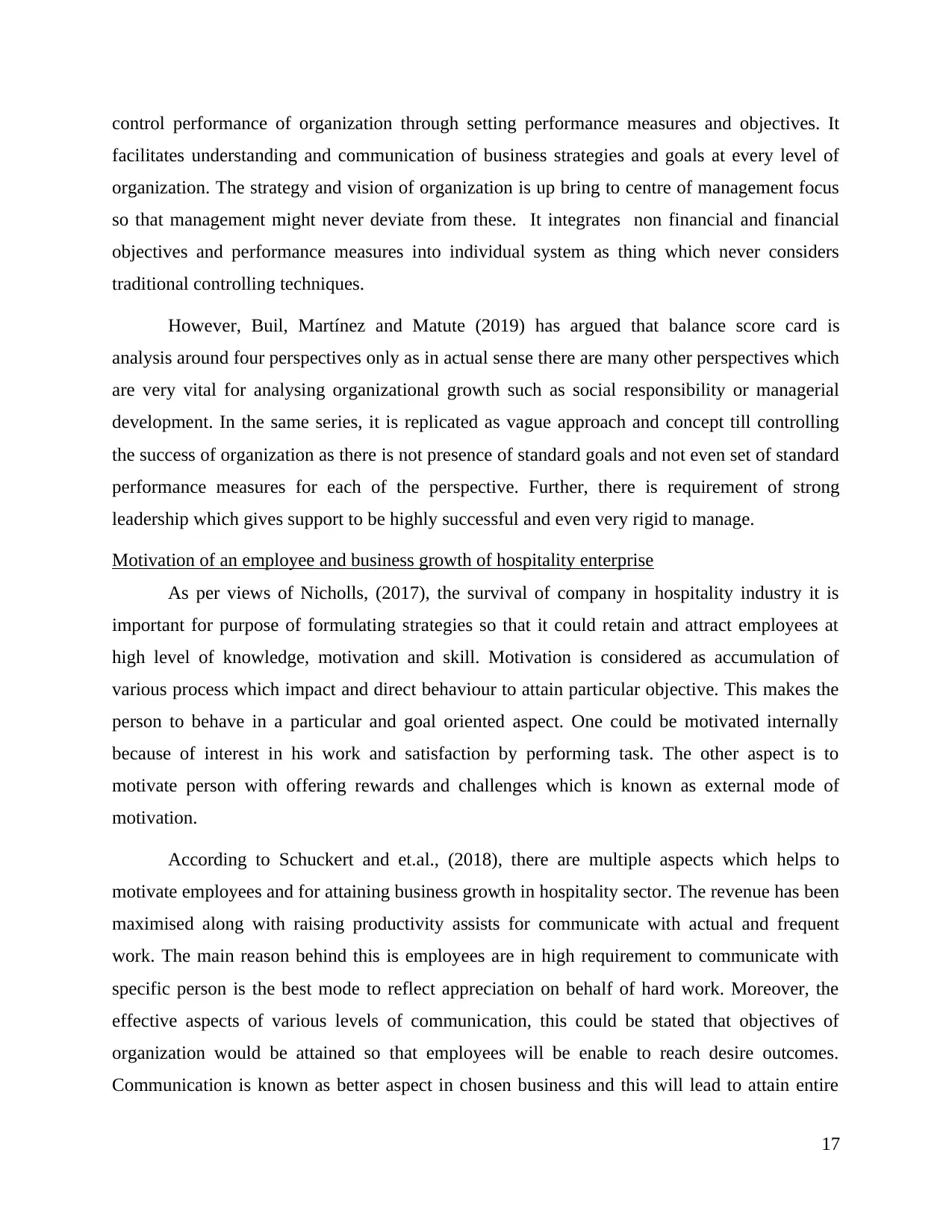
control performance of organization through setting performance measures and objectives. It
facilitates understanding and communication of business strategies and goals at every level of
organization. The strategy and vision of organization is up bring to centre of management focus
so that management might never deviate from these. It integrates non financial and financial
objectives and performance measures into individual system as thing which never considers
traditional controlling techniques.
However, Buil, Martínez and Matute (2019) has argued that balance score card is
analysis around four perspectives only as in actual sense there are many other perspectives which
are very vital for analysing organizational growth such as social responsibility or managerial
development. In the same series, it is replicated as vague approach and concept till controlling
the success of organization as there is not presence of standard goals and not even set of standard
performance measures for each of the perspective. Further, there is requirement of strong
leadership which gives support to be highly successful and even very rigid to manage.
Motivation of an employee and business growth of hospitality enterprise
As per views of Nicholls, (2017), the survival of company in hospitality industry it is
important for purpose of formulating strategies so that it could retain and attract employees at
high level of knowledge, motivation and skill. Motivation is considered as accumulation of
various process which impact and direct behaviour to attain particular objective. This makes the
person to behave in a particular and goal oriented aspect. One could be motivated internally
because of interest in his work and satisfaction by performing task. The other aspect is to
motivate person with offering rewards and challenges which is known as external mode of
motivation.
According to Schuckert and et.al., (2018), there are multiple aspects which helps to
motivate employees and for attaining business growth in hospitality sector. The revenue has been
maximised along with raising productivity assists for communicate with actual and frequent
work. The main reason behind this is employees are in high requirement to communicate with
specific person is the best mode to reflect appreciation on behalf of hard work. Moreover, the
effective aspects of various levels of communication, this could be stated that objectives of
organization would be attained so that employees will be enable to reach desire outcomes.
Communication is known as better aspect in chosen business and this will lead to attain entire
17
facilitates understanding and communication of business strategies and goals at every level of
organization. The strategy and vision of organization is up bring to centre of management focus
so that management might never deviate from these. It integrates non financial and financial
objectives and performance measures into individual system as thing which never considers
traditional controlling techniques.
However, Buil, Martínez and Matute (2019) has argued that balance score card is
analysis around four perspectives only as in actual sense there are many other perspectives which
are very vital for analysing organizational growth such as social responsibility or managerial
development. In the same series, it is replicated as vague approach and concept till controlling
the success of organization as there is not presence of standard goals and not even set of standard
performance measures for each of the perspective. Further, there is requirement of strong
leadership which gives support to be highly successful and even very rigid to manage.
Motivation of an employee and business growth of hospitality enterprise
As per views of Nicholls, (2017), the survival of company in hospitality industry it is
important for purpose of formulating strategies so that it could retain and attract employees at
high level of knowledge, motivation and skill. Motivation is considered as accumulation of
various process which impact and direct behaviour to attain particular objective. This makes the
person to behave in a particular and goal oriented aspect. One could be motivated internally
because of interest in his work and satisfaction by performing task. The other aspect is to
motivate person with offering rewards and challenges which is known as external mode of
motivation.
According to Schuckert and et.al., (2018), there are multiple aspects which helps to
motivate employees and for attaining business growth in hospitality sector. The revenue has been
maximised along with raising productivity assists for communicate with actual and frequent
work. The main reason behind this is employees are in high requirement to communicate with
specific person is the best mode to reflect appreciation on behalf of hard work. Moreover, the
effective aspects of various levels of communication, this could be stated that objectives of
organization would be attained so that employees will be enable to reach desire outcomes.
Communication is known as better aspect in chosen business and this will lead to attain entire
17
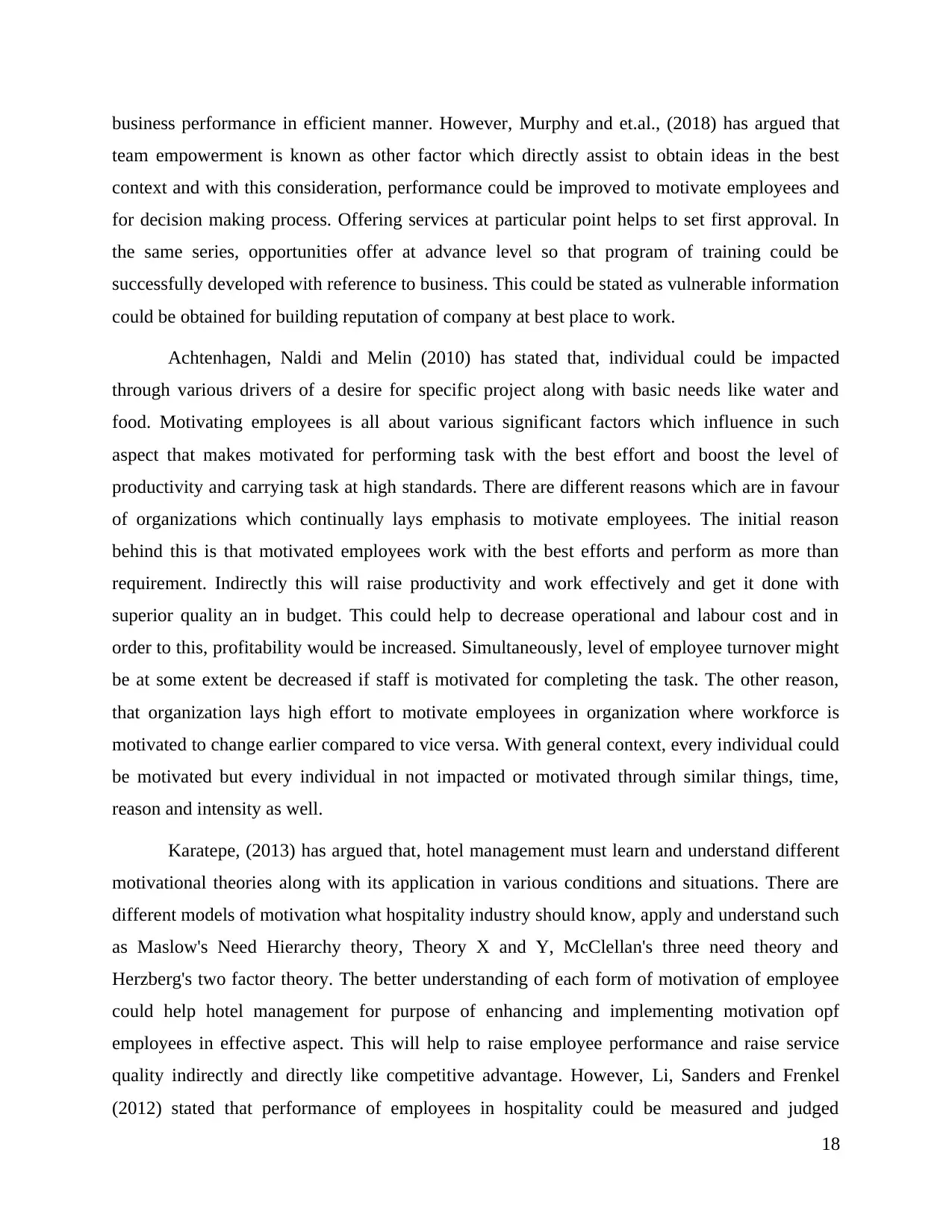
business performance in efficient manner. However, Murphy and et.al., (2018) has argued that
team empowerment is known as other factor which directly assist to obtain ideas in the best
context and with this consideration, performance could be improved to motivate employees and
for decision making process. Offering services at particular point helps to set first approval. In
the same series, opportunities offer at advance level so that program of training could be
successfully developed with reference to business. This could be stated as vulnerable information
could be obtained for building reputation of company at best place to work.
Achtenhagen, Naldi and Melin (2010) has stated that, individual could be impacted
through various drivers of a desire for specific project along with basic needs like water and
food. Motivating employees is all about various significant factors which influence in such
aspect that makes motivated for performing task with the best effort and boost the level of
productivity and carrying task at high standards. There are different reasons which are in favour
of organizations which continually lays emphasis to motivate employees. The initial reason
behind this is that motivated employees work with the best efforts and perform as more than
requirement. Indirectly this will raise productivity and work effectively and get it done with
superior quality an in budget. This could help to decrease operational and labour cost and in
order to this, profitability would be increased. Simultaneously, level of employee turnover might
be at some extent be decreased if staff is motivated for completing the task. The other reason,
that organization lays high effort to motivate employees in organization where workforce is
motivated to change earlier compared to vice versa. With general context, every individual could
be motivated but every individual in not impacted or motivated through similar things, time,
reason and intensity as well.
Karatepe, (2013) has argued that, hotel management must learn and understand different
motivational theories along with its application in various conditions and situations. There are
different models of motivation what hospitality industry should know, apply and understand such
as Maslow's Need Hierarchy theory, Theory X and Y, McClellan's three need theory and
Herzberg's two factor theory. The better understanding of each form of motivation of employee
could help hotel management for purpose of enhancing and implementing motivation opf
employees in effective aspect. This will help to raise employee performance and raise service
quality indirectly and directly like competitive advantage. However, Li, Sanders and Frenkel
(2012) stated that performance of employees in hospitality could be measured and judged
18
team empowerment is known as other factor which directly assist to obtain ideas in the best
context and with this consideration, performance could be improved to motivate employees and
for decision making process. Offering services at particular point helps to set first approval. In
the same series, opportunities offer at advance level so that program of training could be
successfully developed with reference to business. This could be stated as vulnerable information
could be obtained for building reputation of company at best place to work.
Achtenhagen, Naldi and Melin (2010) has stated that, individual could be impacted
through various drivers of a desire for specific project along with basic needs like water and
food. Motivating employees is all about various significant factors which influence in such
aspect that makes motivated for performing task with the best effort and boost the level of
productivity and carrying task at high standards. There are different reasons which are in favour
of organizations which continually lays emphasis to motivate employees. The initial reason
behind this is that motivated employees work with the best efforts and perform as more than
requirement. Indirectly this will raise productivity and work effectively and get it done with
superior quality an in budget. This could help to decrease operational and labour cost and in
order to this, profitability would be increased. Simultaneously, level of employee turnover might
be at some extent be decreased if staff is motivated for completing the task. The other reason,
that organization lays high effort to motivate employees in organization where workforce is
motivated to change earlier compared to vice versa. With general context, every individual could
be motivated but every individual in not impacted or motivated through similar things, time,
reason and intensity as well.
Karatepe, (2013) has argued that, hotel management must learn and understand different
motivational theories along with its application in various conditions and situations. There are
different models of motivation what hospitality industry should know, apply and understand such
as Maslow's Need Hierarchy theory, Theory X and Y, McClellan's three need theory and
Herzberg's two factor theory. The better understanding of each form of motivation of employee
could help hotel management for purpose of enhancing and implementing motivation opf
employees in effective aspect. This will help to raise employee performance and raise service
quality indirectly and directly like competitive advantage. However, Li, Sanders and Frenkel
(2012) stated that performance of employees in hospitality could be measured and judged
18

through their friendliness, attentiveness, attitudes and way they carry and perform the assigned
tasks. There is an aggregate that best performance in hospitality creates customer satisfaction at
high level. As its outcome, customer would go back and implies application of hotel services and
goods on repetitive aspect. This has been postulated that success of hotel is highly relied about
management and employee motivation but there are numerous factors which creates difficulty to
motivate employees.
According to Schuckert and et.al., (2018), the initial factor is pay in hospitality is
minimum wage rate or company could only pay as per requirement of labour laws to employees.
This might not attain or satisfy the basic needs of numerous front line employees and apart from
this, other factor is specifically to small and medium sized hotels for hiring employees of certain
age. Various hospitality organization prefer to hire staff which are young and over the older one
and some vice versa. This could make employees who are not at favourable age group could not
perform at best efforts due to unfair and unequal treatment. For an organization, employees are
replicated as valuable resource and important asset as they play vital role through contributing
multiple activities. This is very important for company as staff are very essential for them and
performing task and be innovative for their work. These all particular parameters could be
attained by motivating employees as this creates commitment and loyalty in employees who
work for purpose of organizational objective. In a company, managers have responsibility to
tackle motivational challenges so that this could lead employees to be productive members of
company to enhance its effectiveness.
However, Syaifullah, Titisari and Puspitasari, (2019) has argued that attitude of
employees impact success of business as by giving appropriate shape to attitude of employee and
motivating the personnel with significant areas where manager observes that organization could
attain for fulfilling potential and performing according to capability. The employee performance
is dependent on motivation level as different categories of staff is dependent on age, gender etc.
at various other levels of motivation. Motivating the employees is a very important job as this
leads to retain staff, improving quality of work, inciting positive attitude along with willingness
for developing skills. On the contrary, Koster, (2017) has stated that poor level of motivation
would hamper the employee productivity which would further dampen the organizational
growth. Henceforth, it is imperative for manager's perspective to keep the workforce motivated
and extracting factors which impact employee's level of motivation.
19
tasks. There is an aggregate that best performance in hospitality creates customer satisfaction at
high level. As its outcome, customer would go back and implies application of hotel services and
goods on repetitive aspect. This has been postulated that success of hotel is highly relied about
management and employee motivation but there are numerous factors which creates difficulty to
motivate employees.
According to Schuckert and et.al., (2018), the initial factor is pay in hospitality is
minimum wage rate or company could only pay as per requirement of labour laws to employees.
This might not attain or satisfy the basic needs of numerous front line employees and apart from
this, other factor is specifically to small and medium sized hotels for hiring employees of certain
age. Various hospitality organization prefer to hire staff which are young and over the older one
and some vice versa. This could make employees who are not at favourable age group could not
perform at best efforts due to unfair and unequal treatment. For an organization, employees are
replicated as valuable resource and important asset as they play vital role through contributing
multiple activities. This is very important for company as staff are very essential for them and
performing task and be innovative for their work. These all particular parameters could be
attained by motivating employees as this creates commitment and loyalty in employees who
work for purpose of organizational objective. In a company, managers have responsibility to
tackle motivational challenges so that this could lead employees to be productive members of
company to enhance its effectiveness.
However, Syaifullah, Titisari and Puspitasari, (2019) has argued that attitude of
employees impact success of business as by giving appropriate shape to attitude of employee and
motivating the personnel with significant areas where manager observes that organization could
attain for fulfilling potential and performing according to capability. The employee performance
is dependent on motivation level as different categories of staff is dependent on age, gender etc.
at various other levels of motivation. Motivating the employees is a very important job as this
leads to retain staff, improving quality of work, inciting positive attitude along with willingness
for developing skills. On the contrary, Koster, (2017) has stated that poor level of motivation
would hamper the employee productivity which would further dampen the organizational
growth. Henceforth, it is imperative for manager's perspective to keep the workforce motivated
and extracting factors which impact employee's level of motivation.
19
Secure Best Marks with AI Grader
Need help grading? Try our AI Grader for instant feedback on your assignments.
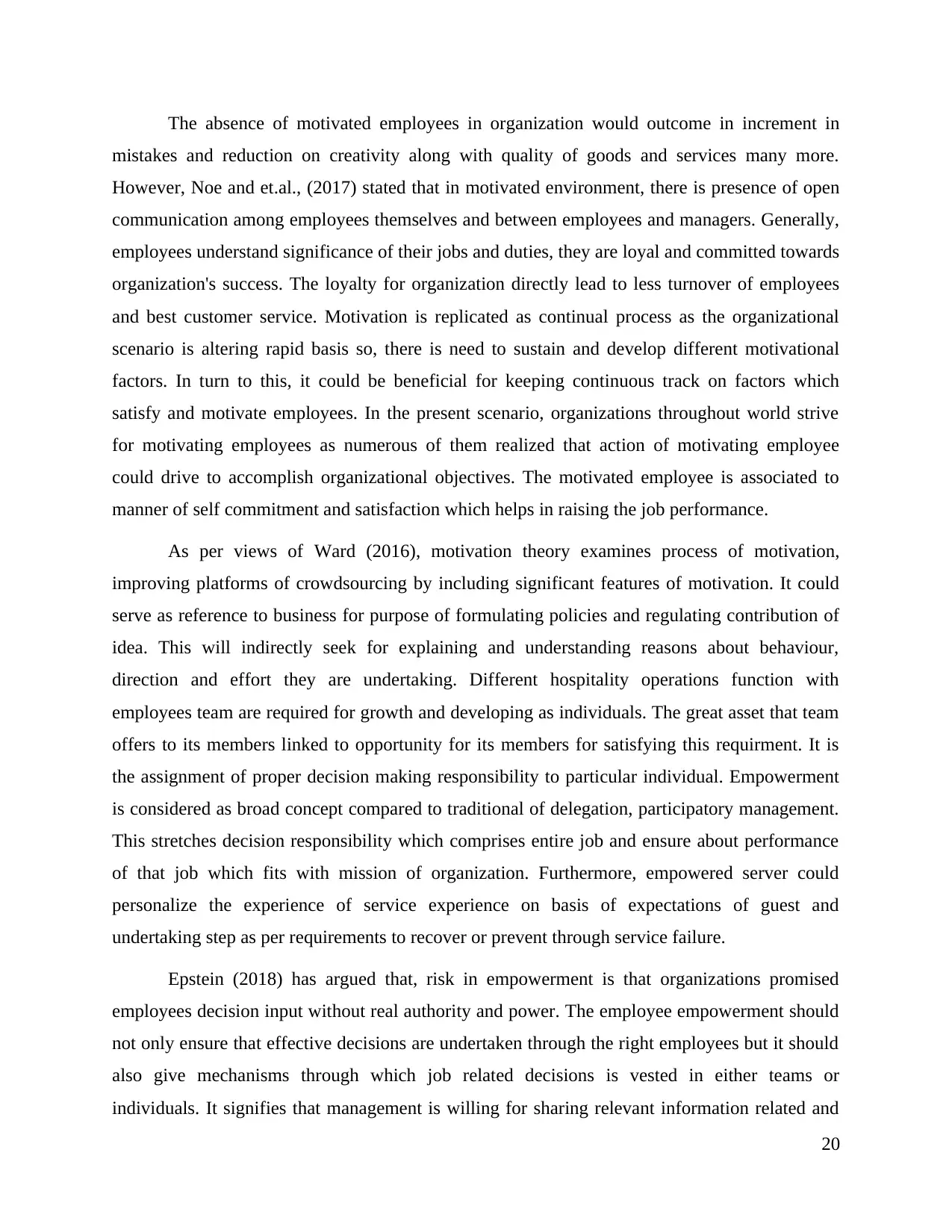
The absence of motivated employees in organization would outcome in increment in
mistakes and reduction on creativity along with quality of goods and services many more.
However, Noe and et.al., (2017) stated that in motivated environment, there is presence of open
communication among employees themselves and between employees and managers. Generally,
employees understand significance of their jobs and duties, they are loyal and committed towards
organization's success. The loyalty for organization directly lead to less turnover of employees
and best customer service. Motivation is replicated as continual process as the organizational
scenario is altering rapid basis so, there is need to sustain and develop different motivational
factors. In turn to this, it could be beneficial for keeping continuous track on factors which
satisfy and motivate employees. In the present scenario, organizations throughout world strive
for motivating employees as numerous of them realized that action of motivating employee
could drive to accomplish organizational objectives. The motivated employee is associated to
manner of self commitment and satisfaction which helps in raising the job performance.
As per views of Ward (2016), motivation theory examines process of motivation,
improving platforms of crowdsourcing by including significant features of motivation. It could
serve as reference to business for purpose of formulating policies and regulating contribution of
idea. This will indirectly seek for explaining and understanding reasons about behaviour,
direction and effort they are undertaking. Different hospitality operations function with
employees team are required for growth and developing as individuals. The great asset that team
offers to its members linked to opportunity for its members for satisfying this requirment. It is
the assignment of proper decision making responsibility to particular individual. Empowerment
is considered as broad concept compared to traditional of delegation, participatory management.
This stretches decision responsibility which comprises entire job and ensure about performance
of that job which fits with mission of organization. Furthermore, empowered server could
personalize the experience of service experience on basis of expectations of guest and
undertaking step as per requirements to recover or prevent through service failure.
Epstein (2018) has argued that, risk in empowerment is that organizations promised
employees decision input without real authority and power. The employee empowerment should
not only ensure that effective decisions are undertaken through the right employees but it should
also give mechanisms through which job related decisions is vested in either teams or
individuals. It signifies that management is willing for sharing relevant information related and
20
mistakes and reduction on creativity along with quality of goods and services many more.
However, Noe and et.al., (2017) stated that in motivated environment, there is presence of open
communication among employees themselves and between employees and managers. Generally,
employees understand significance of their jobs and duties, they are loyal and committed towards
organization's success. The loyalty for organization directly lead to less turnover of employees
and best customer service. Motivation is replicated as continual process as the organizational
scenario is altering rapid basis so, there is need to sustain and develop different motivational
factors. In turn to this, it could be beneficial for keeping continuous track on factors which
satisfy and motivate employees. In the present scenario, organizations throughout world strive
for motivating employees as numerous of them realized that action of motivating employee
could drive to accomplish organizational objectives. The motivated employee is associated to
manner of self commitment and satisfaction which helps in raising the job performance.
As per views of Ward (2016), motivation theory examines process of motivation,
improving platforms of crowdsourcing by including significant features of motivation. It could
serve as reference to business for purpose of formulating policies and regulating contribution of
idea. This will indirectly seek for explaining and understanding reasons about behaviour,
direction and effort they are undertaking. Different hospitality operations function with
employees team are required for growth and developing as individuals. The great asset that team
offers to its members linked to opportunity for its members for satisfying this requirment. It is
the assignment of proper decision making responsibility to particular individual. Empowerment
is considered as broad concept compared to traditional of delegation, participatory management.
This stretches decision responsibility which comprises entire job and ensure about performance
of that job which fits with mission of organization. Furthermore, empowered server could
personalize the experience of service experience on basis of expectations of guest and
undertaking step as per requirements to recover or prevent through service failure.
Epstein (2018) has argued that, risk in empowerment is that organizations promised
employees decision input without real authority and power. The employee empowerment should
not only ensure that effective decisions are undertaken through the right employees but it should
also give mechanisms through which job related decisions is vested in either teams or
individuals. It signifies that management is willing for sharing relevant information related and
20
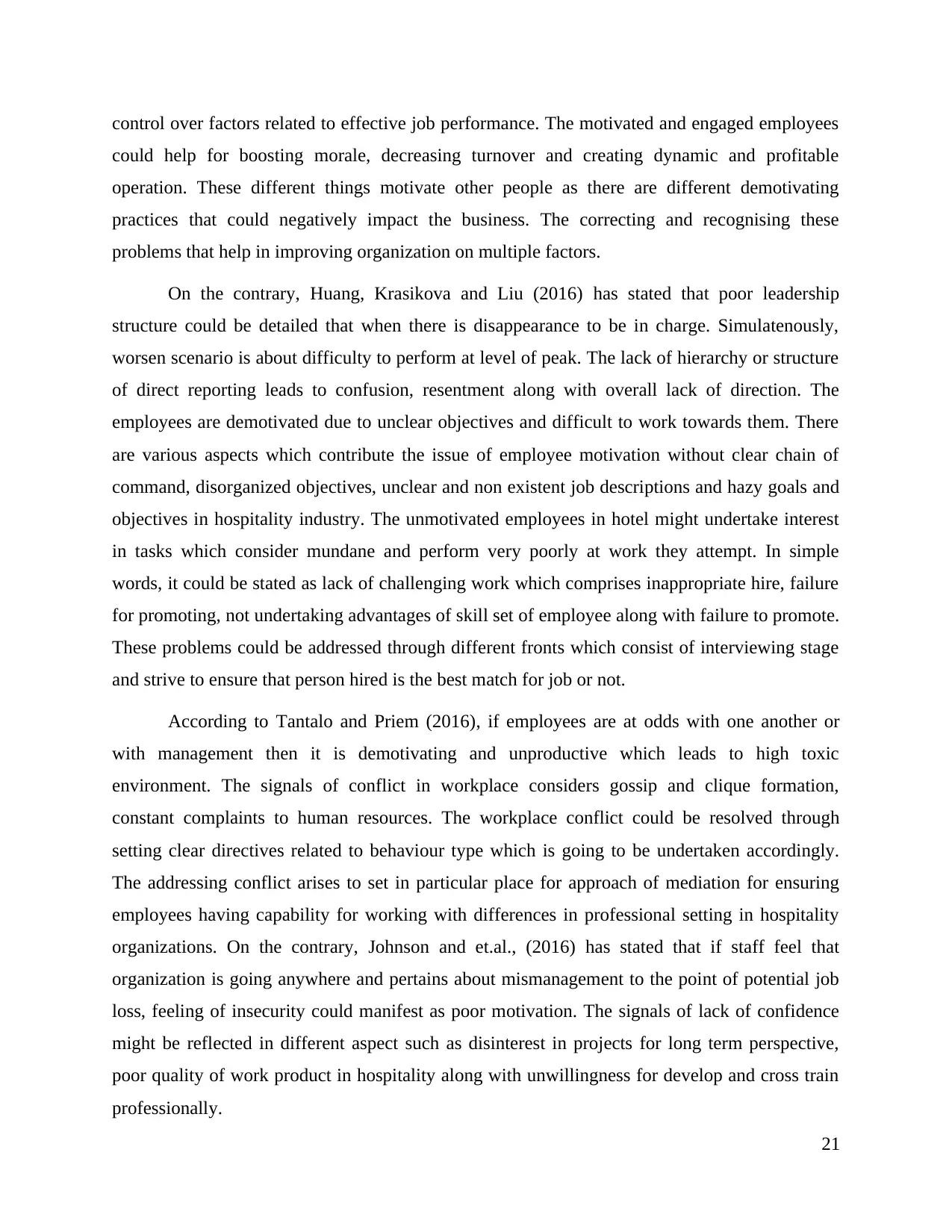
control over factors related to effective job performance. The motivated and engaged employees
could help for boosting morale, decreasing turnover and creating dynamic and profitable
operation. These different things motivate other people as there are different demotivating
practices that could negatively impact the business. The correcting and recognising these
problems that help in improving organization on multiple factors.
On the contrary, Huang, Krasikova and Liu (2016) has stated that poor leadership
structure could be detailed that when there is disappearance to be in charge. Simulatenously,
worsen scenario is about difficulty to perform at level of peak. The lack of hierarchy or structure
of direct reporting leads to confusion, resentment along with overall lack of direction. The
employees are demotivated due to unclear objectives and difficult to work towards them. There
are various aspects which contribute the issue of employee motivation without clear chain of
command, disorganized objectives, unclear and non existent job descriptions and hazy goals and
objectives in hospitality industry. The unmotivated employees in hotel might undertake interest
in tasks which consider mundane and perform very poorly at work they attempt. In simple
words, it could be stated as lack of challenging work which comprises inappropriate hire, failure
for promoting, not undertaking advantages of skill set of employee along with failure to promote.
These problems could be addressed through different fronts which consist of interviewing stage
and strive to ensure that person hired is the best match for job or not.
According to Tantalo and Priem (2016), if employees are at odds with one another or
with management then it is demotivating and unproductive which leads to high toxic
environment. The signals of conflict in workplace considers gossip and clique formation,
constant complaints to human resources. The workplace conflict could be resolved through
setting clear directives related to behaviour type which is going to be undertaken accordingly.
The addressing conflict arises to set in particular place for approach of mediation for ensuring
employees having capability for working with differences in professional setting in hospitality
organizations. On the contrary, Johnson and et.al., (2016) has stated that if staff feel that
organization is going anywhere and pertains about mismanagement to the point of potential job
loss, feeling of insecurity could manifest as poor motivation. The signals of lack of confidence
might be reflected in different aspect such as disinterest in projects for long term perspective,
poor quality of work product in hospitality along with unwillingness for develop and cross train
professionally.
21
could help for boosting morale, decreasing turnover and creating dynamic and profitable
operation. These different things motivate other people as there are different demotivating
practices that could negatively impact the business. The correcting and recognising these
problems that help in improving organization on multiple factors.
On the contrary, Huang, Krasikova and Liu (2016) has stated that poor leadership
structure could be detailed that when there is disappearance to be in charge. Simulatenously,
worsen scenario is about difficulty to perform at level of peak. The lack of hierarchy or structure
of direct reporting leads to confusion, resentment along with overall lack of direction. The
employees are demotivated due to unclear objectives and difficult to work towards them. There
are various aspects which contribute the issue of employee motivation without clear chain of
command, disorganized objectives, unclear and non existent job descriptions and hazy goals and
objectives in hospitality industry. The unmotivated employees in hotel might undertake interest
in tasks which consider mundane and perform very poorly at work they attempt. In simple
words, it could be stated as lack of challenging work which comprises inappropriate hire, failure
for promoting, not undertaking advantages of skill set of employee along with failure to promote.
These problems could be addressed through different fronts which consist of interviewing stage
and strive to ensure that person hired is the best match for job or not.
According to Tantalo and Priem (2016), if employees are at odds with one another or
with management then it is demotivating and unproductive which leads to high toxic
environment. The signals of conflict in workplace considers gossip and clique formation,
constant complaints to human resources. The workplace conflict could be resolved through
setting clear directives related to behaviour type which is going to be undertaken accordingly.
The addressing conflict arises to set in particular place for approach of mediation for ensuring
employees having capability for working with differences in professional setting in hospitality
organizations. On the contrary, Johnson and et.al., (2016) has stated that if staff feel that
organization is going anywhere and pertains about mismanagement to the point of potential job
loss, feeling of insecurity could manifest as poor motivation. The signals of lack of confidence
might be reflected in different aspect such as disinterest in projects for long term perspective,
poor quality of work product in hospitality along with unwillingness for develop and cross train
professionally.
21
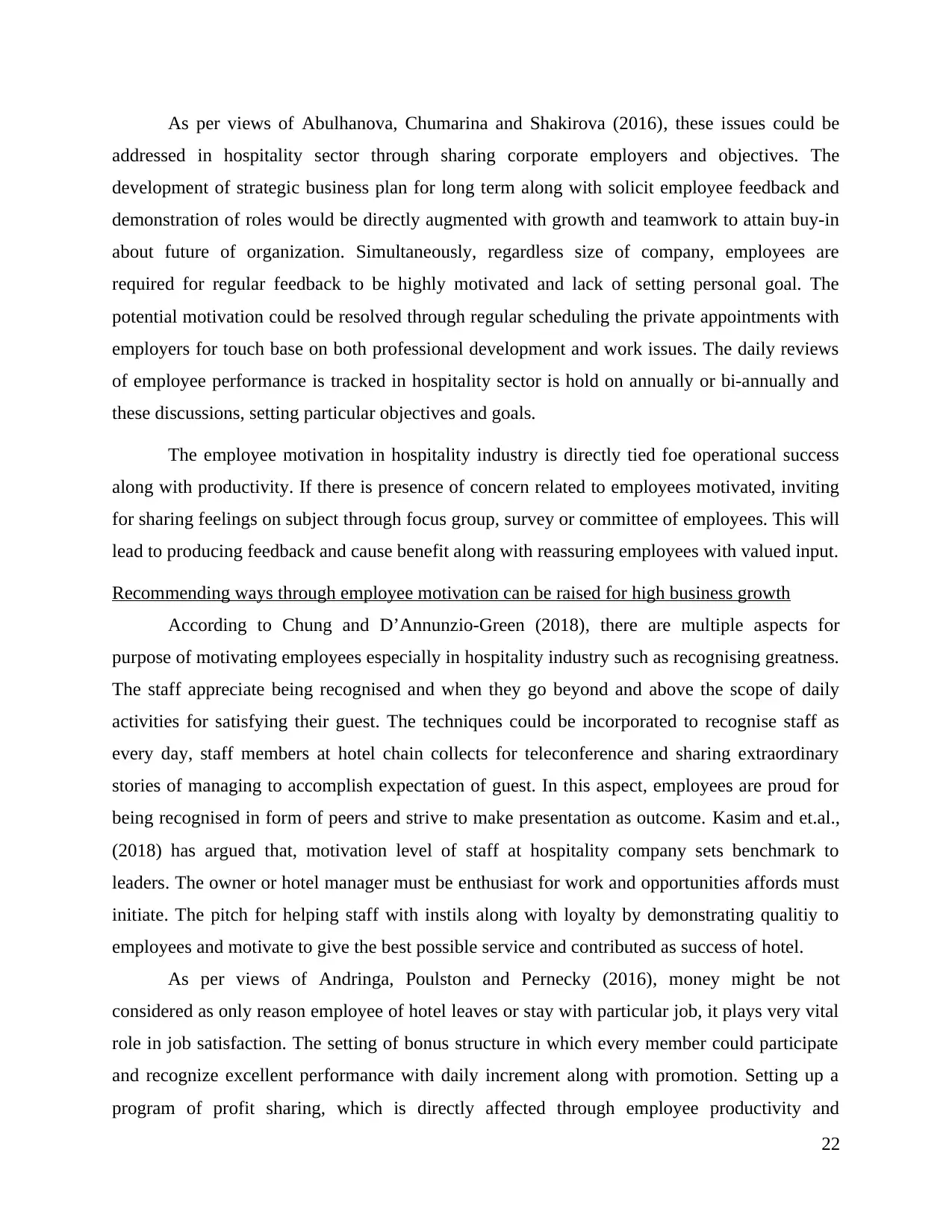
As per views of Abulhanova, Chumarina and Shakirova (2016), these issues could be
addressed in hospitality sector through sharing corporate employers and objectives. The
development of strategic business plan for long term along with solicit employee feedback and
demonstration of roles would be directly augmented with growth and teamwork to attain buy-in
about future of organization. Simultaneously, regardless size of company, employees are
required for regular feedback to be highly motivated and lack of setting personal goal. The
potential motivation could be resolved through regular scheduling the private appointments with
employers for touch base on both professional development and work issues. The daily reviews
of employee performance is tracked in hospitality sector is hold on annually or bi-annually and
these discussions, setting particular objectives and goals.
The employee motivation in hospitality industry is directly tied foe operational success
along with productivity. If there is presence of concern related to employees motivated, inviting
for sharing feelings on subject through focus group, survey or committee of employees. This will
lead to producing feedback and cause benefit along with reassuring employees with valued input.
Recommending ways through employee motivation can be raised for high business growth
According to Chung and D’Annunzio-Green (2018), there are multiple aspects for
purpose of motivating employees especially in hospitality industry such as recognising greatness.
The staff appreciate being recognised and when they go beyond and above the scope of daily
activities for satisfying their guest. The techniques could be incorporated to recognise staff as
every day, staff members at hotel chain collects for teleconference and sharing extraordinary
stories of managing to accomplish expectation of guest. In this aspect, employees are proud for
being recognised in form of peers and strive to make presentation as outcome. Kasim and et.al.,
(2018) has argued that, motivation level of staff at hospitality company sets benchmark to
leaders. The owner or hotel manager must be enthusiast for work and opportunities affords must
initiate. The pitch for helping staff with instils along with loyalty by demonstrating qualitiy to
employees and motivate to give the best possible service and contributed as success of hotel.
As per views of Andringa, Poulston and Pernecky (2016), money might be not
considered as only reason employee of hotel leaves or stay with particular job, it plays very vital
role in job satisfaction. The setting of bonus structure in which every member could participate
and recognize excellent performance with daily increment along with promotion. Setting up a
program of profit sharing, which is directly affected through employee productivity and
22
addressed in hospitality sector through sharing corporate employers and objectives. The
development of strategic business plan for long term along with solicit employee feedback and
demonstration of roles would be directly augmented with growth and teamwork to attain buy-in
about future of organization. Simultaneously, regardless size of company, employees are
required for regular feedback to be highly motivated and lack of setting personal goal. The
potential motivation could be resolved through regular scheduling the private appointments with
employers for touch base on both professional development and work issues. The daily reviews
of employee performance is tracked in hospitality sector is hold on annually or bi-annually and
these discussions, setting particular objectives and goals.
The employee motivation in hospitality industry is directly tied foe operational success
along with productivity. If there is presence of concern related to employees motivated, inviting
for sharing feelings on subject through focus group, survey or committee of employees. This will
lead to producing feedback and cause benefit along with reassuring employees with valued input.
Recommending ways through employee motivation can be raised for high business growth
According to Chung and D’Annunzio-Green (2018), there are multiple aspects for
purpose of motivating employees especially in hospitality industry such as recognising greatness.
The staff appreciate being recognised and when they go beyond and above the scope of daily
activities for satisfying their guest. The techniques could be incorporated to recognise staff as
every day, staff members at hotel chain collects for teleconference and sharing extraordinary
stories of managing to accomplish expectation of guest. In this aspect, employees are proud for
being recognised in form of peers and strive to make presentation as outcome. Kasim and et.al.,
(2018) has argued that, motivation level of staff at hospitality company sets benchmark to
leaders. The owner or hotel manager must be enthusiast for work and opportunities affords must
initiate. The pitch for helping staff with instils along with loyalty by demonstrating qualitiy to
employees and motivate to give the best possible service and contributed as success of hotel.
As per views of Andringa, Poulston and Pernecky (2016), money might be not
considered as only reason employee of hotel leaves or stay with particular job, it plays very vital
role in job satisfaction. The setting of bonus structure in which every member could participate
and recognize excellent performance with daily increment along with promotion. Setting up a
program of profit sharing, which is directly affected through employee productivity and
22
Paraphrase This Document
Need a fresh take? Get an instant paraphrase of this document with our AI Paraphraser

customer service. Extracting creative methods for purpose of rewarding the outstanding
performance like family trips, gift cards and extended stay in hotel for their employees. In the
same series, guests must be asked for feedback on the service they have gained in stay and
rewarding employees with consistent rating through customers is high.
On the contrary, Peters, Kallmuenzer and Buhalis (2018) has critiqued that motivation is
very complex that no individual policy would help to motivate staff. The financial rewards play
very censorious role to motivate employees of hospitality. The Recognition and feedback are
also very effective tool with presence of management and leadership skills to know that how and
when to offer non financial rewards in effective manner. The work itself could be very
motivating for desiring it appropriately. The job could not be designed with absence of
considering the culture of hotel, training and types of employees and mode the service product is
delivered. Combining every pieces in aspect which leads that each employee should do for
success of organization is appropriate test for skill of manager.
Newman and et.al., (2018) has stated that, employees must feel empower for purpose of
undertaking decisions and tools required for appropriately performing duties and motivated and
tend to stick with jobs higher compared to other staff members who does not feel to support of
management. The turnover rate tends to be in range among 78.3 and 95.4 percent in hospitality
sector and keep rates at lower end of range, keeping employees happy and motivated through
undertaking concerns and taking action for helping to perform jobs. It leads to raise ion customer
satisfaction and productivity and also saves money to spend on training and hiring constant
stream of all new employees.
Adeyinka-Ojo (2018) has argued that employees of hospitality are looking for jobs which
are fair, interesting, fun and very important. This appreciation leadership through managers who
could determine about preferences of every person in employment relationship and could offer it
fairly and consistently. The key to manage and retain employees is for managing and retaining
employees is to create jobs and fulfilling question of employees are very important position,
allocating rewards fairly and offer leadership that undertakes times and making effort for
ensuring that employees are treated, respected, recognised and respected. If one could
successfully build elements into particular situation of job., employees would be motivated for
working hard and following leadership. Henceforth, it had been concluded that fundamental key
for motivation is to know employees in the best manner in hospitality industry.
23
performance like family trips, gift cards and extended stay in hotel for their employees. In the
same series, guests must be asked for feedback on the service they have gained in stay and
rewarding employees with consistent rating through customers is high.
On the contrary, Peters, Kallmuenzer and Buhalis (2018) has critiqued that motivation is
very complex that no individual policy would help to motivate staff. The financial rewards play
very censorious role to motivate employees of hospitality. The Recognition and feedback are
also very effective tool with presence of management and leadership skills to know that how and
when to offer non financial rewards in effective manner. The work itself could be very
motivating for desiring it appropriately. The job could not be designed with absence of
considering the culture of hotel, training and types of employees and mode the service product is
delivered. Combining every pieces in aspect which leads that each employee should do for
success of organization is appropriate test for skill of manager.
Newman and et.al., (2018) has stated that, employees must feel empower for purpose of
undertaking decisions and tools required for appropriately performing duties and motivated and
tend to stick with jobs higher compared to other staff members who does not feel to support of
management. The turnover rate tends to be in range among 78.3 and 95.4 percent in hospitality
sector and keep rates at lower end of range, keeping employees happy and motivated through
undertaking concerns and taking action for helping to perform jobs. It leads to raise ion customer
satisfaction and productivity and also saves money to spend on training and hiring constant
stream of all new employees.
Adeyinka-Ojo (2018) has argued that employees of hospitality are looking for jobs which
are fair, interesting, fun and very important. This appreciation leadership through managers who
could determine about preferences of every person in employment relationship and could offer it
fairly and consistently. The key to manage and retain employees is for managing and retaining
employees is to create jobs and fulfilling question of employees are very important position,
allocating rewards fairly and offer leadership that undertakes times and making effort for
ensuring that employees are treated, respected, recognised and respected. If one could
successfully build elements into particular situation of job., employees would be motivated for
working hard and following leadership. Henceforth, it had been concluded that fundamental key
for motivation is to know employees in the best manner in hospitality industry.
23
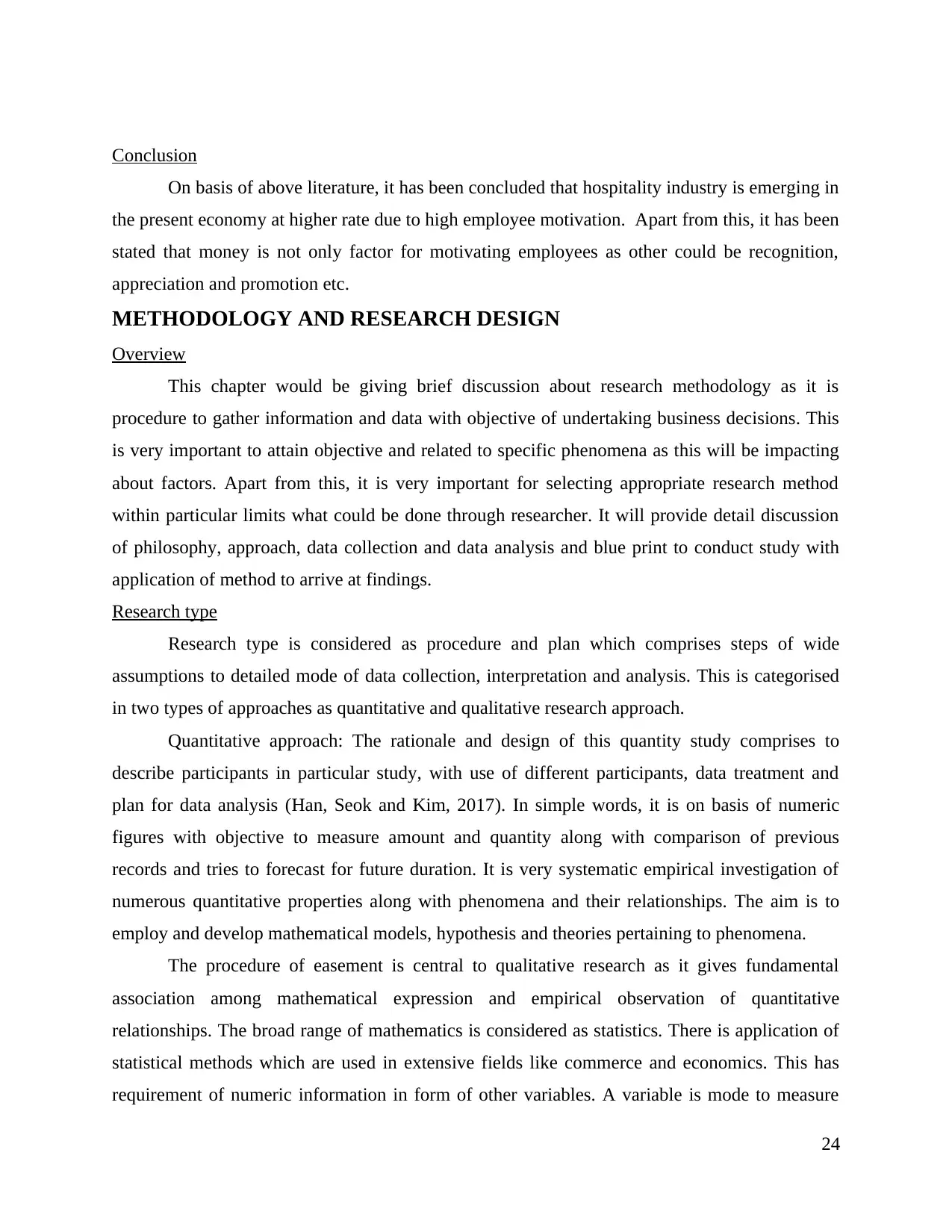
Conclusion
On basis of above literature, it has been concluded that hospitality industry is emerging in
the present economy at higher rate due to high employee motivation. Apart from this, it has been
stated that money is not only factor for motivating employees as other could be recognition,
appreciation and promotion etc.
METHODOLOGY AND RESEARCH DESIGN
Overview
This chapter would be giving brief discussion about research methodology as it is
procedure to gather information and data with objective of undertaking business decisions. This
is very important to attain objective and related to specific phenomena as this will be impacting
about factors. Apart from this, it is very important for selecting appropriate research method
within particular limits what could be done through researcher. It will provide detail discussion
of philosophy, approach, data collection and data analysis and blue print to conduct study with
application of method to arrive at findings.
Research type
Research type is considered as procedure and plan which comprises steps of wide
assumptions to detailed mode of data collection, interpretation and analysis. This is categorised
in two types of approaches as quantitative and qualitative research approach.
Quantitative approach: The rationale and design of this quantity study comprises to
describe participants in particular study, with use of different participants, data treatment and
plan for data analysis (Han, Seok and Kim, 2017). In simple words, it is on basis of numeric
figures with objective to measure amount and quantity along with comparison of previous
records and tries to forecast for future duration. It is very systematic empirical investigation of
numerous quantitative properties along with phenomena and their relationships. The aim is to
employ and develop mathematical models, hypothesis and theories pertaining to phenomena.
The procedure of easement is central to qualitative research as it gives fundamental
association among mathematical expression and empirical observation of quantitative
relationships. The broad range of mathematics is considered as statistics. There is application of
statistical methods which are used in extensive fields like commerce and economics. This has
requirement of numeric information in form of other variables. A variable is mode to measure
24
On basis of above literature, it has been concluded that hospitality industry is emerging in
the present economy at higher rate due to high employee motivation. Apart from this, it has been
stated that money is not only factor for motivating employees as other could be recognition,
appreciation and promotion etc.
METHODOLOGY AND RESEARCH DESIGN
Overview
This chapter would be giving brief discussion about research methodology as it is
procedure to gather information and data with objective of undertaking business decisions. This
is very important to attain objective and related to specific phenomena as this will be impacting
about factors. Apart from this, it is very important for selecting appropriate research method
within particular limits what could be done through researcher. It will provide detail discussion
of philosophy, approach, data collection and data analysis and blue print to conduct study with
application of method to arrive at findings.
Research type
Research type is considered as procedure and plan which comprises steps of wide
assumptions to detailed mode of data collection, interpretation and analysis. This is categorised
in two types of approaches as quantitative and qualitative research approach.
Quantitative approach: The rationale and design of this quantity study comprises to
describe participants in particular study, with use of different participants, data treatment and
plan for data analysis (Han, Seok and Kim, 2017). In simple words, it is on basis of numeric
figures with objective to measure amount and quantity along with comparison of previous
records and tries to forecast for future duration. It is very systematic empirical investigation of
numerous quantitative properties along with phenomena and their relationships. The aim is to
employ and develop mathematical models, hypothesis and theories pertaining to phenomena.
The procedure of easement is central to qualitative research as it gives fundamental
association among mathematical expression and empirical observation of quantitative
relationships. The broad range of mathematics is considered as statistics. There is application of
statistical methods which are used in extensive fields like commerce and economics. This has
requirement of numeric information in form of other variables. A variable is mode to measure
24

any particular feature which varies or has presence of two or more possible values. There are
various characteristics which are naturally numeric like year, age, income and numbers used for
purpose of measuring characteristic in meaningful aspect, that measures amount of presence of
feature. This could be gathered in varietal mode as collected through asking respondents for
purpose of reporting attitudes, demographics, experience etc. The direct observation of
quantitative data which has been collected for other objective which is also very common like
quantitative data recorded in results of standardized tests of students.
In addition to this, research with application of normative approach has been conducted
which detailed reason for known quantitative research as its inferences through are largely on
basis of quantitative data. In the same series, objectivity is initial guard so that researcher might
be replicated through others, if necessary (Agyeiwaah, 2019). This might be also known as
analytical research. In simpler terms, this research answers question that answer of how. Usually,
it involves transforming and collecting data into numerical aspect so that statistical calculations
could be made and further conclusion could be drawn.
Qualitative research reflects a non quantitative type of analysis as its is analysing,
collecting and interpreting data through observing people perform and say. It is replicated as
meaning, features, symbols, characteristics, description and metaphors of things. This is very
subjective and application of different methods of collecting information and mainly individual,
focus groups and in-depth interviews. The nature of this type of research is open-ended and
exploratory. The small number of people are interviewed in-depth and relatively conduct of
small number of focus groups. It is all about analysing, recording and attempting for uncovering
the deeper meaning along with significance of human experience and behaviour, which
comprises contradictory behaviours, emotions and beliefs.
The rationale and research design is all about why and how of data analysis and
collection in qualitative approach. It seeks to reflect experience of particular group and laid
special emphasis on narrative. The logic behind qualitative research could be very challenging to
be accustomed to traditional deductive approach. This employs to first gather data and then
attempting to derive explanations with those data. This tends to be highly exploration in nature
and seeks to offer insight into how individual related about different aspects of their words. It is
soft and open to numerous interpretations as well designed qualitative research is very systematic
as there is need for recording each observations along with experience of data collection. The
25
various characteristics which are naturally numeric like year, age, income and numbers used for
purpose of measuring characteristic in meaningful aspect, that measures amount of presence of
feature. This could be gathered in varietal mode as collected through asking respondents for
purpose of reporting attitudes, demographics, experience etc. The direct observation of
quantitative data which has been collected for other objective which is also very common like
quantitative data recorded in results of standardized tests of students.
In addition to this, research with application of normative approach has been conducted
which detailed reason for known quantitative research as its inferences through are largely on
basis of quantitative data. In the same series, objectivity is initial guard so that researcher might
be replicated through others, if necessary (Agyeiwaah, 2019). This might be also known as
analytical research. In simpler terms, this research answers question that answer of how. Usually,
it involves transforming and collecting data into numerical aspect so that statistical calculations
could be made and further conclusion could be drawn.
Qualitative research reflects a non quantitative type of analysis as its is analysing,
collecting and interpreting data through observing people perform and say. It is replicated as
meaning, features, symbols, characteristics, description and metaphors of things. This is very
subjective and application of different methods of collecting information and mainly individual,
focus groups and in-depth interviews. The nature of this type of research is open-ended and
exploratory. The small number of people are interviewed in-depth and relatively conduct of
small number of focus groups. It is all about analysing, recording and attempting for uncovering
the deeper meaning along with significance of human experience and behaviour, which
comprises contradictory behaviours, emotions and beliefs.
The rationale and research design is all about why and how of data analysis and
collection in qualitative approach. It seeks to reflect experience of particular group and laid
special emphasis on narrative. The logic behind qualitative research could be very challenging to
be accustomed to traditional deductive approach. This employs to first gather data and then
attempting to derive explanations with those data. This tends to be highly exploration in nature
and seeks to offer insight into how individual related about different aspects of their words. It is
soft and open to numerous interpretations as well designed qualitative research is very systematic
as there is need for recording each observations along with experience of data collection. The
25
Secure Best Marks with AI Grader
Need help grading? Try our AI Grader for instant feedback on your assignments.

related concern about qualitative research is for confirming about own understanding of specific
phenomena (Taylor, Bogdan and DeVault, 2015). The main objective is for understanding and
representing experience along with actions of people as they involve, encounter and live via
situations. The data gathered systematically and saturated qualitative data gives degree of insight
into complex situation which directly differs dramatically through what is given through unique
contribution made in research.
It is implied for gaining understanding for underlying reasons, motivations and opinions.
It gives insight into issues and helps for purpose of developing hypotheses or ideas for potential
quantitative research. This is used for uncovering different trends in opinions and thoughts and
deep dive into issues. The data collection method vary with application of semi-structured or
unstructured techniques.
The present study would imply qualitative research for purpose of assessing impact of
motivation of an employee on the business growth of a company. The main reason behind
selecting this study because this will help in describing qualities or its features. This could not
decrease the description of number as the findings through quantitative research, one could attain
via process of encoding. It will lead to give details related to human behaviour, personality
characteristics where quantitative studies could not match. It includes information related to
behaviours of user, desires, needs, routines, cases and varietal of other information which is
mandatory to design product that would fit into life of user. It is an approach which is used for
purpose of exploring social interactions, processes and systems as it offers in-depth
understanding about mode of people which come for understanding, managing and act their
regular situations in specific settings. This aims to attain understanding of particular event or
organization instead of surface description of large sample of population.
Research philosophy
This is vast topic as this deal with nature, source and development of knowledge. It is
replicated as belief about methods in which data related to specific phenomena must be used,
analysed and collected. The idea of knowledge formation as mode which must be analysed,
gathered and used. In simple words, it is elaborated as development of knowledge and nature as
this is categorised in types which are positivism and interpretivisim.
Positivism is a theory which states positive knowledge on basis of natural phenomena
along with relations and properties. The derived information through sensory experience and
26
phenomena (Taylor, Bogdan and DeVault, 2015). The main objective is for understanding and
representing experience along with actions of people as they involve, encounter and live via
situations. The data gathered systematically and saturated qualitative data gives degree of insight
into complex situation which directly differs dramatically through what is given through unique
contribution made in research.
It is implied for gaining understanding for underlying reasons, motivations and opinions.
It gives insight into issues and helps for purpose of developing hypotheses or ideas for potential
quantitative research. This is used for uncovering different trends in opinions and thoughts and
deep dive into issues. The data collection method vary with application of semi-structured or
unstructured techniques.
The present study would imply qualitative research for purpose of assessing impact of
motivation of an employee on the business growth of a company. The main reason behind
selecting this study because this will help in describing qualities or its features. This could not
decrease the description of number as the findings through quantitative research, one could attain
via process of encoding. It will lead to give details related to human behaviour, personality
characteristics where quantitative studies could not match. It includes information related to
behaviours of user, desires, needs, routines, cases and varietal of other information which is
mandatory to design product that would fit into life of user. It is an approach which is used for
purpose of exploring social interactions, processes and systems as it offers in-depth
understanding about mode of people which come for understanding, managing and act their
regular situations in specific settings. This aims to attain understanding of particular event or
organization instead of surface description of large sample of population.
Research philosophy
This is vast topic as this deal with nature, source and development of knowledge. It is
replicated as belief about methods in which data related to specific phenomena must be used,
analysed and collected. The idea of knowledge formation as mode which must be analysed,
gathered and used. In simple words, it is elaborated as development of knowledge and nature as
this is categorised in types which are positivism and interpretivisim.
Positivism is a theory which states positive knowledge on basis of natural phenomena
along with relations and properties. The derived information through sensory experience and
26
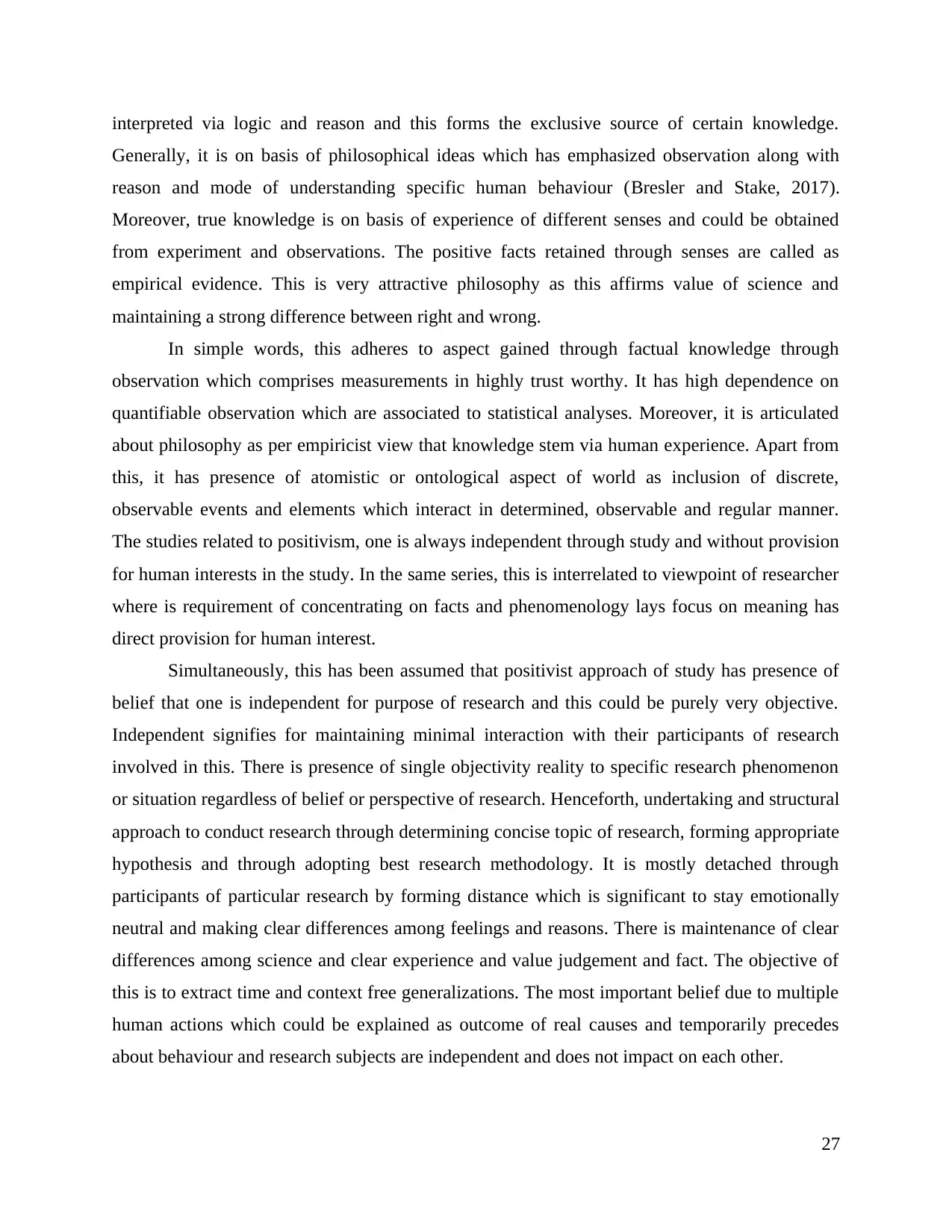
interpreted via logic and reason and this forms the exclusive source of certain knowledge.
Generally, it is on basis of philosophical ideas which has emphasized observation along with
reason and mode of understanding specific human behaviour (Bresler and Stake, 2017).
Moreover, true knowledge is on basis of experience of different senses and could be obtained
from experiment and observations. The positive facts retained through senses are called as
empirical evidence. This is very attractive philosophy as this affirms value of science and
maintaining a strong difference between right and wrong.
In simple words, this adheres to aspect gained through factual knowledge through
observation which comprises measurements in highly trust worthy. It has high dependence on
quantifiable observation which are associated to statistical analyses. Moreover, it is articulated
about philosophy as per empiricist view that knowledge stem via human experience. Apart from
this, it has presence of atomistic or ontological aspect of world as inclusion of discrete,
observable events and elements which interact in determined, observable and regular manner.
The studies related to positivism, one is always independent through study and without provision
for human interests in the study. In the same series, this is interrelated to viewpoint of researcher
where is requirement of concentrating on facts and phenomenology lays focus on meaning has
direct provision for human interest.
Simultaneously, this has been assumed that positivist approach of study has presence of
belief that one is independent for purpose of research and this could be purely very objective.
Independent signifies for maintaining minimal interaction with their participants of research
involved in this. There is presence of single objectivity reality to specific research phenomenon
or situation regardless of belief or perspective of research. Henceforth, undertaking and structural
approach to conduct research through determining concise topic of research, forming appropriate
hypothesis and through adopting best research methodology. It is mostly detached through
participants of particular research by forming distance which is significant to stay emotionally
neutral and making clear differences among feelings and reasons. There is maintenance of clear
differences among science and clear experience and value judgement and fact. The objective of
this is to extract time and context free generalizations. The most important belief due to multiple
human actions which could be explained as outcome of real causes and temporarily precedes
about behaviour and research subjects are independent and does not impact on each other.
27
Generally, it is on basis of philosophical ideas which has emphasized observation along with
reason and mode of understanding specific human behaviour (Bresler and Stake, 2017).
Moreover, true knowledge is on basis of experience of different senses and could be obtained
from experiment and observations. The positive facts retained through senses are called as
empirical evidence. This is very attractive philosophy as this affirms value of science and
maintaining a strong difference between right and wrong.
In simple words, this adheres to aspect gained through factual knowledge through
observation which comprises measurements in highly trust worthy. It has high dependence on
quantifiable observation which are associated to statistical analyses. Moreover, it is articulated
about philosophy as per empiricist view that knowledge stem via human experience. Apart from
this, it has presence of atomistic or ontological aspect of world as inclusion of discrete,
observable events and elements which interact in determined, observable and regular manner.
The studies related to positivism, one is always independent through study and without provision
for human interests in the study. In the same series, this is interrelated to viewpoint of researcher
where is requirement of concentrating on facts and phenomenology lays focus on meaning has
direct provision for human interest.
Simultaneously, this has been assumed that positivist approach of study has presence of
belief that one is independent for purpose of research and this could be purely very objective.
Independent signifies for maintaining minimal interaction with their participants of research
involved in this. There is presence of single objectivity reality to specific research phenomenon
or situation regardless of belief or perspective of research. Henceforth, undertaking and structural
approach to conduct research through determining concise topic of research, forming appropriate
hypothesis and through adopting best research methodology. It is mostly detached through
participants of particular research by forming distance which is significant to stay emotionally
neutral and making clear differences among feelings and reasons. There is maintenance of clear
differences among science and clear experience and value judgement and fact. The objective of
this is to extract time and context free generalizations. The most important belief due to multiple
human actions which could be explained as outcome of real causes and temporarily precedes
about behaviour and research subjects are independent and does not impact on each other.
27
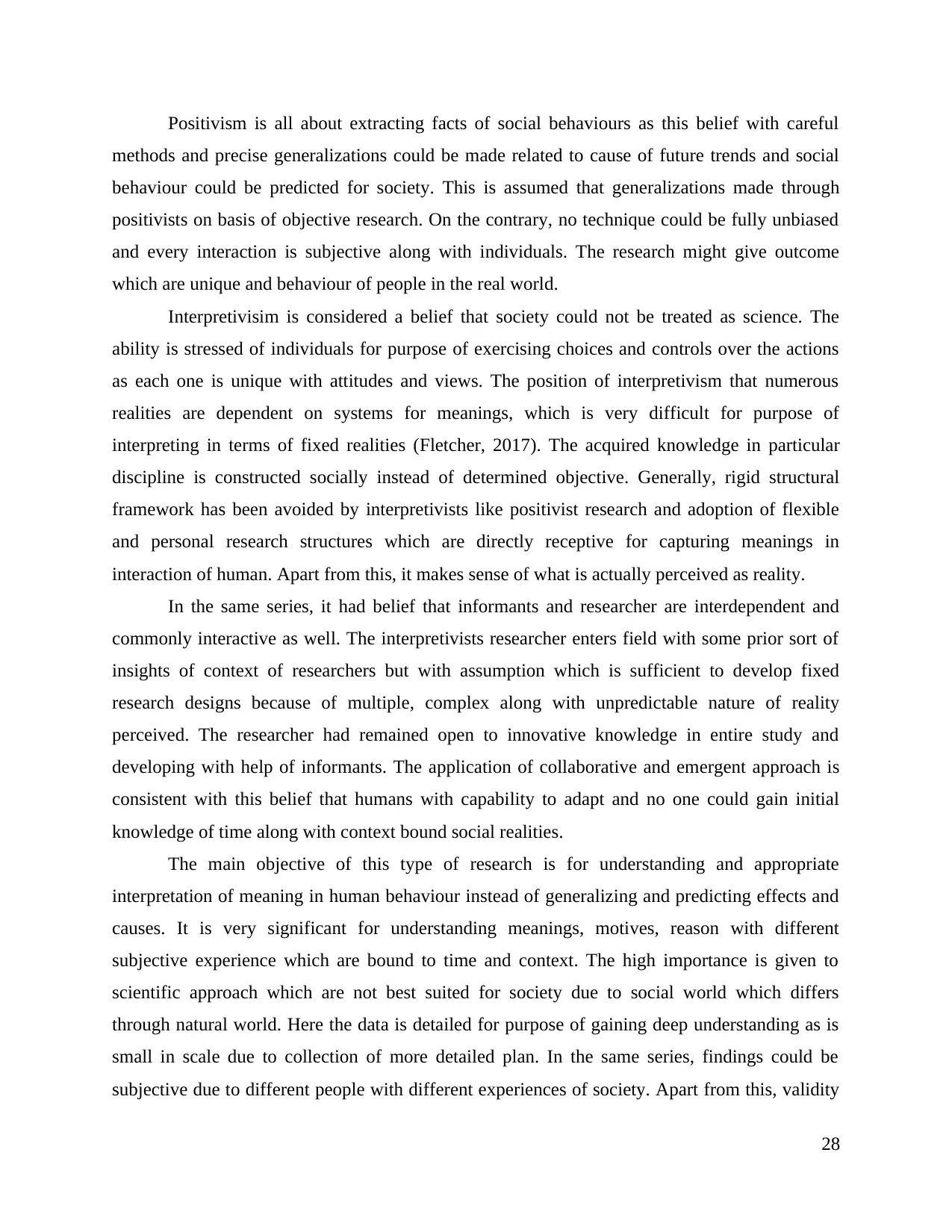
Positivism is all about extracting facts of social behaviours as this belief with careful
methods and precise generalizations could be made related to cause of future trends and social
behaviour could be predicted for society. This is assumed that generalizations made through
positivists on basis of objective research. On the contrary, no technique could be fully unbiased
and every interaction is subjective along with individuals. The research might give outcome
which are unique and behaviour of people in the real world.
Interpretivisim is considered a belief that society could not be treated as science. The
ability is stressed of individuals for purpose of exercising choices and controls over the actions
as each one is unique with attitudes and views. The position of interpretivism that numerous
realities are dependent on systems for meanings, which is very difficult for purpose of
interpreting in terms of fixed realities (Fletcher, 2017). The acquired knowledge in particular
discipline is constructed socially instead of determined objective. Generally, rigid structural
framework has been avoided by interpretivists like positivist research and adoption of flexible
and personal research structures which are directly receptive for capturing meanings in
interaction of human. Apart from this, it makes sense of what is actually perceived as reality.
In the same series, it had belief that informants and researcher are interdependent and
commonly interactive as well. The interpretivists researcher enters field with some prior sort of
insights of context of researchers but with assumption which is sufficient to develop fixed
research designs because of multiple, complex along with unpredictable nature of reality
perceived. The researcher had remained open to innovative knowledge in entire study and
developing with help of informants. The application of collaborative and emergent approach is
consistent with this belief that humans with capability to adapt and no one could gain initial
knowledge of time along with context bound social realities.
The main objective of this type of research is for understanding and appropriate
interpretation of meaning in human behaviour instead of generalizing and predicting effects and
causes. It is very significant for understanding meanings, motives, reason with different
subjective experience which are bound to time and context. The high importance is given to
scientific approach which are not best suited for society due to social world which differs
through natural world. Here the data is detailed for purpose of gaining deep understanding as is
small in scale due to collection of more detailed plan. In the same series, findings could be
subjective due to different people with different experiences of society. Apart from this, validity
28
methods and precise generalizations could be made related to cause of future trends and social
behaviour could be predicted for society. This is assumed that generalizations made through
positivists on basis of objective research. On the contrary, no technique could be fully unbiased
and every interaction is subjective along with individuals. The research might give outcome
which are unique and behaviour of people in the real world.
Interpretivisim is considered a belief that society could not be treated as science. The
ability is stressed of individuals for purpose of exercising choices and controls over the actions
as each one is unique with attitudes and views. The position of interpretivism that numerous
realities are dependent on systems for meanings, which is very difficult for purpose of
interpreting in terms of fixed realities (Fletcher, 2017). The acquired knowledge in particular
discipline is constructed socially instead of determined objective. Generally, rigid structural
framework has been avoided by interpretivists like positivist research and adoption of flexible
and personal research structures which are directly receptive for capturing meanings in
interaction of human. Apart from this, it makes sense of what is actually perceived as reality.
In the same series, it had belief that informants and researcher are interdependent and
commonly interactive as well. The interpretivists researcher enters field with some prior sort of
insights of context of researchers but with assumption which is sufficient to develop fixed
research designs because of multiple, complex along with unpredictable nature of reality
perceived. The researcher had remained open to innovative knowledge in entire study and
developing with help of informants. The application of collaborative and emergent approach is
consistent with this belief that humans with capability to adapt and no one could gain initial
knowledge of time along with context bound social realities.
The main objective of this type of research is for understanding and appropriate
interpretation of meaning in human behaviour instead of generalizing and predicting effects and
causes. It is very significant for understanding meanings, motives, reason with different
subjective experience which are bound to time and context. The high importance is given to
scientific approach which are not best suited for society due to social world which differs
through natural world. Here the data is detailed for purpose of gaining deep understanding as is
small in scale due to collection of more detailed plan. In the same series, findings could be
subjective due to different people with different experiences of society. Apart from this, validity
28
Paraphrase This Document
Need a fresh take? Get an instant paraphrase of this document with our AI Paraphraser

is given high weight and could be attained through collecting the qualitative data which is rich
and in depth (McCusker and Gunaydin, 2015). Research could be highly subjective with
perspective of researcher could be valuable to research. The most important aspect of human
behaviour, variables could not be controlled due to society and unpredictable people.
In this study, there is application of interpretivism approach because this reveals about
different subjective experiences. There is assumption of subjective account of society which
generates more appropriate data as it is on basis of naturalistic approach of data collection. This
is closely associated to qualitative research areas like leadership and analysis of factors, issues of
ethics, cross cultural differences could be studied. Here, relationship could be evaluated with
adoption of this interpretivism philosophy.
Research approach
The research approach is categorised in two types which are inductive and deductive
approach. The inductive research approach is also considered as inductive reasoning which
initiates through observations and theories proposed at end of entire research as outcomes of
different observations. Generally, it involves search for pattern through development of
explanations and observations, then it leans towards theories and for particular patterns via series
of hypothesis. In the same series, there would be absence of theories or hypothesis application in
inductive studies at initiating point of research and free in form of changing direction towards
study after commencement of process of research. This is very significant for stressing inductive
approach with absences of implication by disregarding theories during formulation of research
objectives and questions.
The objective of this approach is to produce meanings by collected data in order to
determine relationships and patterns to build a theory. This does not prevent researcher through
using the existing theory for purpose of formulating research questions is going to be explored. It
is on basis of learning through experience, The patterns resemblances along with regularities in
experiences as observed in order to attain conclusions. Generally, it begins with observations in
detailed manner of the world as this move for abstract ideas and generalizations. With adoption
of inductive approach, researcher would tend for developing empirical generalizations and
determining preliminary relationships with progress via the research. The most important aspect
is that no hypothesis is formed at first stage of research and not sure related to type and nature of
findings of research till the completion of study.
29
and in depth (McCusker and Gunaydin, 2015). Research could be highly subjective with
perspective of researcher could be valuable to research. The most important aspect of human
behaviour, variables could not be controlled due to society and unpredictable people.
In this study, there is application of interpretivism approach because this reveals about
different subjective experiences. There is assumption of subjective account of society which
generates more appropriate data as it is on basis of naturalistic approach of data collection. This
is closely associated to qualitative research areas like leadership and analysis of factors, issues of
ethics, cross cultural differences could be studied. Here, relationship could be evaluated with
adoption of this interpretivism philosophy.
Research approach
The research approach is categorised in two types which are inductive and deductive
approach. The inductive research approach is also considered as inductive reasoning which
initiates through observations and theories proposed at end of entire research as outcomes of
different observations. Generally, it involves search for pattern through development of
explanations and observations, then it leans towards theories and for particular patterns via series
of hypothesis. In the same series, there would be absence of theories or hypothesis application in
inductive studies at initiating point of research and free in form of changing direction towards
study after commencement of process of research. This is very significant for stressing inductive
approach with absences of implication by disregarding theories during formulation of research
objectives and questions.
The objective of this approach is to produce meanings by collected data in order to
determine relationships and patterns to build a theory. This does not prevent researcher through
using the existing theory for purpose of formulating research questions is going to be explored. It
is on basis of learning through experience, The patterns resemblances along with regularities in
experiences as observed in order to attain conclusions. Generally, it begins with observations in
detailed manner of the world as this move for abstract ideas and generalizations. With adoption
of inductive approach, researcher would tend for developing empirical generalizations and
determining preliminary relationships with progress via the research. The most important aspect
is that no hypothesis is formed at first stage of research and not sure related to type and nature of
findings of research till the completion of study.
29
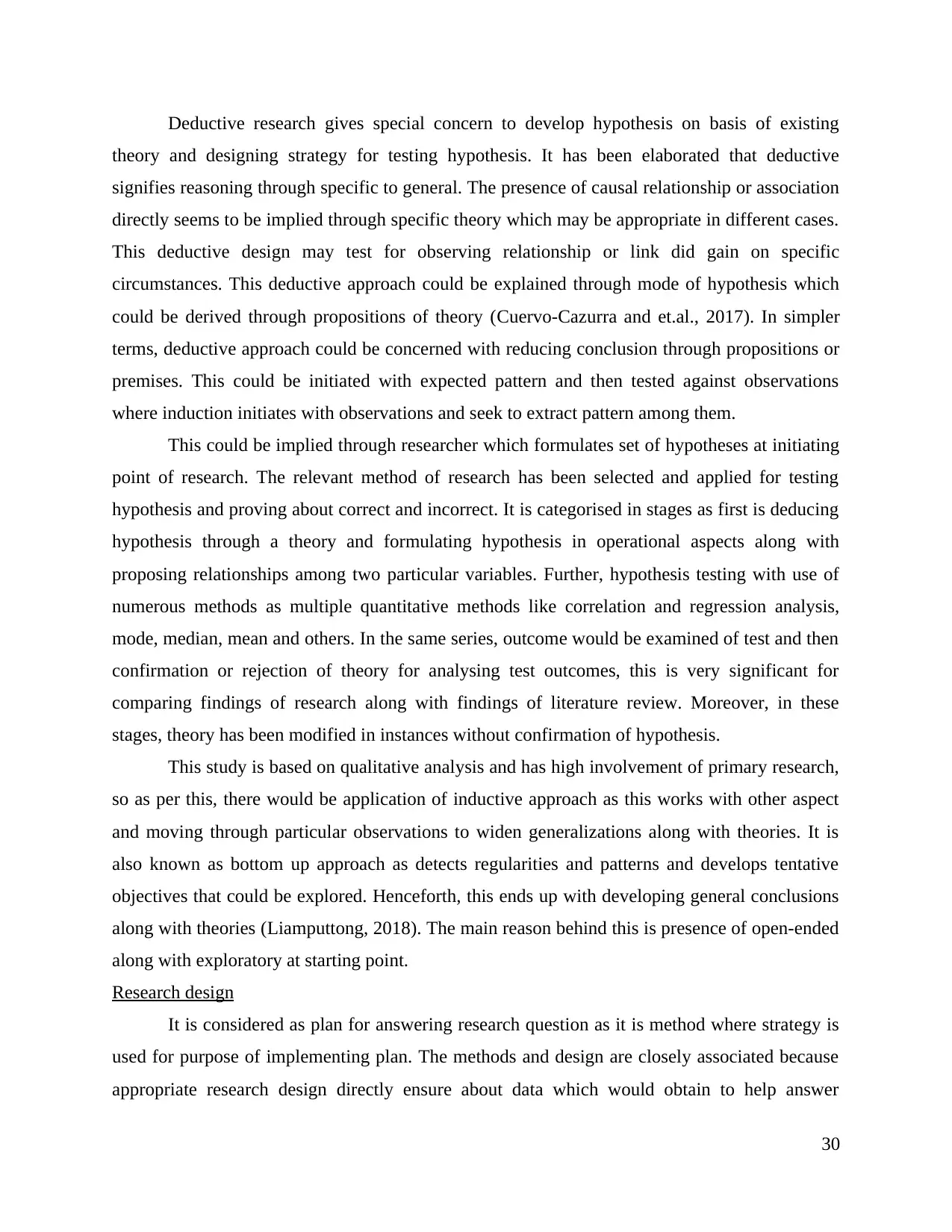
Deductive research gives special concern to develop hypothesis on basis of existing
theory and designing strategy for testing hypothesis. It has been elaborated that deductive
signifies reasoning through specific to general. The presence of causal relationship or association
directly seems to be implied through specific theory which may be appropriate in different cases.
This deductive design may test for observing relationship or link did gain on specific
circumstances. This deductive approach could be explained through mode of hypothesis which
could be derived through propositions of theory (Cuervo‐Cazurra and et.al., 2017). In simpler
terms, deductive approach could be concerned with reducing conclusion through propositions or
premises. This could be initiated with expected pattern and then tested against observations
where induction initiates with observations and seek to extract pattern among them.
This could be implied through researcher which formulates set of hypotheses at initiating
point of research. The relevant method of research has been selected and applied for testing
hypothesis and proving about correct and incorrect. It is categorised in stages as first is deducing
hypothesis through a theory and formulating hypothesis in operational aspects along with
proposing relationships among two particular variables. Further, hypothesis testing with use of
numerous methods as multiple quantitative methods like correlation and regression analysis,
mode, median, mean and others. In the same series, outcome would be examined of test and then
confirmation or rejection of theory for analysing test outcomes, this is very significant for
comparing findings of research along with findings of literature review. Moreover, in these
stages, theory has been modified in instances without confirmation of hypothesis.
This study is based on qualitative analysis and has high involvement of primary research,
so as per this, there would be application of inductive approach as this works with other aspect
and moving through particular observations to widen generalizations along with theories. It is
also known as bottom up approach as detects regularities and patterns and develops tentative
objectives that could be explored. Henceforth, this ends up with developing general conclusions
along with theories (Liamputtong, 2018). The main reason behind this is presence of open-ended
along with exploratory at starting point.
Research design
It is considered as plan for answering research question as it is method where strategy is
used for purpose of implementing plan. The methods and design are closely associated because
appropriate research design directly ensure about data which would obtain to help answer
30
theory and designing strategy for testing hypothesis. It has been elaborated that deductive
signifies reasoning through specific to general. The presence of causal relationship or association
directly seems to be implied through specific theory which may be appropriate in different cases.
This deductive design may test for observing relationship or link did gain on specific
circumstances. This deductive approach could be explained through mode of hypothesis which
could be derived through propositions of theory (Cuervo‐Cazurra and et.al., 2017). In simpler
terms, deductive approach could be concerned with reducing conclusion through propositions or
premises. This could be initiated with expected pattern and then tested against observations
where induction initiates with observations and seek to extract pattern among them.
This could be implied through researcher which formulates set of hypotheses at initiating
point of research. The relevant method of research has been selected and applied for testing
hypothesis and proving about correct and incorrect. It is categorised in stages as first is deducing
hypothesis through a theory and formulating hypothesis in operational aspects along with
proposing relationships among two particular variables. Further, hypothesis testing with use of
numerous methods as multiple quantitative methods like correlation and regression analysis,
mode, median, mean and others. In the same series, outcome would be examined of test and then
confirmation or rejection of theory for analysing test outcomes, this is very significant for
comparing findings of research along with findings of literature review. Moreover, in these
stages, theory has been modified in instances without confirmation of hypothesis.
This study is based on qualitative analysis and has high involvement of primary research,
so as per this, there would be application of inductive approach as this works with other aspect
and moving through particular observations to widen generalizations along with theories. It is
also known as bottom up approach as detects regularities and patterns and develops tentative
objectives that could be explored. Henceforth, this ends up with developing general conclusions
along with theories (Liamputtong, 2018). The main reason behind this is presence of open-ended
along with exploratory at starting point.
Research design
It is considered as plan for answering research question as it is method where strategy is
used for purpose of implementing plan. The methods and design are closely associated because
appropriate research design directly ensure about data which would obtain to help answer
30

question in effective manner. It is categorised in different types such as explanatory, descriptive,
diagnostic and experimental research design. The explanatory research design has presence of
individual's imaginations along with ideas. In real terms, it is on basis of personal judgement and
gaining information related to something. It is all about unexplored situation and up brings
where is no need of formulating hypothesis. The other is diagnostic research design where
researcher extracts root causes of problem along with description of factors which influences the
problematic situation. This is problem solving research design which comprises mainly
emergence, diagnosis, solution and suggestions for solution of problem.
The experimental research design, uses natural science but this is unique in social
sciences. The behaviour of human could not be measured via test tubes along microscopes. The
method of experiment is used through social researcher in that type of research design. The
group is directly subjected to experiment such as independent variables where other is replicated
as control group known as dependent variable. The obtained result through comparisons of both
the groups. Thus, both have presence of cause and effect relationship among each other.
Simultaneously, descriptive research design replicates about interest to describe specific situation
or phenomena under the study. This is theoretical type of design is on basis of collection,
presentation and designing of the data collected.
The descriptive design covers the features of people, materials, socio-economics features
like education, marital status, income and age etc. Further, qualitative nature of data is mostly
gathered such as beliefs, knowledge, attitude, opinions and beliefs of people. It ascertains
prevailing conditions of facts in specific group or case under study. The conditions or variables
studied in specific descriptive research which is not controlled usually.
With reference to this study, there would be application of descriptive research design
because it helps in contributing to the formulation of principles along with generalizations in
behavioural sciences. It helps in contributing establishment of standard behaviour, norms of
conduct along with performance. The most important aspect is that is provides a basis for
decision-making and even this reveals issues and abnormal conditions so that its remedial
measures might be instituted.
31
diagnostic and experimental research design. The explanatory research design has presence of
individual's imaginations along with ideas. In real terms, it is on basis of personal judgement and
gaining information related to something. It is all about unexplored situation and up brings
where is no need of formulating hypothesis. The other is diagnostic research design where
researcher extracts root causes of problem along with description of factors which influences the
problematic situation. This is problem solving research design which comprises mainly
emergence, diagnosis, solution and suggestions for solution of problem.
The experimental research design, uses natural science but this is unique in social
sciences. The behaviour of human could not be measured via test tubes along microscopes. The
method of experiment is used through social researcher in that type of research design. The
group is directly subjected to experiment such as independent variables where other is replicated
as control group known as dependent variable. The obtained result through comparisons of both
the groups. Thus, both have presence of cause and effect relationship among each other.
Simultaneously, descriptive research design replicates about interest to describe specific situation
or phenomena under the study. This is theoretical type of design is on basis of collection,
presentation and designing of the data collected.
The descriptive design covers the features of people, materials, socio-economics features
like education, marital status, income and age etc. Further, qualitative nature of data is mostly
gathered such as beliefs, knowledge, attitude, opinions and beliefs of people. It ascertains
prevailing conditions of facts in specific group or case under study. The conditions or variables
studied in specific descriptive research which is not controlled usually.
With reference to this study, there would be application of descriptive research design
because it helps in contributing to the formulation of principles along with generalizations in
behavioural sciences. It helps in contributing establishment of standard behaviour, norms of
conduct along with performance. The most important aspect is that is provides a basis for
decision-making and even this reveals issues and abnormal conditions so that its remedial
measures might be instituted.
31
Secure Best Marks with AI Grader
Need help grading? Try our AI Grader for instant feedback on your assignments.
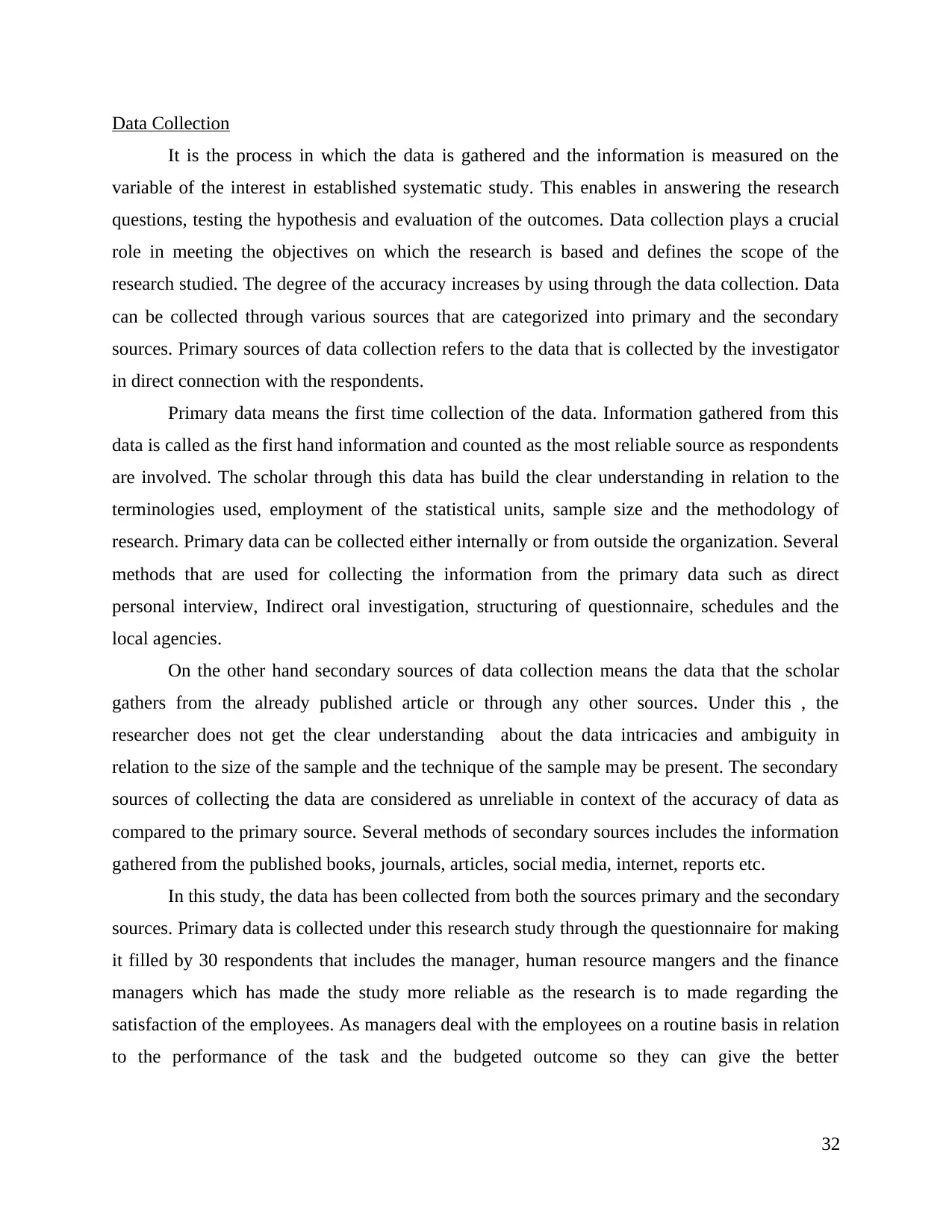
Data Collection
It is the process in which the data is gathered and the information is measured on the
variable of the interest in established systematic study. This enables in answering the research
questions, testing the hypothesis and evaluation of the outcomes. Data collection plays a crucial
role in meeting the objectives on which the research is based and defines the scope of the
research studied. The degree of the accuracy increases by using through the data collection. Data
can be collected through various sources that are categorized into primary and the secondary
sources. Primary sources of data collection refers to the data that is collected by the investigator
in direct connection with the respondents.
Primary data means the first time collection of the data. Information gathered from this
data is called as the first hand information and counted as the most reliable source as respondents
are involved. The scholar through this data has build the clear understanding in relation to the
terminologies used, employment of the statistical units, sample size and the methodology of
research. Primary data can be collected either internally or from outside the organization. Several
methods that are used for collecting the information from the primary data such as direct
personal interview, Indirect oral investigation, structuring of questionnaire, schedules and the
local agencies.
On the other hand secondary sources of data collection means the data that the scholar
gathers from the already published article or through any other sources. Under this , the
researcher does not get the clear understanding about the data intricacies and ambiguity in
relation to the size of the sample and the technique of the sample may be present. The secondary
sources of collecting the data are considered as unreliable in context of the accuracy of data as
compared to the primary source. Several methods of secondary sources includes the information
gathered from the published books, journals, articles, social media, internet, reports etc.
In this study, the data has been collected from both the sources primary and the secondary
sources. Primary data is collected under this research study through the questionnaire for making
it filled by 30 respondents that includes the manager, human resource mangers and the finance
managers which has made the study more reliable as the research is to made regarding the
satisfaction of the employees. As managers deal with the employees on a routine basis in relation
to the performance of the task and the budgeted outcome so they can give the better
32
It is the process in which the data is gathered and the information is measured on the
variable of the interest in established systematic study. This enables in answering the research
questions, testing the hypothesis and evaluation of the outcomes. Data collection plays a crucial
role in meeting the objectives on which the research is based and defines the scope of the
research studied. The degree of the accuracy increases by using through the data collection. Data
can be collected through various sources that are categorized into primary and the secondary
sources. Primary sources of data collection refers to the data that is collected by the investigator
in direct connection with the respondents.
Primary data means the first time collection of the data. Information gathered from this
data is called as the first hand information and counted as the most reliable source as respondents
are involved. The scholar through this data has build the clear understanding in relation to the
terminologies used, employment of the statistical units, sample size and the methodology of
research. Primary data can be collected either internally or from outside the organization. Several
methods that are used for collecting the information from the primary data such as direct
personal interview, Indirect oral investigation, structuring of questionnaire, schedules and the
local agencies.
On the other hand secondary sources of data collection means the data that the scholar
gathers from the already published article or through any other sources. Under this , the
researcher does not get the clear understanding about the data intricacies and ambiguity in
relation to the size of the sample and the technique of the sample may be present. The secondary
sources of collecting the data are considered as unreliable in context of the accuracy of data as
compared to the primary source. Several methods of secondary sources includes the information
gathered from the published books, journals, articles, social media, internet, reports etc.
In this study, the data has been collected from both the sources primary and the secondary
sources. Primary data is collected under this research study through the questionnaire for making
it filled by 30 respondents that includes the manager, human resource mangers and the finance
managers which has made the study more reliable as the research is to made regarding the
satisfaction of the employees. As managers deal with the employees on a routine basis in relation
to the performance of the task and the budgeted outcome so they can give the better
32
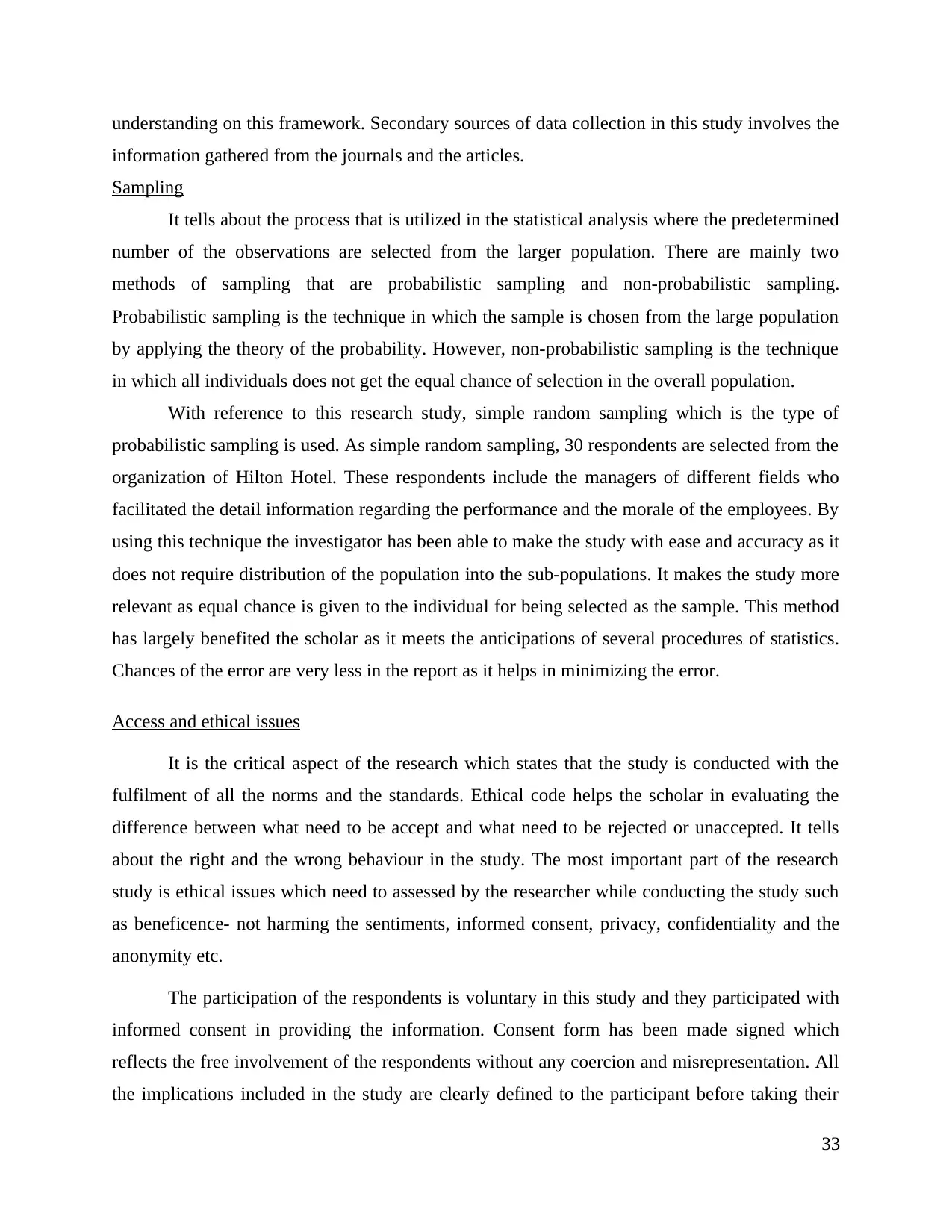
understanding on this framework. Secondary sources of data collection in this study involves the
information gathered from the journals and the articles.
Sampling
It tells about the process that is utilized in the statistical analysis where the predetermined
number of the observations are selected from the larger population. There are mainly two
methods of sampling that are probabilistic sampling and non-probabilistic sampling.
Probabilistic sampling is the technique in which the sample is chosen from the large population
by applying the theory of the probability. However, non-probabilistic sampling is the technique
in which all individuals does not get the equal chance of selection in the overall population.
With reference to this research study, simple random sampling which is the type of
probabilistic sampling is used. As simple random sampling, 30 respondents are selected from the
organization of Hilton Hotel. These respondents include the managers of different fields who
facilitated the detail information regarding the performance and the morale of the employees. By
using this technique the investigator has been able to make the study with ease and accuracy as it
does not require distribution of the population into the sub-populations. It makes the study more
relevant as equal chance is given to the individual for being selected as the sample. This method
has largely benefited the scholar as it meets the anticipations of several procedures of statistics.
Chances of the error are very less in the report as it helps in minimizing the error.
Access and ethical issues
It is the critical aspect of the research which states that the study is conducted with the
fulfilment of all the norms and the standards. Ethical code helps the scholar in evaluating the
difference between what need to be accept and what need to be rejected or unaccepted. It tells
about the right and the wrong behaviour in the study. The most important part of the research
study is ethical issues which need to assessed by the researcher while conducting the study such
as beneficence- not harming the sentiments, informed consent, privacy, confidentiality and the
anonymity etc.
The participation of the respondents is voluntary in this study and they participated with
informed consent in providing the information. Consent form has been made signed which
reflects the free involvement of the respondents without any coercion and misrepresentation. All
the implications included in the study are clearly defined to the participant before taking their
33
information gathered from the journals and the articles.
Sampling
It tells about the process that is utilized in the statistical analysis where the predetermined
number of the observations are selected from the larger population. There are mainly two
methods of sampling that are probabilistic sampling and non-probabilistic sampling.
Probabilistic sampling is the technique in which the sample is chosen from the large population
by applying the theory of the probability. However, non-probabilistic sampling is the technique
in which all individuals does not get the equal chance of selection in the overall population.
With reference to this research study, simple random sampling which is the type of
probabilistic sampling is used. As simple random sampling, 30 respondents are selected from the
organization of Hilton Hotel. These respondents include the managers of different fields who
facilitated the detail information regarding the performance and the morale of the employees. By
using this technique the investigator has been able to make the study with ease and accuracy as it
does not require distribution of the population into the sub-populations. It makes the study more
relevant as equal chance is given to the individual for being selected as the sample. This method
has largely benefited the scholar as it meets the anticipations of several procedures of statistics.
Chances of the error are very less in the report as it helps in minimizing the error.
Access and ethical issues
It is the critical aspect of the research which states that the study is conducted with the
fulfilment of all the norms and the standards. Ethical code helps the scholar in evaluating the
difference between what need to be accept and what need to be rejected or unaccepted. It tells
about the right and the wrong behaviour in the study. The most important part of the research
study is ethical issues which need to assessed by the researcher while conducting the study such
as beneficence- not harming the sentiments, informed consent, privacy, confidentiality and the
anonymity etc.
The participation of the respondents is voluntary in this study and they participated with
informed consent in providing the information. Consent form has been made signed which
reflects the free involvement of the respondents without any coercion and misrepresentation. All
the implications included in the study are clearly defined to the participant before taking their
33
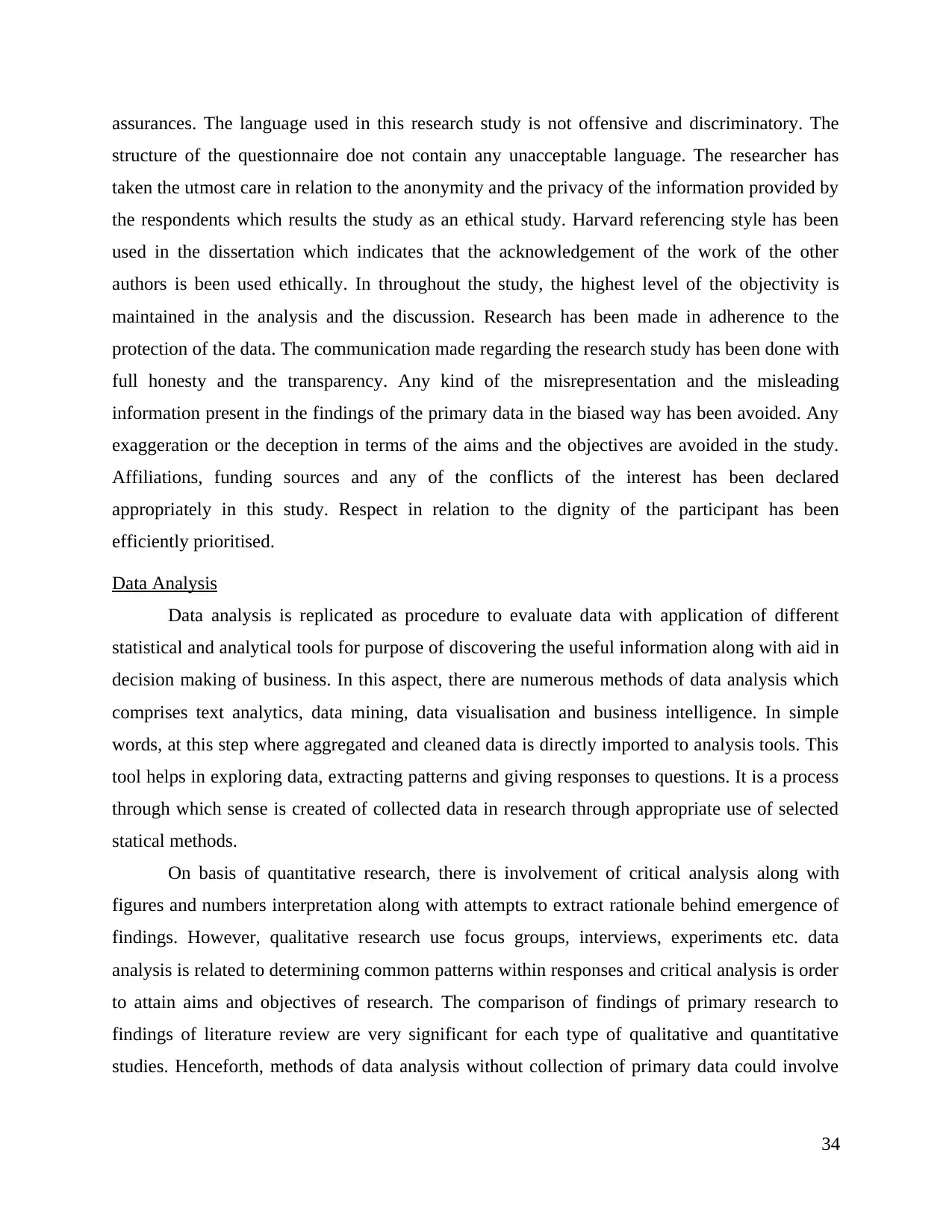
assurances. The language used in this research study is not offensive and discriminatory. The
structure of the questionnaire doe not contain any unacceptable language. The researcher has
taken the utmost care in relation to the anonymity and the privacy of the information provided by
the respondents which results the study as an ethical study. Harvard referencing style has been
used in the dissertation which indicates that the acknowledgement of the work of the other
authors is been used ethically. In throughout the study, the highest level of the objectivity is
maintained in the analysis and the discussion. Research has been made in adherence to the
protection of the data. The communication made regarding the research study has been done with
full honesty and the transparency. Any kind of the misrepresentation and the misleading
information present in the findings of the primary data in the biased way has been avoided. Any
exaggeration or the deception in terms of the aims and the objectives are avoided in the study.
Affiliations, funding sources and any of the conflicts of the interest has been declared
appropriately in this study. Respect in relation to the dignity of the participant has been
efficiently prioritised.
Data Analysis
Data analysis is replicated as procedure to evaluate data with application of different
statistical and analytical tools for purpose of discovering the useful information along with aid in
decision making of business. In this aspect, there are numerous methods of data analysis which
comprises text analytics, data mining, data visualisation and business intelligence. In simple
words, at this step where aggregated and cleaned data is directly imported to analysis tools. This
tool helps in exploring data, extracting patterns and giving responses to questions. It is a process
through which sense is created of collected data in research through appropriate use of selected
statical methods.
On basis of quantitative research, there is involvement of critical analysis along with
figures and numbers interpretation along with attempts to extract rationale behind emergence of
findings. However, qualitative research use focus groups, interviews, experiments etc. data
analysis is related to determining common patterns within responses and critical analysis is order
to attain aims and objectives of research. The comparison of findings of primary research to
findings of literature review are very significant for each type of qualitative and quantitative
studies. Henceforth, methods of data analysis without collection of primary data could involve
34
structure of the questionnaire doe not contain any unacceptable language. The researcher has
taken the utmost care in relation to the anonymity and the privacy of the information provided by
the respondents which results the study as an ethical study. Harvard referencing style has been
used in the dissertation which indicates that the acknowledgement of the work of the other
authors is been used ethically. In throughout the study, the highest level of the objectivity is
maintained in the analysis and the discussion. Research has been made in adherence to the
protection of the data. The communication made regarding the research study has been done with
full honesty and the transparency. Any kind of the misrepresentation and the misleading
information present in the findings of the primary data in the biased way has been avoided. Any
exaggeration or the deception in terms of the aims and the objectives are avoided in the study.
Affiliations, funding sources and any of the conflicts of the interest has been declared
appropriately in this study. Respect in relation to the dignity of the participant has been
efficiently prioritised.
Data Analysis
Data analysis is replicated as procedure to evaluate data with application of different
statistical and analytical tools for purpose of discovering the useful information along with aid in
decision making of business. In this aspect, there are numerous methods of data analysis which
comprises text analytics, data mining, data visualisation and business intelligence. In simple
words, at this step where aggregated and cleaned data is directly imported to analysis tools. This
tool helps in exploring data, extracting patterns and giving responses to questions. It is a process
through which sense is created of collected data in research through appropriate use of selected
statical methods.
On basis of quantitative research, there is involvement of critical analysis along with
figures and numbers interpretation along with attempts to extract rationale behind emergence of
findings. However, qualitative research use focus groups, interviews, experiments etc. data
analysis is related to determining common patterns within responses and critical analysis is order
to attain aims and objectives of research. The comparison of findings of primary research to
findings of literature review are very significant for each type of qualitative and quantitative
studies. Henceforth, methods of data analysis without collection of primary data could involve
34
Paraphrase This Document
Need a fresh take? Get an instant paraphrase of this document with our AI Paraphraser
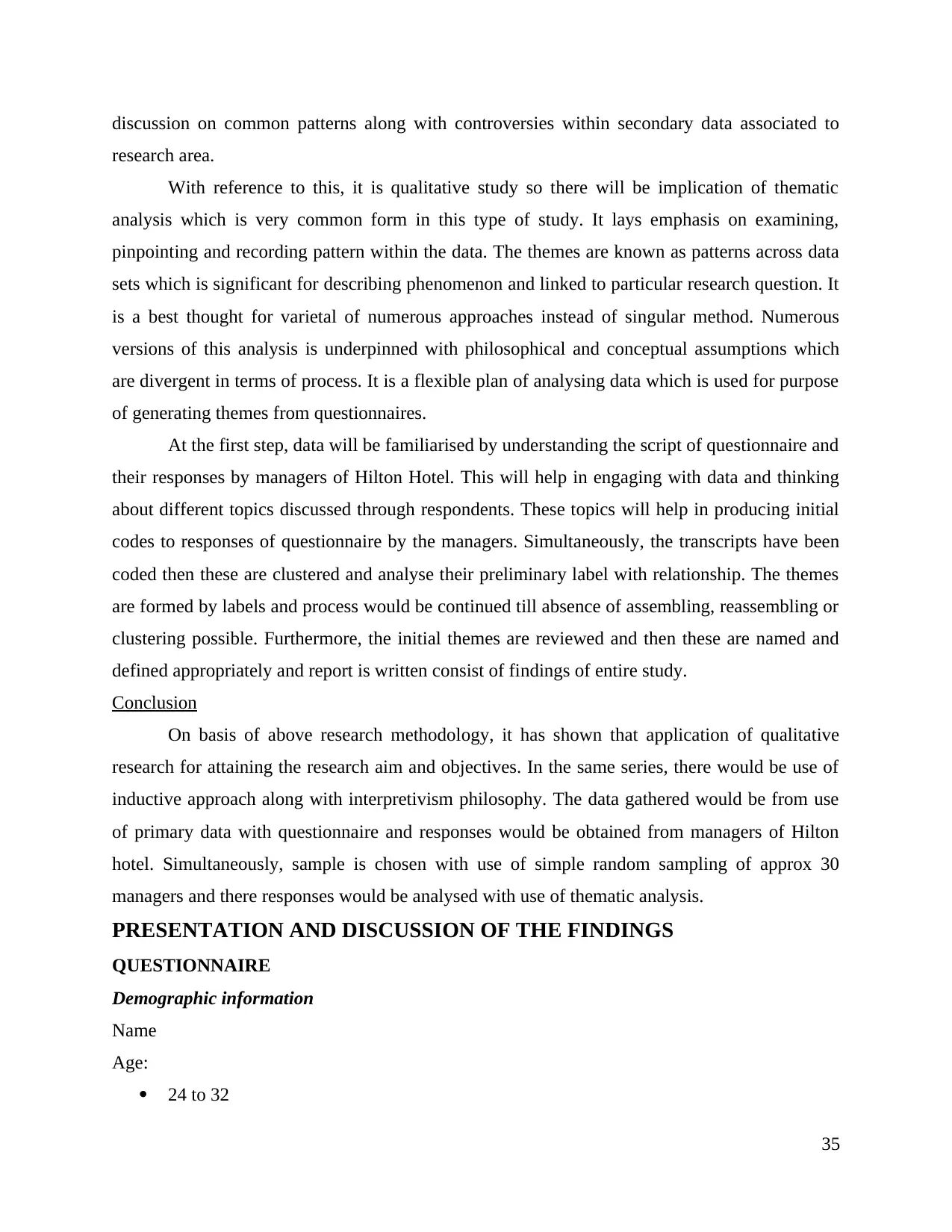
discussion on common patterns along with controversies within secondary data associated to
research area.
With reference to this, it is qualitative study so there will be implication of thematic
analysis which is very common form in this type of study. It lays emphasis on examining,
pinpointing and recording pattern within the data. The themes are known as patterns across data
sets which is significant for describing phenomenon and linked to particular research question. It
is a best thought for varietal of numerous approaches instead of singular method. Numerous
versions of this analysis is underpinned with philosophical and conceptual assumptions which
are divergent in terms of process. It is a flexible plan of analysing data which is used for purpose
of generating themes from questionnaires.
At the first step, data will be familiarised by understanding the script of questionnaire and
their responses by managers of Hilton Hotel. This will help in engaging with data and thinking
about different topics discussed through respondents. These topics will help in producing initial
codes to responses of questionnaire by the managers. Simultaneously, the transcripts have been
coded then these are clustered and analyse their preliminary label with relationship. The themes
are formed by labels and process would be continued till absence of assembling, reassembling or
clustering possible. Furthermore, the initial themes are reviewed and then these are named and
defined appropriately and report is written consist of findings of entire study.
Conclusion
On basis of above research methodology, it has shown that application of qualitative
research for attaining the research aim and objectives. In the same series, there would be use of
inductive approach along with interpretivism philosophy. The data gathered would be from use
of primary data with questionnaire and responses would be obtained from managers of Hilton
hotel. Simultaneously, sample is chosen with use of simple random sampling of approx 30
managers and there responses would be analysed with use of thematic analysis.
PRESENTATION AND DISCUSSION OF THE FINDINGS
QUESTIONNAIRE
Demographic information
Name
Age:
24 to 32
35
research area.
With reference to this, it is qualitative study so there will be implication of thematic
analysis which is very common form in this type of study. It lays emphasis on examining,
pinpointing and recording pattern within the data. The themes are known as patterns across data
sets which is significant for describing phenomenon and linked to particular research question. It
is a best thought for varietal of numerous approaches instead of singular method. Numerous
versions of this analysis is underpinned with philosophical and conceptual assumptions which
are divergent in terms of process. It is a flexible plan of analysing data which is used for purpose
of generating themes from questionnaires.
At the first step, data will be familiarised by understanding the script of questionnaire and
their responses by managers of Hilton Hotel. This will help in engaging with data and thinking
about different topics discussed through respondents. These topics will help in producing initial
codes to responses of questionnaire by the managers. Simultaneously, the transcripts have been
coded then these are clustered and analyse their preliminary label with relationship. The themes
are formed by labels and process would be continued till absence of assembling, reassembling or
clustering possible. Furthermore, the initial themes are reviewed and then these are named and
defined appropriately and report is written consist of findings of entire study.
Conclusion
On basis of above research methodology, it has shown that application of qualitative
research for attaining the research aim and objectives. In the same series, there would be use of
inductive approach along with interpretivism philosophy. The data gathered would be from use
of primary data with questionnaire and responses would be obtained from managers of Hilton
hotel. Simultaneously, sample is chosen with use of simple random sampling of approx 30
managers and there responses would be analysed with use of thematic analysis.
PRESENTATION AND DISCUSSION OF THE FINDINGS
QUESTIONNAIRE
Demographic information
Name
Age:
24 to 32
35
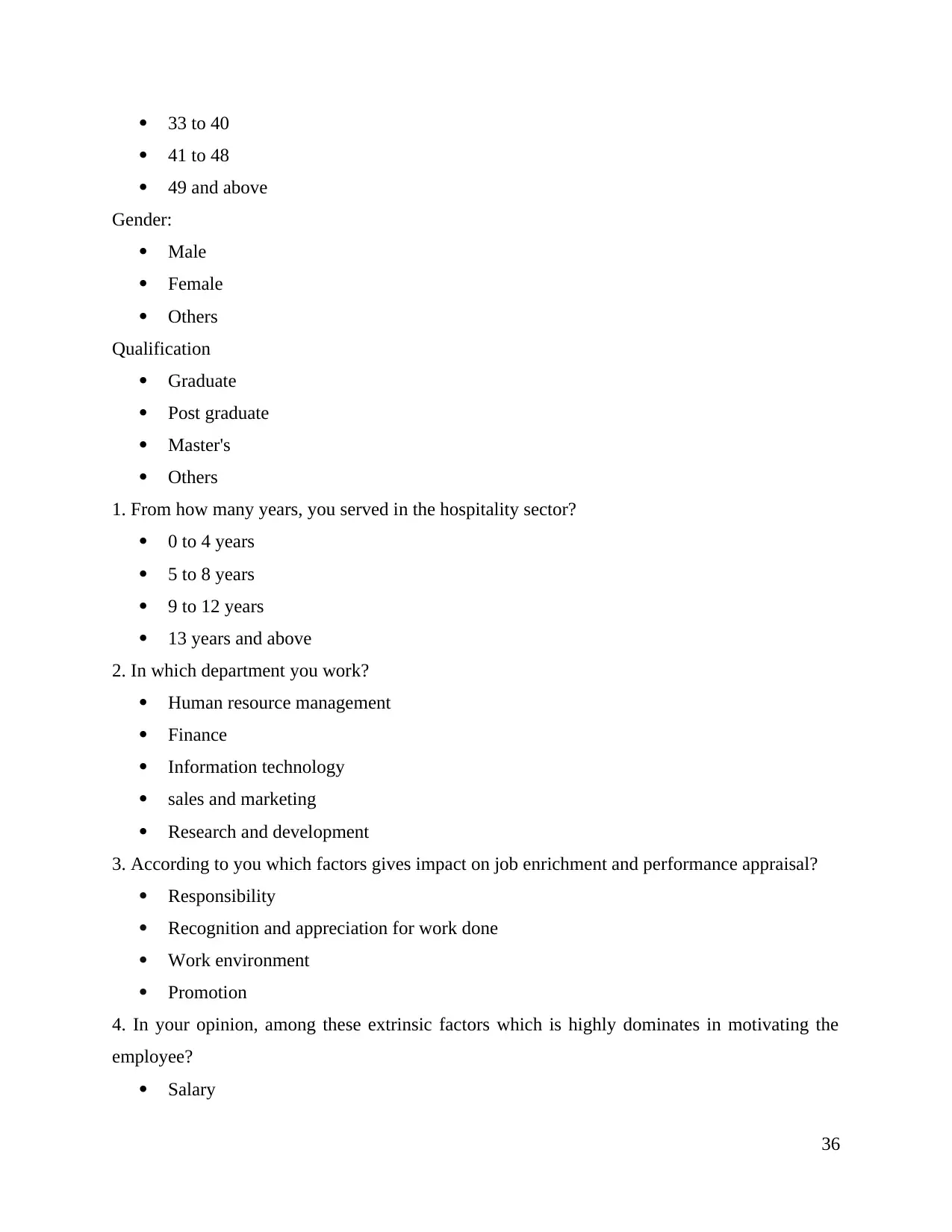
33 to 40
41 to 48
49 and above
Gender:
Male
Female
Others
Qualification
Graduate
Post graduate
Master's
Others
1. From how many years, you served in the hospitality sector?
0 to 4 years
5 to 8 years
9 to 12 years
13 years and above
2. In which department you work?
Human resource management
Finance
Information technology
sales and marketing
Research and development
3. According to you which factors gives impact on job enrichment and performance appraisal?
Responsibility
Recognition and appreciation for work done
Work environment
Promotion
4. In your opinion, among these extrinsic factors which is highly dominates in motivating the
employee?
Salary
36
41 to 48
49 and above
Gender:
Male
Female
Others
Qualification
Graduate
Post graduate
Master's
Others
1. From how many years, you served in the hospitality sector?
0 to 4 years
5 to 8 years
9 to 12 years
13 years and above
2. In which department you work?
Human resource management
Finance
Information technology
sales and marketing
Research and development
3. According to you which factors gives impact on job enrichment and performance appraisal?
Responsibility
Recognition and appreciation for work done
Work environment
Promotion
4. In your opinion, among these extrinsic factors which is highly dominates in motivating the
employee?
Salary
36
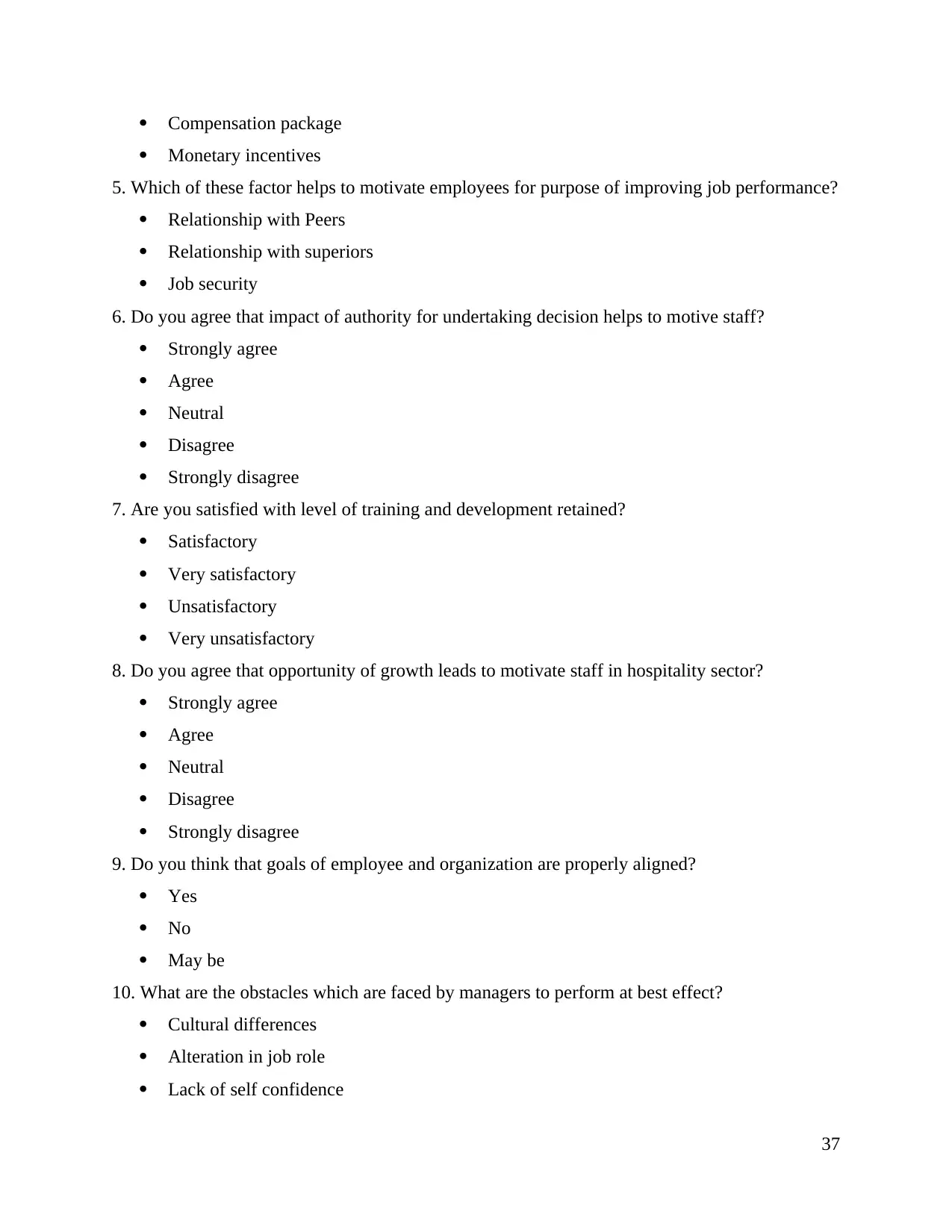
Compensation package
Monetary incentives
5. Which of these factor helps to motivate employees for purpose of improving job performance?
Relationship with Peers
Relationship with superiors
Job security
6. Do you agree that impact of authority for undertaking decision helps to motive staff?
Strongly agree
Agree
Neutral
Disagree
Strongly disagree
7. Are you satisfied with level of training and development retained?
Satisfactory
Very satisfactory
Unsatisfactory
Very unsatisfactory
8. Do you agree that opportunity of growth leads to motivate staff in hospitality sector?
Strongly agree
Agree
Neutral
Disagree
Strongly disagree
9. Do you think that goals of employee and organization are properly aligned?
Yes
No
May be
10. What are the obstacles which are faced by managers to perform at best effect?
Cultural differences
Alteration in job role
Lack of self confidence
37
Monetary incentives
5. Which of these factor helps to motivate employees for purpose of improving job performance?
Relationship with Peers
Relationship with superiors
Job security
6. Do you agree that impact of authority for undertaking decision helps to motive staff?
Strongly agree
Agree
Neutral
Disagree
Strongly disagree
7. Are you satisfied with level of training and development retained?
Satisfactory
Very satisfactory
Unsatisfactory
Very unsatisfactory
8. Do you agree that opportunity of growth leads to motivate staff in hospitality sector?
Strongly agree
Agree
Neutral
Disagree
Strongly disagree
9. Do you think that goals of employee and organization are properly aligned?
Yes
No
May be
10. What are the obstacles which are faced by managers to perform at best effect?
Cultural differences
Alteration in job role
Lack of self confidence
37
Secure Best Marks with AI Grader
Need help grading? Try our AI Grader for instant feedback on your assignments.

Bias by top management
11. Do you agree that recent performance appraisal helped you to gain understanding that what
has to be done at different performance level?
Strongly agree
Agree
Neutral
Disagree
Strongly disagree
12. Any further suggestions?
---------------------------------------------------------------------------------------------------------------------
-------------------------------------------------------------------------------------------------------------------
Findings
Demographic information
Age
Particulars Respondents % of responses
24 to 32 7 23.33%
33 to 40 14 46.67%
41 to 48 5 16.67%
49 and above 4 13.33%
Total 30 100.00%
The above table is stating range of age of the respondents or sample size of Hilton
managers. It is clearly viewed that majority of respondents within 33 to 40 by 47%, followed by
24 to 32 of 23.33%, 41 to 48 by approx 17% and remaining in senior category as 49 and above
by 13.33%.
Gender
Particulars Respondents % of responses
Male 18 60.00%
Female 12 40.00%
Others 0 0.00%
Total 30 100.00%
38
11. Do you agree that recent performance appraisal helped you to gain understanding that what
has to be done at different performance level?
Strongly agree
Agree
Neutral
Disagree
Strongly disagree
12. Any further suggestions?
---------------------------------------------------------------------------------------------------------------------
-------------------------------------------------------------------------------------------------------------------
Findings
Demographic information
Age
Particulars Respondents % of responses
24 to 32 7 23.33%
33 to 40 14 46.67%
41 to 48 5 16.67%
49 and above 4 13.33%
Total 30 100.00%
The above table is stating range of age of the respondents or sample size of Hilton
managers. It is clearly viewed that majority of respondents within 33 to 40 by 47%, followed by
24 to 32 of 23.33%, 41 to 48 by approx 17% and remaining in senior category as 49 and above
by 13.33%.
Gender
Particulars Respondents % of responses
Male 18 60.00%
Female 12 40.00%
Others 0 0.00%
Total 30 100.00%
38

Interpretation: The above table is showing gender category of respondents in as 60% of
them belongs to male category and remaining 40% to female.
Education
Particulars Respondents % of responses
Graduate 6 20.00%
Post graduate 15 50.00%
Master's 5 16.67%
Others 4 13.33%
Total 30 100.00%
Interpretation: The above table is stating qualifications and skills of responses which is
very important for the study because, qualified and experience candidates gives the best outcome
related to job satisfaction and employee motivation. It has been clearly viewed that 50% of the
candidates were post graduate in this group.
Theme 1: Served in the hospitality sector
Particulars Respondents % of responses
0 to 4 years 8 26.67%
5 to 8 years 13 43.33%
9 to 12 years 6 20.00%
13 years and above 3 10.00%
Total 30 100.00%
39
them belongs to male category and remaining 40% to female.
Education
Particulars Respondents % of responses
Graduate 6 20.00%
Post graduate 15 50.00%
Master's 5 16.67%
Others 4 13.33%
Total 30 100.00%
Interpretation: The above table is stating qualifications and skills of responses which is
very important for the study because, qualified and experience candidates gives the best outcome
related to job satisfaction and employee motivation. It has been clearly viewed that 50% of the
candidates were post graduate in this group.
Theme 1: Served in the hospitality sector
Particulars Respondents % of responses
0 to 4 years 8 26.67%
5 to 8 years 13 43.33%
9 to 12 years 6 20.00%
13 years and above 3 10.00%
Total 30 100.00%
39
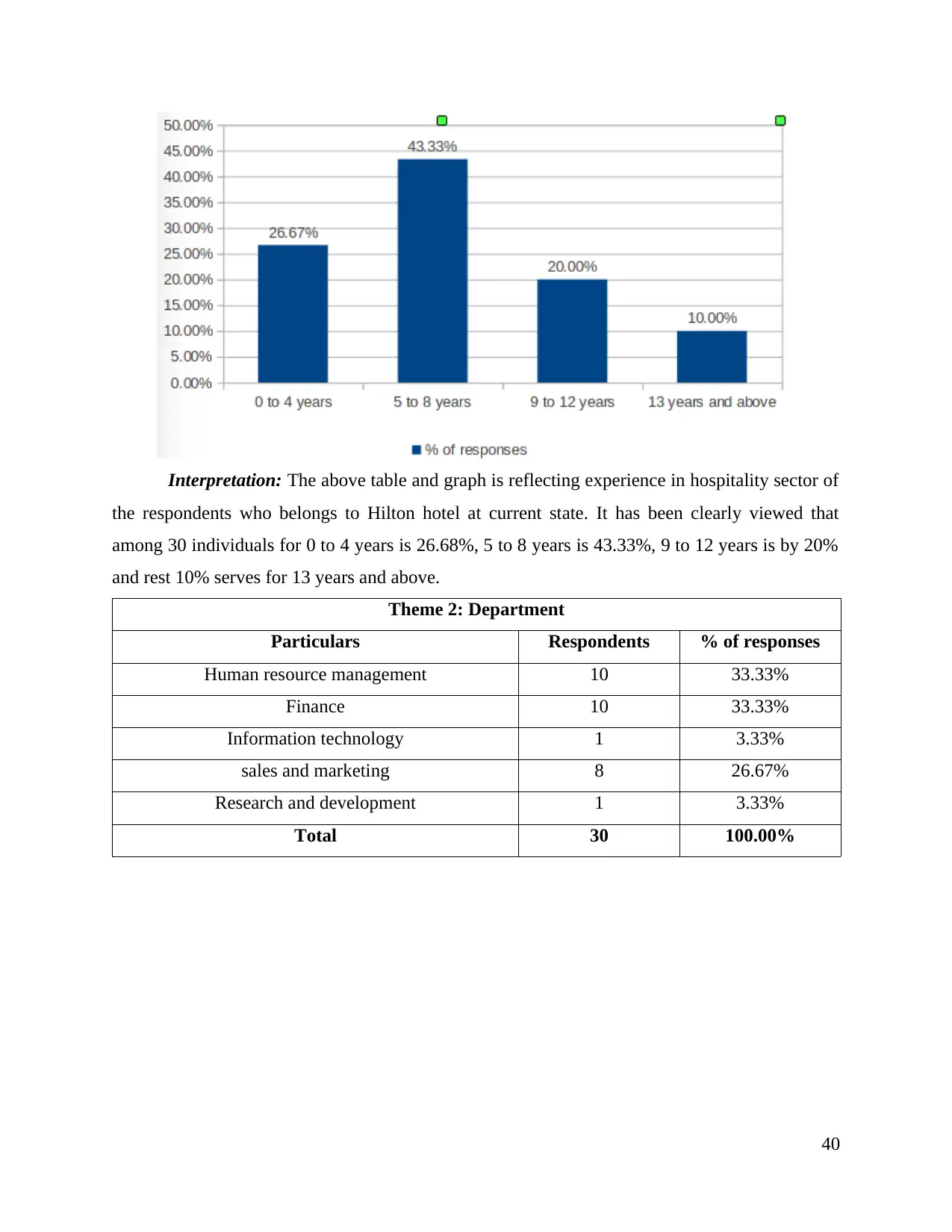
Interpretation: The above table and graph is reflecting experience in hospitality sector of
the respondents who belongs to Hilton hotel at current state. It has been clearly viewed that
among 30 individuals for 0 to 4 years is 26.68%, 5 to 8 years is 43.33%, 9 to 12 years is by 20%
and rest 10% serves for 13 years and above.
Theme 2: Department
Particulars Respondents % of responses
Human resource management 10 33.33%
Finance 10 33.33%
Information technology 1 3.33%
sales and marketing 8 26.67%
Research and development 1 3.33%
Total 30 100.00%
40
the respondents who belongs to Hilton hotel at current state. It has been clearly viewed that
among 30 individuals for 0 to 4 years is 26.68%, 5 to 8 years is 43.33%, 9 to 12 years is by 20%
and rest 10% serves for 13 years and above.
Theme 2: Department
Particulars Respondents % of responses
Human resource management 10 33.33%
Finance 10 33.33%
Information technology 1 3.33%
sales and marketing 8 26.67%
Research and development 1 3.33%
Total 30 100.00%
40
Paraphrase This Document
Need a fresh take? Get an instant paraphrase of this document with our AI Paraphraser
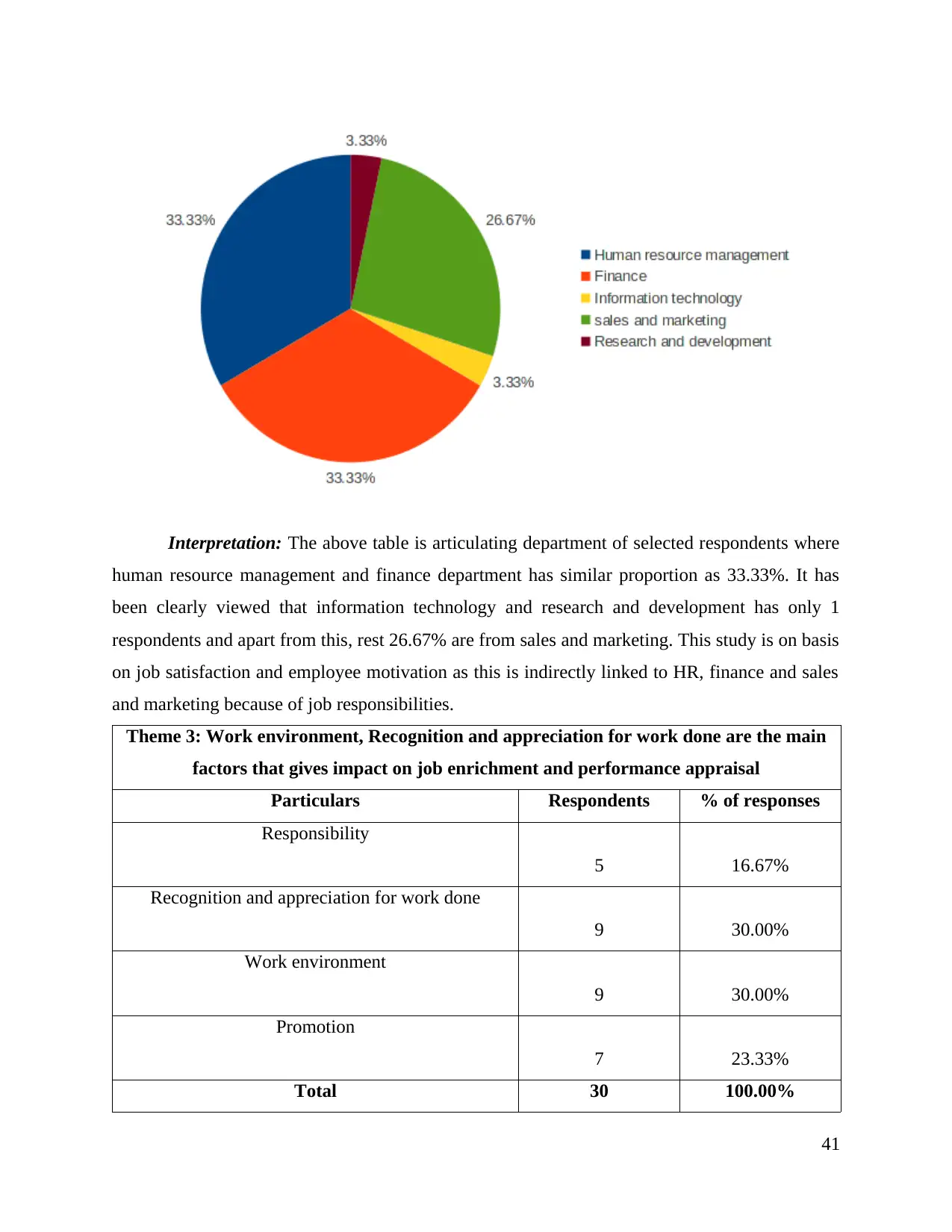
Interpretation: The above table is articulating department of selected respondents where
human resource management and finance department has similar proportion as 33.33%. It has
been clearly viewed that information technology and research and development has only 1
respondents and apart from this, rest 26.67% are from sales and marketing. This study is on basis
on job satisfaction and employee motivation as this is indirectly linked to HR, finance and sales
and marketing because of job responsibilities.
Theme 3: Work environment, Recognition and appreciation for work done are the main
factors that gives impact on job enrichment and performance appraisal
Particulars Respondents % of responses
Responsibility
5 16.67%
Recognition and appreciation for work done
9 30.00%
Work environment
9 30.00%
Promotion
7 23.33%
Total 30 100.00%
41
human resource management and finance department has similar proportion as 33.33%. It has
been clearly viewed that information technology and research and development has only 1
respondents and apart from this, rest 26.67% are from sales and marketing. This study is on basis
on job satisfaction and employee motivation as this is indirectly linked to HR, finance and sales
and marketing because of job responsibilities.
Theme 3: Work environment, Recognition and appreciation for work done are the main
factors that gives impact on job enrichment and performance appraisal
Particulars Respondents % of responses
Responsibility
5 16.67%
Recognition and appreciation for work done
9 30.00%
Work environment
9 30.00%
Promotion
7 23.33%
Total 30 100.00%
41
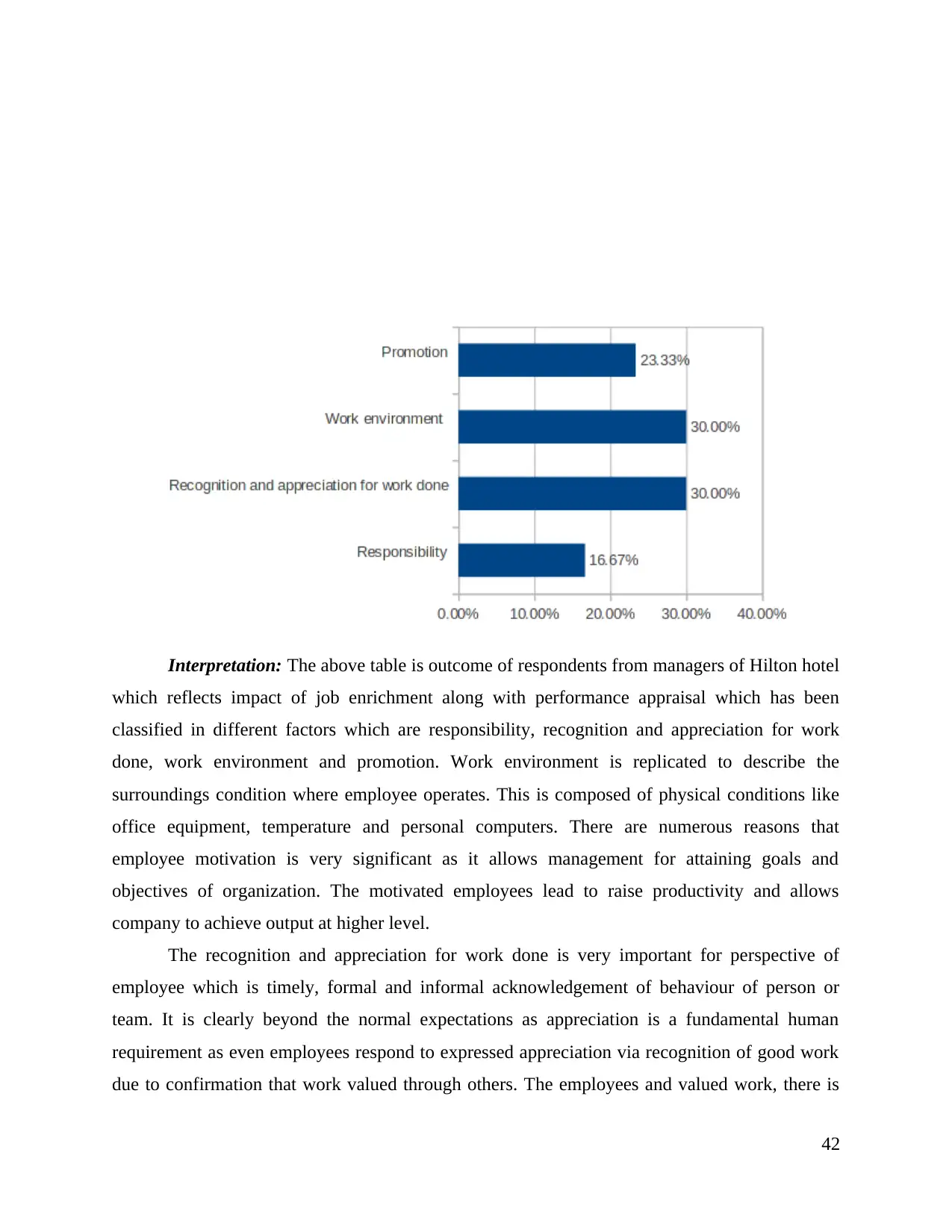
Interpretation: The above table is outcome of respondents from managers of Hilton hotel
which reflects impact of job enrichment along with performance appraisal which has been
classified in different factors which are responsibility, recognition and appreciation for work
done, work environment and promotion. Work environment is replicated to describe the
surroundings condition where employee operates. This is composed of physical conditions like
office equipment, temperature and personal computers. There are numerous reasons that
employee motivation is very significant as it allows management for attaining goals and
objectives of organization. The motivated employees lead to raise productivity and allows
company to achieve output at higher level.
The recognition and appreciation for work done is very important for perspective of
employee which is timely, formal and informal acknowledgement of behaviour of person or
team. It is clearly beyond the normal expectations as appreciation is a fundamental human
requirement as even employees respond to expressed appreciation via recognition of good work
due to confirmation that work valued through others. The employees and valued work, there is
42
which reflects impact of job enrichment along with performance appraisal which has been
classified in different factors which are responsibility, recognition and appreciation for work
done, work environment and promotion. Work environment is replicated to describe the
surroundings condition where employee operates. This is composed of physical conditions like
office equipment, temperature and personal computers. There are numerous reasons that
employee motivation is very significant as it allows management for attaining goals and
objectives of organization. The motivated employees lead to raise productivity and allows
company to achieve output at higher level.
The recognition and appreciation for work done is very important for perspective of
employee which is timely, formal and informal acknowledgement of behaviour of person or
team. It is clearly beyond the normal expectations as appreciation is a fundamental human
requirement as even employees respond to expressed appreciation via recognition of good work
due to confirmation that work valued through others. The employees and valued work, there is
42

increment of satisfaction and productivity and motivated for improving and maintaining good
work. The other factor is responsibility which creates confidence among staff and it is indirectly
associated to performance behaviour.
The term promotion itself replicates positive impact as establishment of policy to
administer promotions and job advancement. This might include discussion of numerous
opportunities for advancement with evaluation of employee performance and allows workers at
specified level of experience for executive positions.
It has been clearly viewed that 30% of respondents are giving similar preference to work
environment and work recognition and appreciation. The main reason behind essentiality of
recognition is outstanding workplace as they have desires to be valued and respected through
others for perspective of contribution. It has been articulated about requirement to be highly
recognised as member and individual of a group which feel a sense to accomplish work done or a
valiant effort. Apart from this, approx 23% had chosen promotion as factor because increment in
rank might be accompanied through increment in benefits and pay. It moves up the level of job
of employee on organizational chart and new reporting relationship has been displayed as it has
ability for impacting wider organizational decision making. In simple words, it raises employees
status who retains promotion which is visible sign of employer's esteem. This might be outcome
of proactive of employee pursuit of higher ranking as reward through employers for good
performance. Henceforth, responsibility is supported by 16.67% respondents which is a factor
but not dominating compared to others.
Theme 4: Monetary incentives make vital contribution in the motivation of employee
Particulars Respondents % of responses
Salary
10 33.33%
Compensation package
9 30.00%
Monetary incentives
11 36.67%
Total 30 100.00%
43
work. The other factor is responsibility which creates confidence among staff and it is indirectly
associated to performance behaviour.
The term promotion itself replicates positive impact as establishment of policy to
administer promotions and job advancement. This might include discussion of numerous
opportunities for advancement with evaluation of employee performance and allows workers at
specified level of experience for executive positions.
It has been clearly viewed that 30% of respondents are giving similar preference to work
environment and work recognition and appreciation. The main reason behind essentiality of
recognition is outstanding workplace as they have desires to be valued and respected through
others for perspective of contribution. It has been articulated about requirement to be highly
recognised as member and individual of a group which feel a sense to accomplish work done or a
valiant effort. Apart from this, approx 23% had chosen promotion as factor because increment in
rank might be accompanied through increment in benefits and pay. It moves up the level of job
of employee on organizational chart and new reporting relationship has been displayed as it has
ability for impacting wider organizational decision making. In simple words, it raises employees
status who retains promotion which is visible sign of employer's esteem. This might be outcome
of proactive of employee pursuit of higher ranking as reward through employers for good
performance. Henceforth, responsibility is supported by 16.67% respondents which is a factor
but not dominating compared to others.
Theme 4: Monetary incentives make vital contribution in the motivation of employee
Particulars Respondents % of responses
Salary
10 33.33%
Compensation package
9 30.00%
Monetary incentives
11 36.67%
Total 30 100.00%
43
Secure Best Marks with AI Grader
Need help grading? Try our AI Grader for instant feedback on your assignments.
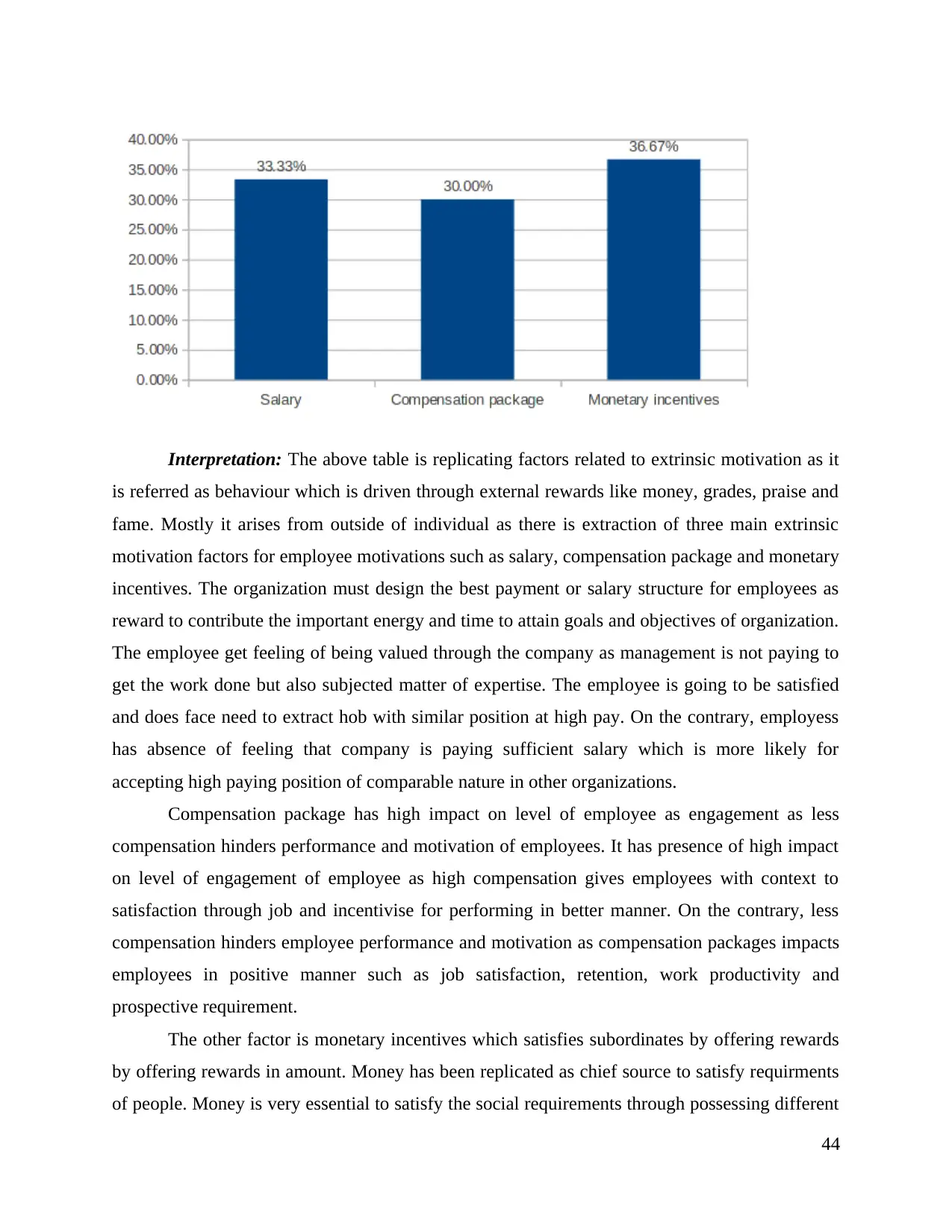
Interpretation: The above table is replicating factors related to extrinsic motivation as it
is referred as behaviour which is driven through external rewards like money, grades, praise and
fame. Mostly it arises from outside of individual as there is extraction of three main extrinsic
motivation factors for employee motivations such as salary, compensation package and monetary
incentives. The organization must design the best payment or salary structure for employees as
reward to contribute the important energy and time to attain goals and objectives of organization.
The employee get feeling of being valued through the company as management is not paying to
get the work done but also subjected matter of expertise. The employee is going to be satisfied
and does face need to extract hob with similar position at high pay. On the contrary, employess
has absence of feeling that company is paying sufficient salary which is more likely for
accepting high paying position of comparable nature in other organizations.
Compensation package has high impact on level of employee as engagement as less
compensation hinders performance and motivation of employees. It has presence of high impact
on level of engagement of employee as high compensation gives employees with context to
satisfaction through job and incentivise for performing in better manner. On the contrary, less
compensation hinders employee performance and motivation as compensation packages impacts
employees in positive manner such as job satisfaction, retention, work productivity and
prospective requirement.
The other factor is monetary incentives which satisfies subordinates by offering rewards
by offering rewards in amount. Money has been replicated as chief source to satisfy requirments
of people. Money is very essential to satisfy the social requirements through possessing different
44
is referred as behaviour which is driven through external rewards like money, grades, praise and
fame. Mostly it arises from outside of individual as there is extraction of three main extrinsic
motivation factors for employee motivations such as salary, compensation package and monetary
incentives. The organization must design the best payment or salary structure for employees as
reward to contribute the important energy and time to attain goals and objectives of organization.
The employee get feeling of being valued through the company as management is not paying to
get the work done but also subjected matter of expertise. The employee is going to be satisfied
and does face need to extract hob with similar position at high pay. On the contrary, employess
has absence of feeling that company is paying sufficient salary which is more likely for
accepting high paying position of comparable nature in other organizations.
Compensation package has high impact on level of employee as engagement as less
compensation hinders performance and motivation of employees. It has presence of high impact
on level of engagement of employee as high compensation gives employees with context to
satisfaction through job and incentivise for performing in better manner. On the contrary, less
compensation hinders employee performance and motivation as compensation packages impacts
employees in positive manner such as job satisfaction, retention, work productivity and
prospective requirement.
The other factor is monetary incentives which satisfies subordinates by offering rewards
by offering rewards in amount. Money has been replicated as chief source to satisfy requirments
of people. Money is very essential to satisfy the social requirements through possessing different
44
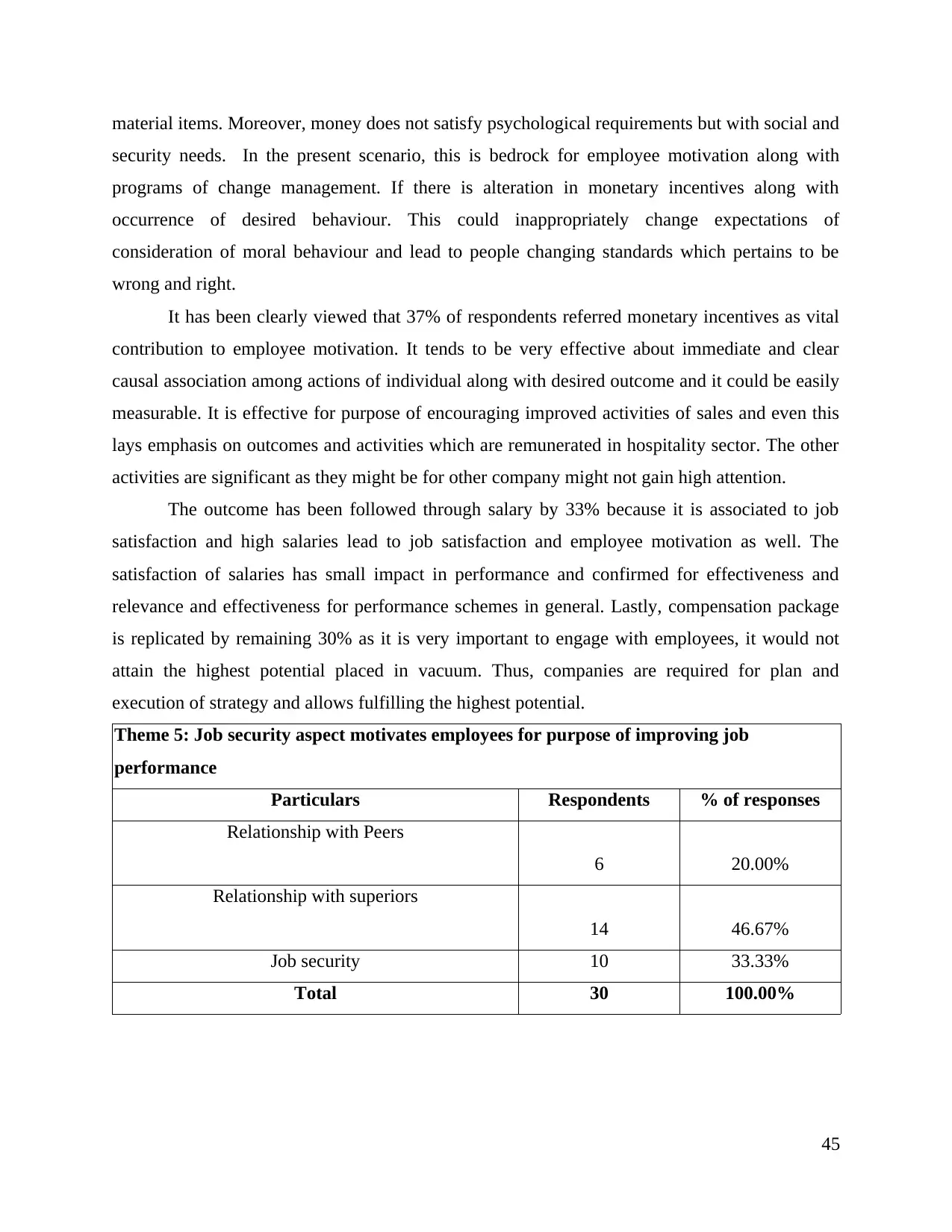
material items. Moreover, money does not satisfy psychological requirements but with social and
security needs. In the present scenario, this is bedrock for employee motivation along with
programs of change management. If there is alteration in monetary incentives along with
occurrence of desired behaviour. This could inappropriately change expectations of
consideration of moral behaviour and lead to people changing standards which pertains to be
wrong and right.
It has been clearly viewed that 37% of respondents referred monetary incentives as vital
contribution to employee motivation. It tends to be very effective about immediate and clear
causal association among actions of individual along with desired outcome and it could be easily
measurable. It is effective for purpose of encouraging improved activities of sales and even this
lays emphasis on outcomes and activities which are remunerated in hospitality sector. The other
activities are significant as they might be for other company might not gain high attention.
The outcome has been followed through salary by 33% because it is associated to job
satisfaction and high salaries lead to job satisfaction and employee motivation as well. The
satisfaction of salaries has small impact in performance and confirmed for effectiveness and
relevance and effectiveness for performance schemes in general. Lastly, compensation package
is replicated by remaining 30% as it is very important to engage with employees, it would not
attain the highest potential placed in vacuum. Thus, companies are required for plan and
execution of strategy and allows fulfilling the highest potential.
Theme 5: Job security aspect motivates employees for purpose of improving job
performance
Particulars Respondents % of responses
Relationship with Peers
6 20.00%
Relationship with superiors
14 46.67%
Job security 10 33.33%
Total 30 100.00%
45
security needs. In the present scenario, this is bedrock for employee motivation along with
programs of change management. If there is alteration in monetary incentives along with
occurrence of desired behaviour. This could inappropriately change expectations of
consideration of moral behaviour and lead to people changing standards which pertains to be
wrong and right.
It has been clearly viewed that 37% of respondents referred monetary incentives as vital
contribution to employee motivation. It tends to be very effective about immediate and clear
causal association among actions of individual along with desired outcome and it could be easily
measurable. It is effective for purpose of encouraging improved activities of sales and even this
lays emphasis on outcomes and activities which are remunerated in hospitality sector. The other
activities are significant as they might be for other company might not gain high attention.
The outcome has been followed through salary by 33% because it is associated to job
satisfaction and high salaries lead to job satisfaction and employee motivation as well. The
satisfaction of salaries has small impact in performance and confirmed for effectiveness and
relevance and effectiveness for performance schemes in general. Lastly, compensation package
is replicated by remaining 30% as it is very important to engage with employees, it would not
attain the highest potential placed in vacuum. Thus, companies are required for plan and
execution of strategy and allows fulfilling the highest potential.
Theme 5: Job security aspect motivates employees for purpose of improving job
performance
Particulars Respondents % of responses
Relationship with Peers
6 20.00%
Relationship with superiors
14 46.67%
Job security 10 33.33%
Total 30 100.00%
45
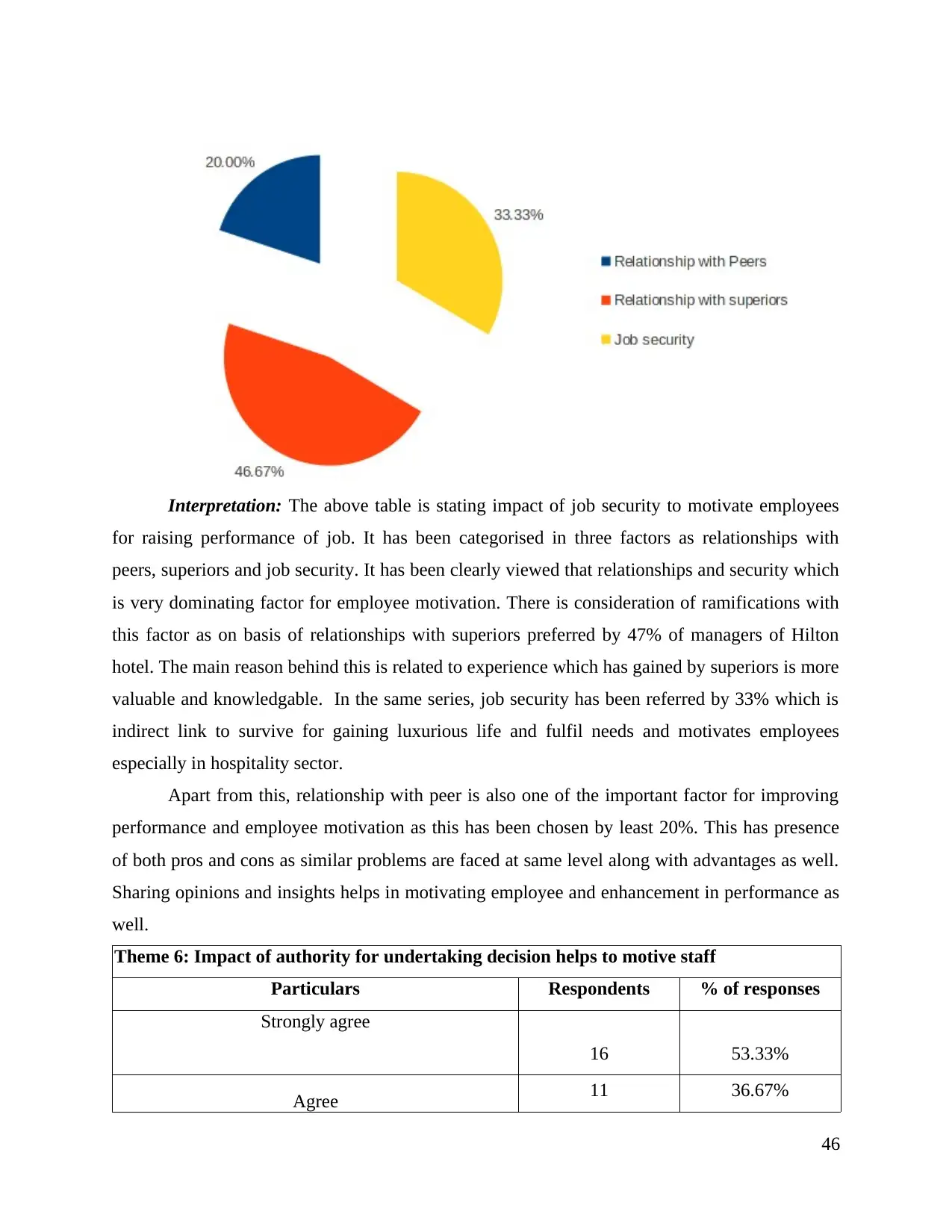
Interpretation: The above table is stating impact of job security to motivate employees
for raising performance of job. It has been categorised in three factors as relationships with
peers, superiors and job security. It has been clearly viewed that relationships and security which
is very dominating factor for employee motivation. There is consideration of ramifications with
this factor as on basis of relationships with superiors preferred by 47% of managers of Hilton
hotel. The main reason behind this is related to experience which has gained by superiors is more
valuable and knowledgable. In the same series, job security has been referred by 33% which is
indirect link to survive for gaining luxurious life and fulfil needs and motivates employees
especially in hospitality sector.
Apart from this, relationship with peer is also one of the important factor for improving
performance and employee motivation as this has been chosen by least 20%. This has presence
of both pros and cons as similar problems are faced at same level along with advantages as well.
Sharing opinions and insights helps in motivating employee and enhancement in performance as
well.
Theme 6: Impact of authority for undertaking decision helps to motive staff
Particulars Respondents % of responses
Strongly agree
16 53.33%
Agree 11 36.67%
46
for raising performance of job. It has been categorised in three factors as relationships with
peers, superiors and job security. It has been clearly viewed that relationships and security which
is very dominating factor for employee motivation. There is consideration of ramifications with
this factor as on basis of relationships with superiors preferred by 47% of managers of Hilton
hotel. The main reason behind this is related to experience which has gained by superiors is more
valuable and knowledgable. In the same series, job security has been referred by 33% which is
indirect link to survive for gaining luxurious life and fulfil needs and motivates employees
especially in hospitality sector.
Apart from this, relationship with peer is also one of the important factor for improving
performance and employee motivation as this has been chosen by least 20%. This has presence
of both pros and cons as similar problems are faced at same level along with advantages as well.
Sharing opinions and insights helps in motivating employee and enhancement in performance as
well.
Theme 6: Impact of authority for undertaking decision helps to motive staff
Particulars Respondents % of responses
Strongly agree
16 53.33%
Agree 11 36.67%
46
Paraphrase This Document
Need a fresh take? Get an instant paraphrase of this document with our AI Paraphraser
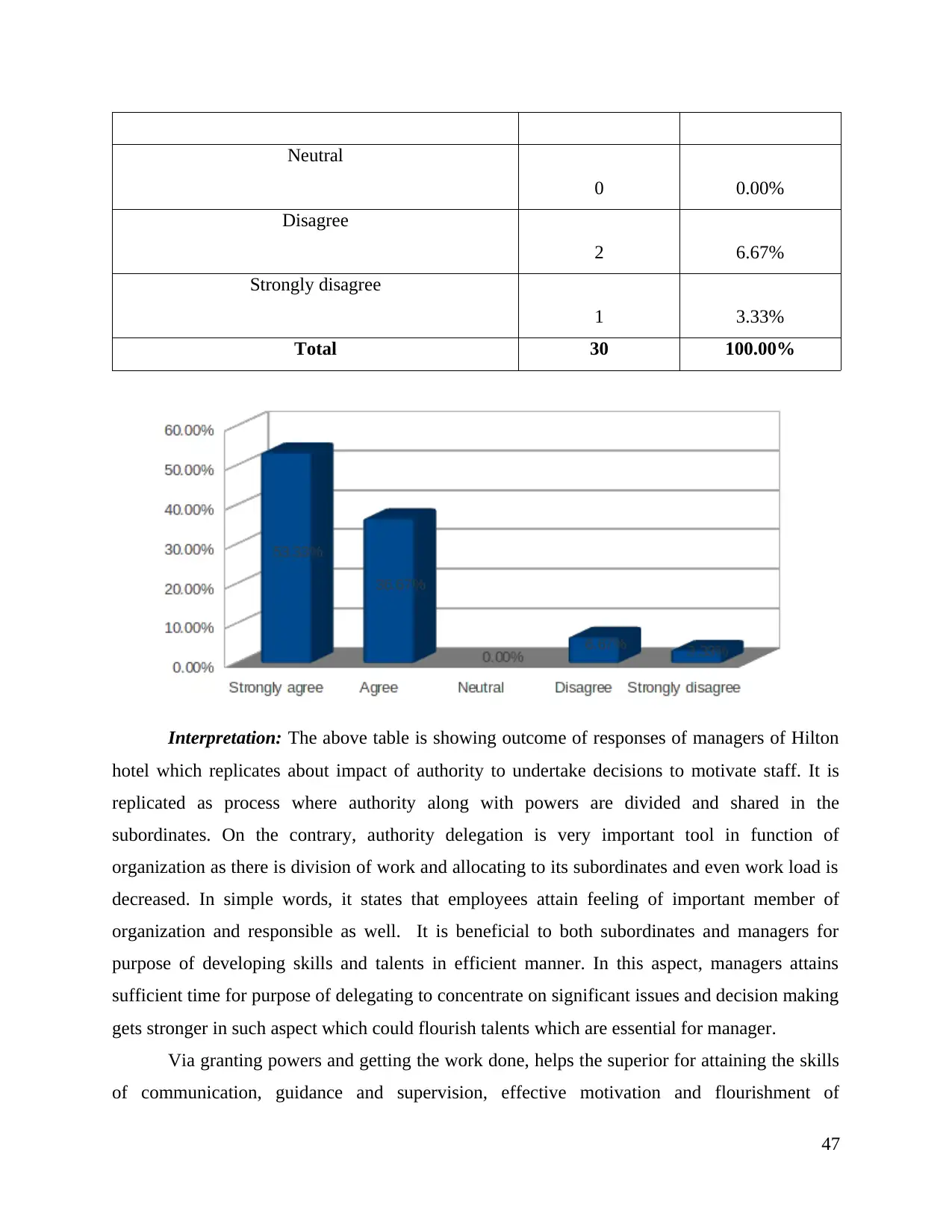
Neutral
0 0.00%
Disagree
2 6.67%
Strongly disagree
1 3.33%
Total 30 100.00%
Interpretation: The above table is showing outcome of responses of managers of Hilton
hotel which replicates about impact of authority to undertake decisions to motivate staff. It is
replicated as process where authority along with powers are divided and shared in the
subordinates. On the contrary, authority delegation is very important tool in function of
organization as there is division of work and allocating to its subordinates and even work load is
decreased. In simple words, it states that employees attain feeling of important member of
organization and responsible as well. It is beneficial to both subordinates and managers for
purpose of developing skills and talents in efficient manner. In this aspect, managers attains
sufficient time for purpose of delegating to concentrate on significant issues and decision making
gets stronger in such aspect which could flourish talents which are essential for manager.
Via granting powers and getting the work done, helps the superior for attaining the skills
of communication, guidance and supervision, effective motivation and flourishment of
47
0 0.00%
Disagree
2 6.67%
Strongly disagree
1 3.33%
Total 30 100.00%
Interpretation: The above table is showing outcome of responses of managers of Hilton
hotel which replicates about impact of authority to undertake decisions to motivate staff. It is
replicated as process where authority along with powers are divided and shared in the
subordinates. On the contrary, authority delegation is very important tool in function of
organization as there is division of work and allocating to its subordinates and even work load is
decreased. In simple words, it states that employees attain feeling of important member of
organization and responsible as well. It is beneficial to both subordinates and managers for
purpose of developing skills and talents in efficient manner. In this aspect, managers attains
sufficient time for purpose of delegating to concentrate on significant issues and decision making
gets stronger in such aspect which could flourish talents which are essential for manager.
Via granting powers and getting the work done, helps the superior for attaining the skills
of communication, guidance and supervision, effective motivation and flourishment of
47
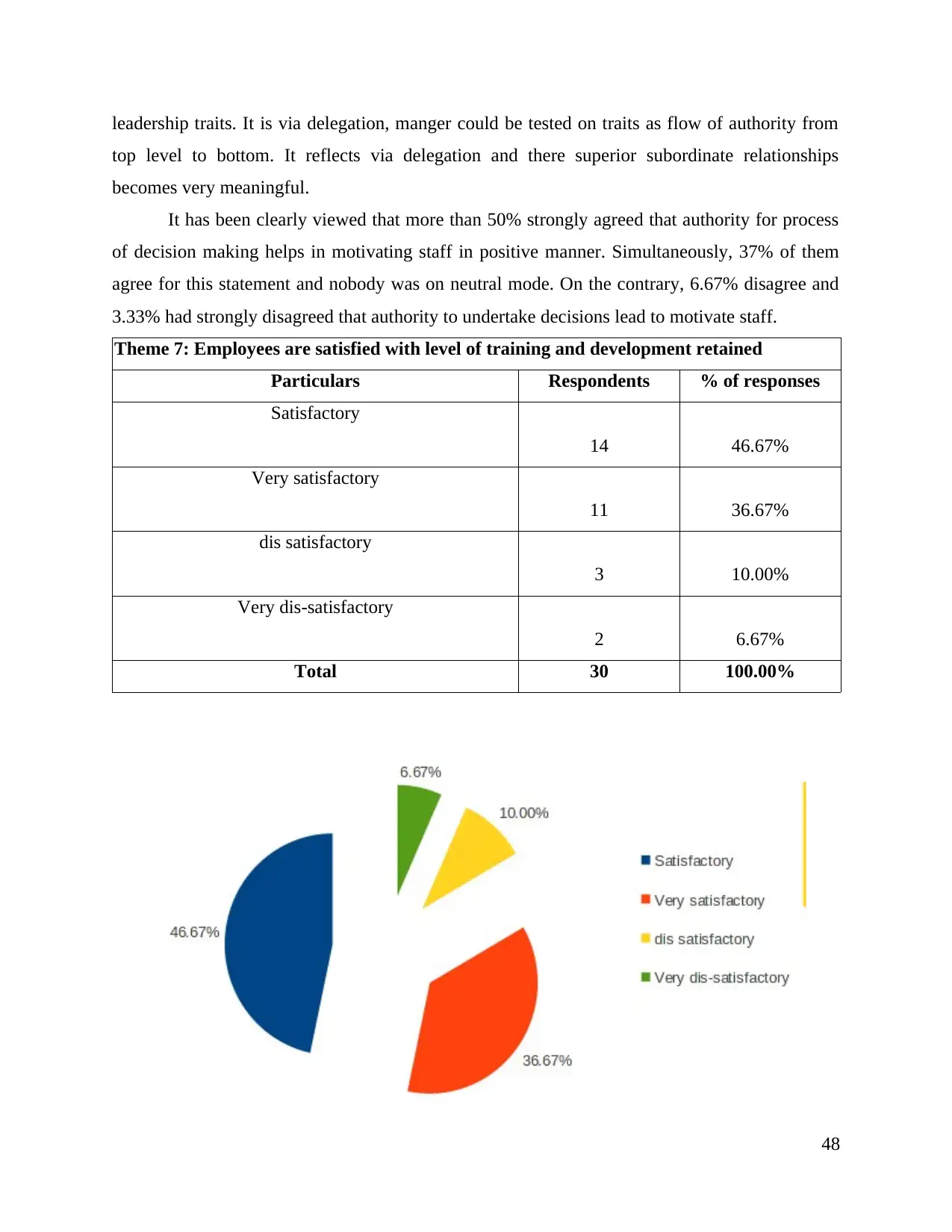
leadership traits. It is via delegation, manger could be tested on traits as flow of authority from
top level to bottom. It reflects via delegation and there superior subordinate relationships
becomes very meaningful.
It has been clearly viewed that more than 50% strongly agreed that authority for process
of decision making helps in motivating staff in positive manner. Simultaneously, 37% of them
agree for this statement and nobody was on neutral mode. On the contrary, 6.67% disagree and
3.33% had strongly disagreed that authority to undertake decisions lead to motivate staff.
Theme 7: Employees are satisfied with level of training and development retained
Particulars Respondents % of responses
Satisfactory
14 46.67%
Very satisfactory
11 36.67%
dis satisfactory
3 10.00%
Very dis-satisfactory
2 6.67%
Total 30 100.00%
48
top level to bottom. It reflects via delegation and there superior subordinate relationships
becomes very meaningful.
It has been clearly viewed that more than 50% strongly agreed that authority for process
of decision making helps in motivating staff in positive manner. Simultaneously, 37% of them
agree for this statement and nobody was on neutral mode. On the contrary, 6.67% disagree and
3.33% had strongly disagreed that authority to undertake decisions lead to motivate staff.
Theme 7: Employees are satisfied with level of training and development retained
Particulars Respondents % of responses
Satisfactory
14 46.67%
Very satisfactory
11 36.67%
dis satisfactory
3 10.00%
Very dis-satisfactory
2 6.67%
Total 30 100.00%
48
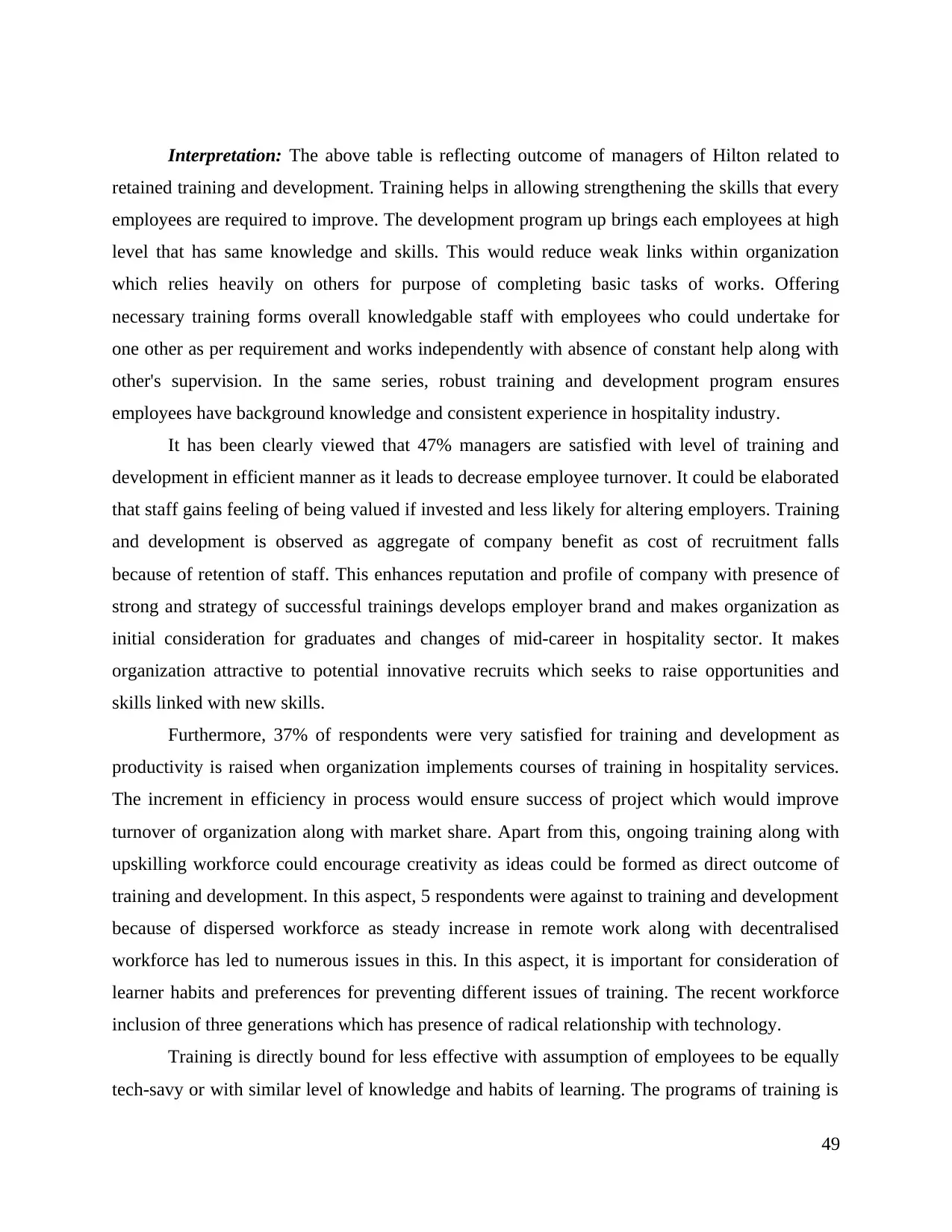
Interpretation: The above table is reflecting outcome of managers of Hilton related to
retained training and development. Training helps in allowing strengthening the skills that every
employees are required to improve. The development program up brings each employees at high
level that has same knowledge and skills. This would reduce weak links within organization
which relies heavily on others for purpose of completing basic tasks of works. Offering
necessary training forms overall knowledgable staff with employees who could undertake for
one other as per requirement and works independently with absence of constant help along with
other's supervision. In the same series, robust training and development program ensures
employees have background knowledge and consistent experience in hospitality industry.
It has been clearly viewed that 47% managers are satisfied with level of training and
development in efficient manner as it leads to decrease employee turnover. It could be elaborated
that staff gains feeling of being valued if invested and less likely for altering employers. Training
and development is observed as aggregate of company benefit as cost of recruitment falls
because of retention of staff. This enhances reputation and profile of company with presence of
strong and strategy of successful trainings develops employer brand and makes organization as
initial consideration for graduates and changes of mid-career in hospitality sector. It makes
organization attractive to potential innovative recruits which seeks to raise opportunities and
skills linked with new skills.
Furthermore, 37% of respondents were very satisfied for training and development as
productivity is raised when organization implements courses of training in hospitality services.
The increment in efficiency in process would ensure success of project which would improve
turnover of organization along with market share. Apart from this, ongoing training along with
upskilling workforce could encourage creativity as ideas could be formed as direct outcome of
training and development. In this aspect, 5 respondents were against to training and development
because of dispersed workforce as steady increase in remote work along with decentralised
workforce has led to numerous issues in this. In this aspect, it is important for consideration of
learner habits and preferences for preventing different issues of training. The recent workforce
inclusion of three generations which has presence of radical relationship with technology.
Training is directly bound for less effective with assumption of employees to be equally
tech-savy or with similar level of knowledge and habits of learning. The programs of training is
49
retained training and development. Training helps in allowing strengthening the skills that every
employees are required to improve. The development program up brings each employees at high
level that has same knowledge and skills. This would reduce weak links within organization
which relies heavily on others for purpose of completing basic tasks of works. Offering
necessary training forms overall knowledgable staff with employees who could undertake for
one other as per requirement and works independently with absence of constant help along with
other's supervision. In the same series, robust training and development program ensures
employees have background knowledge and consistent experience in hospitality industry.
It has been clearly viewed that 47% managers are satisfied with level of training and
development in efficient manner as it leads to decrease employee turnover. It could be elaborated
that staff gains feeling of being valued if invested and less likely for altering employers. Training
and development is observed as aggregate of company benefit as cost of recruitment falls
because of retention of staff. This enhances reputation and profile of company with presence of
strong and strategy of successful trainings develops employer brand and makes organization as
initial consideration for graduates and changes of mid-career in hospitality sector. It makes
organization attractive to potential innovative recruits which seeks to raise opportunities and
skills linked with new skills.
Furthermore, 37% of respondents were very satisfied for training and development as
productivity is raised when organization implements courses of training in hospitality services.
The increment in efficiency in process would ensure success of project which would improve
turnover of organization along with market share. Apart from this, ongoing training along with
upskilling workforce could encourage creativity as ideas could be formed as direct outcome of
training and development. In this aspect, 5 respondents were against to training and development
because of dispersed workforce as steady increase in remote work along with decentralised
workforce has led to numerous issues in this. In this aspect, it is important for consideration of
learner habits and preferences for preventing different issues of training. The recent workforce
inclusion of three generations which has presence of radical relationship with technology.
Training is directly bound for less effective with assumption of employees to be equally
tech-savy or with similar level of knowledge and habits of learning. The programs of training is
49
Secure Best Marks with AI Grader
Need help grading? Try our AI Grader for instant feedback on your assignments.
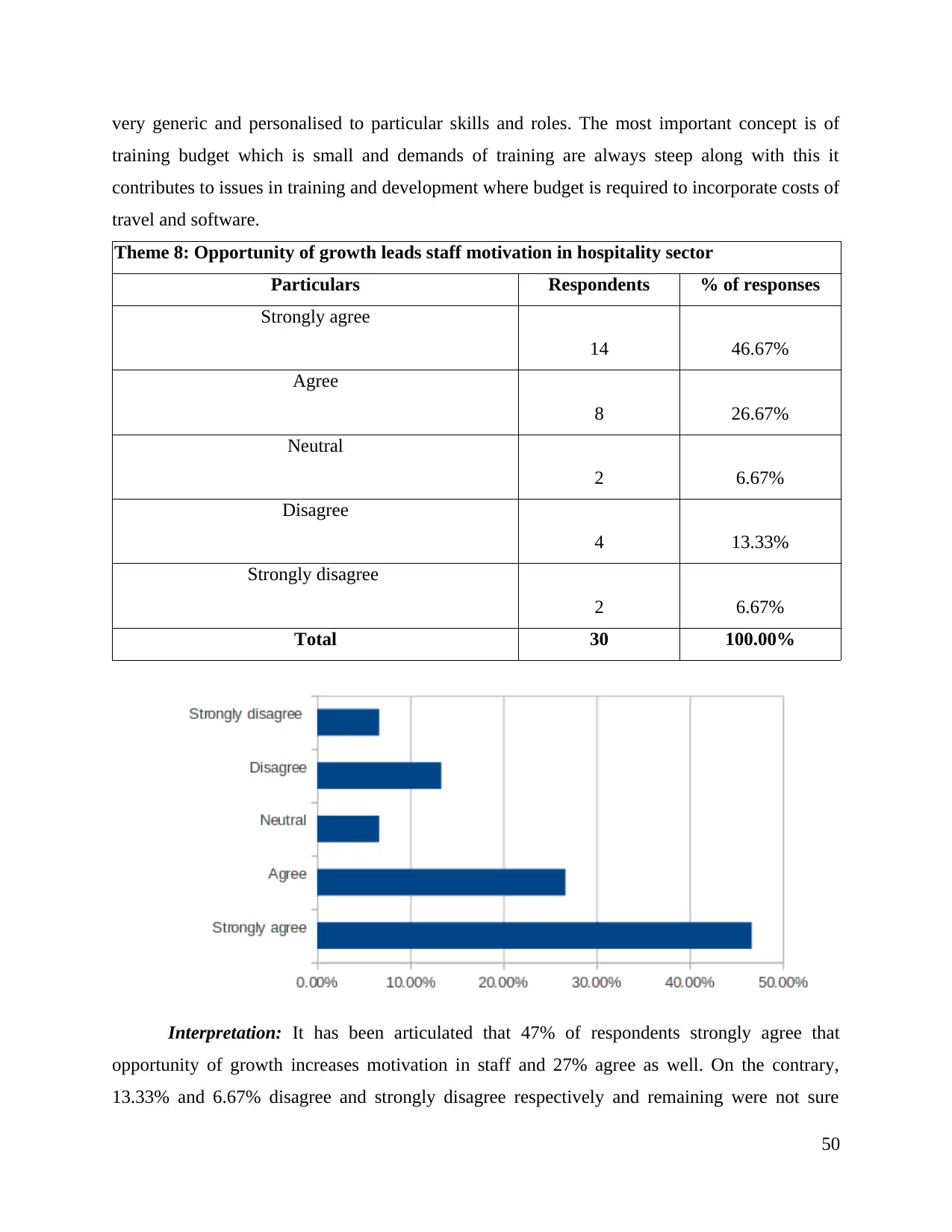
very generic and personalised to particular skills and roles. The most important concept is of
training budget which is small and demands of training are always steep along with this it
contributes to issues in training and development where budget is required to incorporate costs of
travel and software.
Theme 8: Opportunity of growth leads staff motivation in hospitality sector
Particulars Respondents % of responses
Strongly agree
14 46.67%
Agree
8 26.67%
Neutral
2 6.67%
Disagree
4 13.33%
Strongly disagree
2 6.67%
Total 30 100.00%
Interpretation: It has been articulated that 47% of respondents strongly agree that
opportunity of growth increases motivation in staff and 27% agree as well. On the contrary,
13.33% and 6.67% disagree and strongly disagree respectively and remaining were not sure
50
training budget which is small and demands of training are always steep along with this it
contributes to issues in training and development where budget is required to incorporate costs of
travel and software.
Theme 8: Opportunity of growth leads staff motivation in hospitality sector
Particulars Respondents % of responses
Strongly agree
14 46.67%
Agree
8 26.67%
Neutral
2 6.67%
Disagree
4 13.33%
Strongly disagree
2 6.67%
Total 30 100.00%
Interpretation: It has been articulated that 47% of respondents strongly agree that
opportunity of growth increases motivation in staff and 27% agree as well. On the contrary,
13.33% and 6.67% disagree and strongly disagree respectively and remaining were not sure
50

about their own views. The above table is stating outcome of managers of Hilton hotel related to
growth opportunity associated to staff motivation in hospitality sector. The perception of
employee at internal growth and opportunities of development as very important forecasts for
employee engagement. This is obvious that employees would be involved at work of they could
attain growth instead of constantly hitting heads on ceiling. There would be high retention due to
encouragement of opportunities of career development and with high turnover, due to lack of
less encouragement. This increment might encourage workers for sticking around and suggested
staffing especially high performers, offering meaning and utilizing expertise.
In the present scenario, the growth opportunities are categorised in 4 types which are
financial growth, career growth, professional growth and personal growth as well. Financial
growth is considered by most of the people when development of career has been observed. The
employees would be motivated with high possibility of raised income especially, with presence
of association with their performance. However, it is also extracted that money is not only mode
to making the staff happy. In case there is absence of funds, one must consider other forms of
growth.
The other type of opportunity of growth is career as there must be absence of
underestimation of power of prestige. Multiple driven individuals has desire to move up the
organization's rank. In this aspect, there are several opportunities to do significant duties, bigger
offices and very impressive job titles etc. In the same series, professional growth is also
considered as if one is serious related to work, employees would require for improving in
particular field. The important part is to offering opportunities for growth and it is mutually
beneficial even employees get feeling of competent and even employers get more competent
employees. Consideration of advantage of arrangement through giving modes for employes for
sharpening knowledge and skills like conferences, online courses, mentoring programs and
reimbursement of tuition as well.
Moreover, it might seem that there is absence of personal growth with context to
development of career, as employees get motivation with specific factors which are not related to
work. The increment in blurred line among professional and private lives which makes sense for
encouraging employees for purpose of pursuing personal objectives. This could be performed
through allowing flexible work schedules, social gatherings outside of work and freedom to
operate remotely.
51
growth opportunity associated to staff motivation in hospitality sector. The perception of
employee at internal growth and opportunities of development as very important forecasts for
employee engagement. This is obvious that employees would be involved at work of they could
attain growth instead of constantly hitting heads on ceiling. There would be high retention due to
encouragement of opportunities of career development and with high turnover, due to lack of
less encouragement. This increment might encourage workers for sticking around and suggested
staffing especially high performers, offering meaning and utilizing expertise.
In the present scenario, the growth opportunities are categorised in 4 types which are
financial growth, career growth, professional growth and personal growth as well. Financial
growth is considered by most of the people when development of career has been observed. The
employees would be motivated with high possibility of raised income especially, with presence
of association with their performance. However, it is also extracted that money is not only mode
to making the staff happy. In case there is absence of funds, one must consider other forms of
growth.
The other type of opportunity of growth is career as there must be absence of
underestimation of power of prestige. Multiple driven individuals has desire to move up the
organization's rank. In this aspect, there are several opportunities to do significant duties, bigger
offices and very impressive job titles etc. In the same series, professional growth is also
considered as if one is serious related to work, employees would require for improving in
particular field. The important part is to offering opportunities for growth and it is mutually
beneficial even employees get feeling of competent and even employers get more competent
employees. Consideration of advantage of arrangement through giving modes for employes for
sharpening knowledge and skills like conferences, online courses, mentoring programs and
reimbursement of tuition as well.
Moreover, it might seem that there is absence of personal growth with context to
development of career, as employees get motivation with specific factors which are not related to
work. The increment in blurred line among professional and private lives which makes sense for
encouraging employees for purpose of pursuing personal objectives. This could be performed
through allowing flexible work schedules, social gatherings outside of work and freedom to
operate remotely.
51
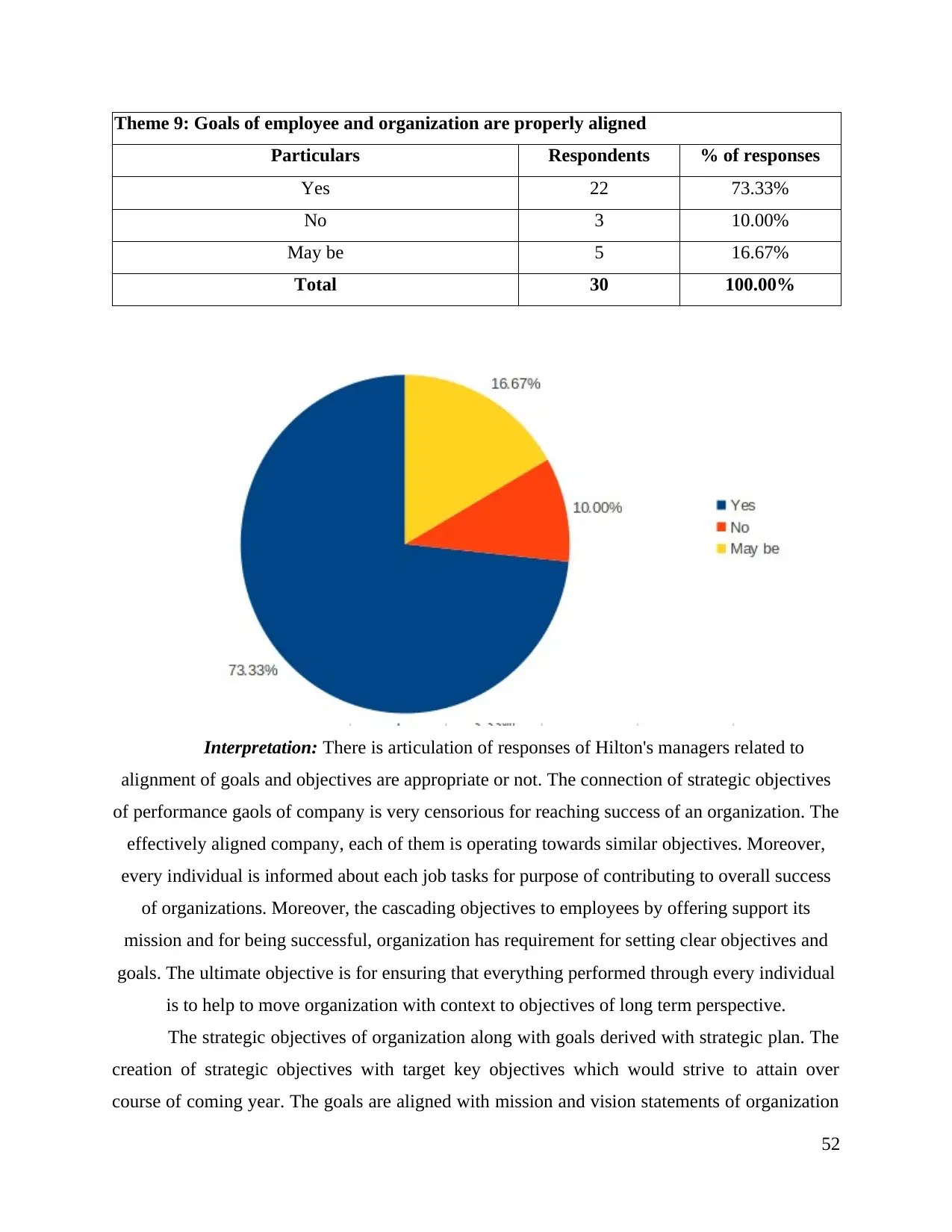
Theme 9: Goals of employee and organization are properly aligned
Particulars Respondents % of responses
Yes 22 73.33%
No 3 10.00%
May be 5 16.67%
Total 30 100.00%
Interpretation: There is articulation of responses of Hilton's managers related to
alignment of goals and objectives are appropriate or not. The connection of strategic objectives
of performance gaols of company is very censorious for reaching success of an organization. The
effectively aligned company, each of them is operating towards similar objectives. Moreover,
every individual is informed about each job tasks for purpose of contributing to overall success
of organizations. Moreover, the cascading objectives to employees by offering support its
mission and for being successful, organization has requirement for setting clear objectives and
goals. The ultimate objective is for ensuring that everything performed through every individual
is to help to move organization with context to objectives of long term perspective.
The strategic objectives of organization along with goals derived with strategic plan. The
creation of strategic objectives with target key objectives which would strive to attain over
course of coming year. The goals are aligned with mission and vision statements of organization
52
Particulars Respondents % of responses
Yes 22 73.33%
No 3 10.00%
May be 5 16.67%
Total 30 100.00%
Interpretation: There is articulation of responses of Hilton's managers related to
alignment of goals and objectives are appropriate or not. The connection of strategic objectives
of performance gaols of company is very censorious for reaching success of an organization. The
effectively aligned company, each of them is operating towards similar objectives. Moreover,
every individual is informed about each job tasks for purpose of contributing to overall success
of organizations. Moreover, the cascading objectives to employees by offering support its
mission and for being successful, organization has requirement for setting clear objectives and
goals. The ultimate objective is for ensuring that everything performed through every individual
is to help to move organization with context to objectives of long term perspective.
The strategic objectives of organization along with goals derived with strategic plan. The
creation of strategic objectives with target key objectives which would strive to attain over
course of coming year. The goals are aligned with mission and vision statements of organization
52
Paraphrase This Document
Need a fresh take? Get an instant paraphrase of this document with our AI Paraphraser
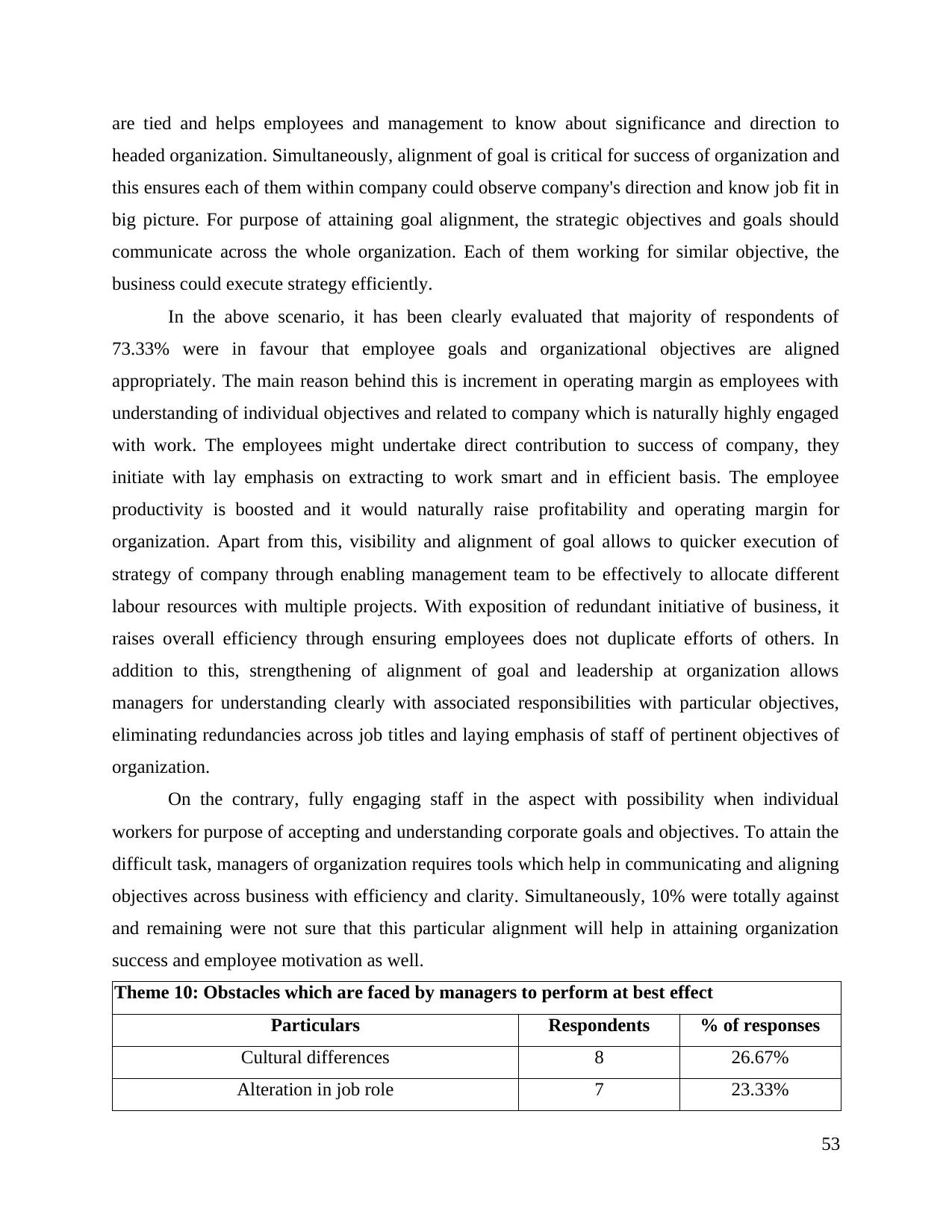
are tied and helps employees and management to know about significance and direction to
headed organization. Simultaneously, alignment of goal is critical for success of organization and
this ensures each of them within company could observe company's direction and know job fit in
big picture. For purpose of attaining goal alignment, the strategic objectives and goals should
communicate across the whole organization. Each of them working for similar objective, the
business could execute strategy efficiently.
In the above scenario, it has been clearly evaluated that majority of respondents of
73.33% were in favour that employee goals and organizational objectives are aligned
appropriately. The main reason behind this is increment in operating margin as employees with
understanding of individual objectives and related to company which is naturally highly engaged
with work. The employees might undertake direct contribution to success of company, they
initiate with lay emphasis on extracting to work smart and in efficient basis. The employee
productivity is boosted and it would naturally raise profitability and operating margin for
organization. Apart from this, visibility and alignment of goal allows to quicker execution of
strategy of company through enabling management team to be effectively to allocate different
labour resources with multiple projects. With exposition of redundant initiative of business, it
raises overall efficiency through ensuring employees does not duplicate efforts of others. In
addition to this, strengthening of alignment of goal and leadership at organization allows
managers for understanding clearly with associated responsibilities with particular objectives,
eliminating redundancies across job titles and laying emphasis of staff of pertinent objectives of
organization.
On the contrary, fully engaging staff in the aspect with possibility when individual
workers for purpose of accepting and understanding corporate goals and objectives. To attain the
difficult task, managers of organization requires tools which help in communicating and aligning
objectives across business with efficiency and clarity. Simultaneously, 10% were totally against
and remaining were not sure that this particular alignment will help in attaining organization
success and employee motivation as well.
Theme 10: Obstacles which are faced by managers to perform at best effect
Particulars Respondents % of responses
Cultural differences 8 26.67%
Alteration in job role 7 23.33%
53
headed organization. Simultaneously, alignment of goal is critical for success of organization and
this ensures each of them within company could observe company's direction and know job fit in
big picture. For purpose of attaining goal alignment, the strategic objectives and goals should
communicate across the whole organization. Each of them working for similar objective, the
business could execute strategy efficiently.
In the above scenario, it has been clearly evaluated that majority of respondents of
73.33% were in favour that employee goals and organizational objectives are aligned
appropriately. The main reason behind this is increment in operating margin as employees with
understanding of individual objectives and related to company which is naturally highly engaged
with work. The employees might undertake direct contribution to success of company, they
initiate with lay emphasis on extracting to work smart and in efficient basis. The employee
productivity is boosted and it would naturally raise profitability and operating margin for
organization. Apart from this, visibility and alignment of goal allows to quicker execution of
strategy of company through enabling management team to be effectively to allocate different
labour resources with multiple projects. With exposition of redundant initiative of business, it
raises overall efficiency through ensuring employees does not duplicate efforts of others. In
addition to this, strengthening of alignment of goal and leadership at organization allows
managers for understanding clearly with associated responsibilities with particular objectives,
eliminating redundancies across job titles and laying emphasis of staff of pertinent objectives of
organization.
On the contrary, fully engaging staff in the aspect with possibility when individual
workers for purpose of accepting and understanding corporate goals and objectives. To attain the
difficult task, managers of organization requires tools which help in communicating and aligning
objectives across business with efficiency and clarity. Simultaneously, 10% were totally against
and remaining were not sure that this particular alignment will help in attaining organization
success and employee motivation as well.
Theme 10: Obstacles which are faced by managers to perform at best effect
Particulars Respondents % of responses
Cultural differences 8 26.67%
Alteration in job role 7 23.33%
53
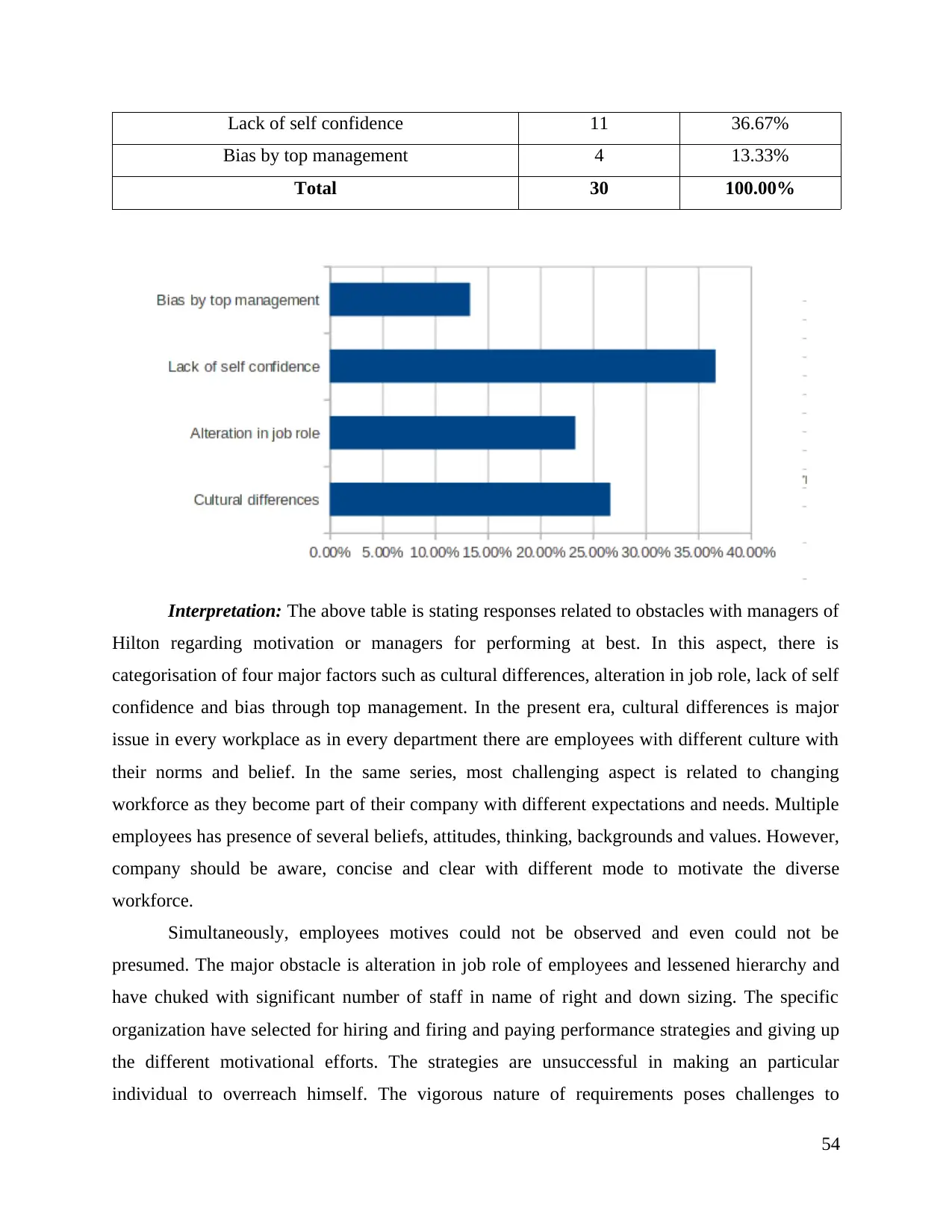
Lack of self confidence 11 36.67%
Bias by top management 4 13.33%
Total 30 100.00%
Interpretation: The above table is stating responses related to obstacles with managers of
Hilton regarding motivation or managers for performing at best. In this aspect, there is
categorisation of four major factors such as cultural differences, alteration in job role, lack of self
confidence and bias through top management. In the present era, cultural differences is major
issue in every workplace as in every department there are employees with different culture with
their norms and belief. In the same series, most challenging aspect is related to changing
workforce as they become part of their company with different expectations and needs. Multiple
employees has presence of several beliefs, attitudes, thinking, backgrounds and values. However,
company should be aware, concise and clear with different mode to motivate the diverse
workforce.
Simultaneously, employees motives could not be observed and even could not be
presumed. The major obstacle is alteration in job role of employees and lessened hierarchy and
have chuked with significant number of staff in name of right and down sizing. The specific
organization have selected for hiring and firing and paying performance strategies and giving up
the different motivational efforts. The strategies are unsuccessful in making an particular
individual to overreach himself. The vigorous nature of requirements poses challenges to
54
Bias by top management 4 13.33%
Total 30 100.00%
Interpretation: The above table is stating responses related to obstacles with managers of
Hilton regarding motivation or managers for performing at best. In this aspect, there is
categorisation of four major factors such as cultural differences, alteration in job role, lack of self
confidence and bias through top management. In the present era, cultural differences is major
issue in every workplace as in every department there are employees with different culture with
their norms and belief. In the same series, most challenging aspect is related to changing
workforce as they become part of their company with different expectations and needs. Multiple
employees has presence of several beliefs, attitudes, thinking, backgrounds and values. However,
company should be aware, concise and clear with different mode to motivate the diverse
workforce.
Simultaneously, employees motives could not be observed and even could not be
presumed. The major obstacle is alteration in job role of employees and lessened hierarchy and
have chuked with significant number of staff in name of right and down sizing. The specific
organization have selected for hiring and firing and paying performance strategies and giving up
the different motivational efforts. The strategies are unsuccessful in making an particular
individual to overreach himself. The vigorous nature of requirements poses challenges to
54

managers with context to motivate the colleagues. The main reason behind this is that employee
at specific point of time has presence of diverse expectations and needs and may clash for every
other. The needs and expectation keeps on changing and may clash with every other. For
example, employees spend extra time at work for attaining needs to attain and discover extra
spent time with social needs and affiliation.
It has been clearly viewed that majority of respondents are facing obstacles in which lack
of confidence is major issue as by 37% followed by cultural differences, change in job role and
bias through top management. Simultaneously, self confidence is considered as ability for
judging own personal and social standing with context to environment and capable for deriving
satisfaction out of it. Mostly it is impacted with factors such as up bringing, level of dedication
and work environment for pursuing a cause. High self confidence is very important factor to
improve business collaboration and even to balance personal life. Any initiation in professional
life has high requirement of confidence in abilities. Self confidence thrives in such atmosphere
where one is given constructive feedback and lays emphasis on positive. However, self
confidence could be hampered with environment which is presence of constant comparison with
others and even expectations are also unrealistic.
Furthermore, cultural difference is also a barrier faced through a manager in motivating
employees as every aspect has different belief in understanding goals, values, expectations and
needs with consideration of motivating employees from different cultures. It builds striong
corporate culture which raises employee motivation as different culture where is inclusion of
color, sex, national, religion and origin. While observing cultural differences with individual
application with differences in employees and mode of employee to expressing it unique. The
allocation of jobs tasks and responsibilities with professional and personal interests. This gives
direct impact on job performance and business to attain success and organizational objectives.
In the present scenario, top management also plays vital role to employee motivation and
improving performance of organization. It is composed of reward systems, performance
appraisal and recognition, if it is done appropriately as per work then it will lead to positive
environment. On the contrary, if personal bias or favouritism its done, then employees are
motivated for maintaining relationship not to perform work appropriately which leads to
decrease in performance.
Theme 11: Performance appraisal helped to gain understanding that what has to be done
55
at specific point of time has presence of diverse expectations and needs and may clash for every
other. The needs and expectation keeps on changing and may clash with every other. For
example, employees spend extra time at work for attaining needs to attain and discover extra
spent time with social needs and affiliation.
It has been clearly viewed that majority of respondents are facing obstacles in which lack
of confidence is major issue as by 37% followed by cultural differences, change in job role and
bias through top management. Simultaneously, self confidence is considered as ability for
judging own personal and social standing with context to environment and capable for deriving
satisfaction out of it. Mostly it is impacted with factors such as up bringing, level of dedication
and work environment for pursuing a cause. High self confidence is very important factor to
improve business collaboration and even to balance personal life. Any initiation in professional
life has high requirement of confidence in abilities. Self confidence thrives in such atmosphere
where one is given constructive feedback and lays emphasis on positive. However, self
confidence could be hampered with environment which is presence of constant comparison with
others and even expectations are also unrealistic.
Furthermore, cultural difference is also a barrier faced through a manager in motivating
employees as every aspect has different belief in understanding goals, values, expectations and
needs with consideration of motivating employees from different cultures. It builds striong
corporate culture which raises employee motivation as different culture where is inclusion of
color, sex, national, religion and origin. While observing cultural differences with individual
application with differences in employees and mode of employee to expressing it unique. The
allocation of jobs tasks and responsibilities with professional and personal interests. This gives
direct impact on job performance and business to attain success and organizational objectives.
In the present scenario, top management also plays vital role to employee motivation and
improving performance of organization. It is composed of reward systems, performance
appraisal and recognition, if it is done appropriately as per work then it will lead to positive
environment. On the contrary, if personal bias or favouritism its done, then employees are
motivated for maintaining relationship not to perform work appropriately which leads to
decrease in performance.
Theme 11: Performance appraisal helped to gain understanding that what has to be done
55
Secure Best Marks with AI Grader
Need help grading? Try our AI Grader for instant feedback on your assignments.
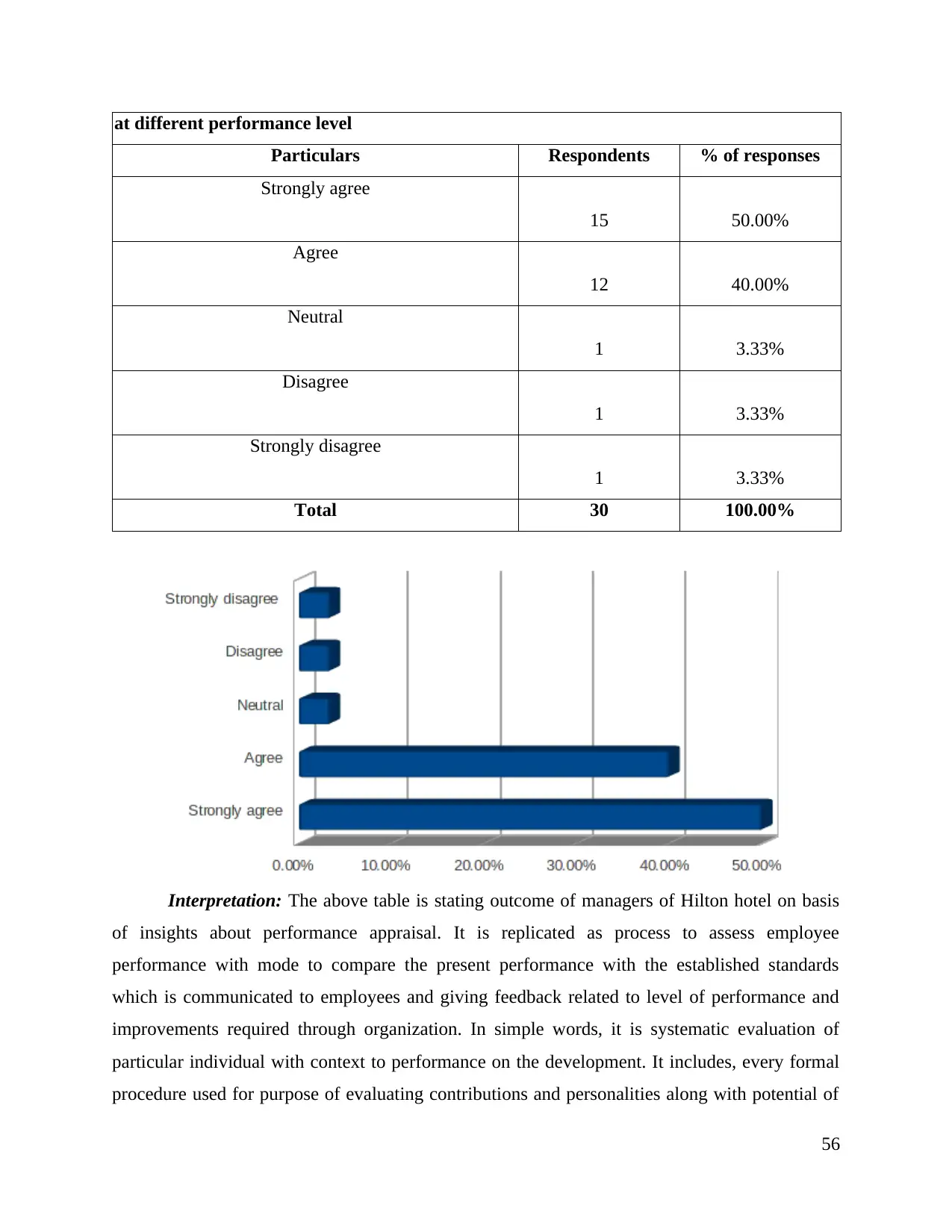
at different performance level
Particulars Respondents % of responses
Strongly agree
15 50.00%
Agree
12 40.00%
Neutral
1 3.33%
Disagree
1 3.33%
Strongly disagree
1 3.33%
Total 30 100.00%
Interpretation: The above table is stating outcome of managers of Hilton hotel on basis
of insights about performance appraisal. It is replicated as process to assess employee
performance with mode to compare the present performance with the established standards
which is communicated to employees and giving feedback related to level of performance and
improvements required through organization. In simple words, it is systematic evaluation of
particular individual with context to performance on the development. It includes, every formal
procedure used for purpose of evaluating contributions and personalities along with potential of
56
Particulars Respondents % of responses
Strongly agree
15 50.00%
Agree
12 40.00%
Neutral
1 3.33%
Disagree
1 3.33%
Strongly disagree
1 3.33%
Total 30 100.00%
Interpretation: The above table is stating outcome of managers of Hilton hotel on basis
of insights about performance appraisal. It is replicated as process to assess employee
performance with mode to compare the present performance with the established standards
which is communicated to employees and giving feedback related to level of performance and
improvements required through organization. In simple words, it is systematic evaluation of
particular individual with context to performance on the development. It includes, every formal
procedure used for purpose of evaluating contributions and personalities along with potential of
56
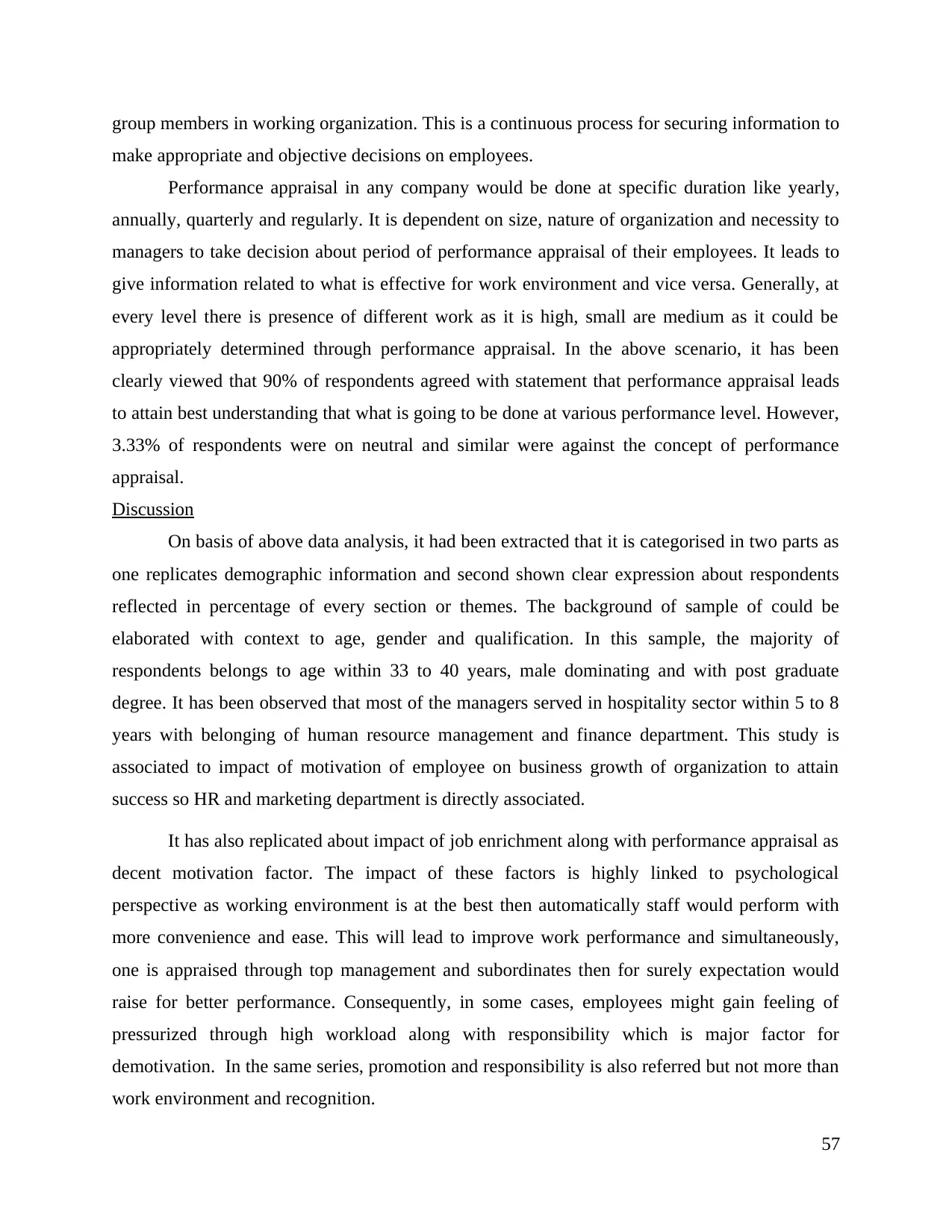
group members in working organization. This is a continuous process for securing information to
make appropriate and objective decisions on employees.
Performance appraisal in any company would be done at specific duration like yearly,
annually, quarterly and regularly. It is dependent on size, nature of organization and necessity to
managers to take decision about period of performance appraisal of their employees. It leads to
give information related to what is effective for work environment and vice versa. Generally, at
every level there is presence of different work as it is high, small are medium as it could be
appropriately determined through performance appraisal. In the above scenario, it has been
clearly viewed that 90% of respondents agreed with statement that performance appraisal leads
to attain best understanding that what is going to be done at various performance level. However,
3.33% of respondents were on neutral and similar were against the concept of performance
appraisal.
Discussion
On basis of above data analysis, it had been extracted that it is categorised in two parts as
one replicates demographic information and second shown clear expression about respondents
reflected in percentage of every section or themes. The background of sample of could be
elaborated with context to age, gender and qualification. In this sample, the majority of
respondents belongs to age within 33 to 40 years, male dominating and with post graduate
degree. It has been observed that most of the managers served in hospitality sector within 5 to 8
years with belonging of human resource management and finance department. This study is
associated to impact of motivation of employee on business growth of organization to attain
success so HR and marketing department is directly associated.
It has also replicated about impact of job enrichment along with performance appraisal as
decent motivation factor. The impact of these factors is highly linked to psychological
perspective as working environment is at the best then automatically staff would perform with
more convenience and ease. This will lead to improve work performance and simultaneously,
one is appraised through top management and subordinates then for surely expectation would
raise for better performance. Consequently, in some cases, employees might gain feeling of
pressurized through high workload along with responsibility which is major factor for
demotivation. In the same series, promotion and responsibility is also referred but not more than
work environment and recognition.
57
make appropriate and objective decisions on employees.
Performance appraisal in any company would be done at specific duration like yearly,
annually, quarterly and regularly. It is dependent on size, nature of organization and necessity to
managers to take decision about period of performance appraisal of their employees. It leads to
give information related to what is effective for work environment and vice versa. Generally, at
every level there is presence of different work as it is high, small are medium as it could be
appropriately determined through performance appraisal. In the above scenario, it has been
clearly viewed that 90% of respondents agreed with statement that performance appraisal leads
to attain best understanding that what is going to be done at various performance level. However,
3.33% of respondents were on neutral and similar were against the concept of performance
appraisal.
Discussion
On basis of above data analysis, it had been extracted that it is categorised in two parts as
one replicates demographic information and second shown clear expression about respondents
reflected in percentage of every section or themes. The background of sample of could be
elaborated with context to age, gender and qualification. In this sample, the majority of
respondents belongs to age within 33 to 40 years, male dominating and with post graduate
degree. It has been observed that most of the managers served in hospitality sector within 5 to 8
years with belonging of human resource management and finance department. This study is
associated to impact of motivation of employee on business growth of organization to attain
success so HR and marketing department is directly associated.
It has also replicated about impact of job enrichment along with performance appraisal as
decent motivation factor. The impact of these factors is highly linked to psychological
perspective as working environment is at the best then automatically staff would perform with
more convenience and ease. This will lead to improve work performance and simultaneously,
one is appraised through top management and subordinates then for surely expectation would
raise for better performance. Consequently, in some cases, employees might gain feeling of
pressurized through high workload along with responsibility which is major factor for
demotivation. In the same series, promotion and responsibility is also referred but not more than
work environment and recognition.
57
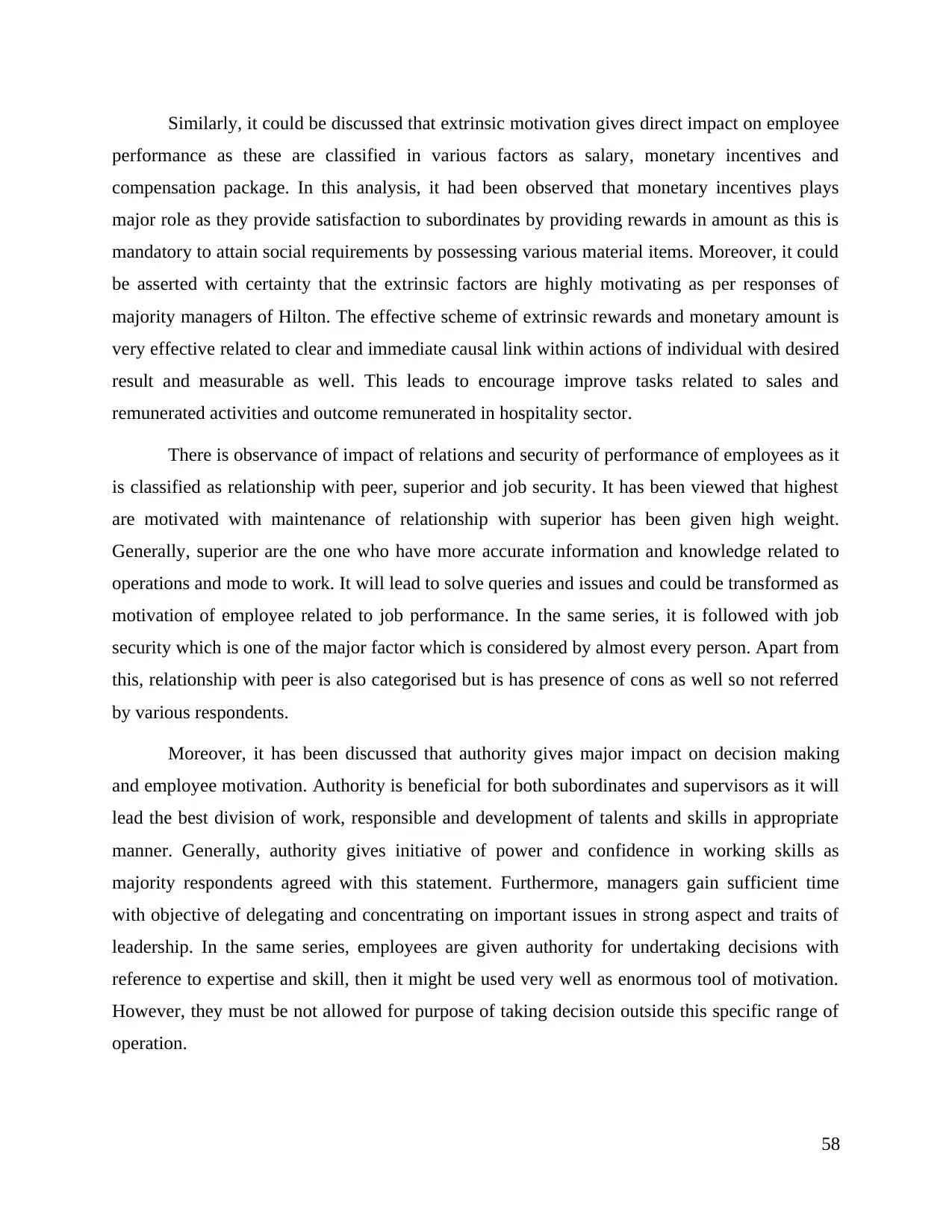
Similarly, it could be discussed that extrinsic motivation gives direct impact on employee
performance as these are classified in various factors as salary, monetary incentives and
compensation package. In this analysis, it had been observed that monetary incentives plays
major role as they provide satisfaction to subordinates by providing rewards in amount as this is
mandatory to attain social requirements by possessing various material items. Moreover, it could
be asserted with certainty that the extrinsic factors are highly motivating as per responses of
majority managers of Hilton. The effective scheme of extrinsic rewards and monetary amount is
very effective related to clear and immediate causal link within actions of individual with desired
result and measurable as well. This leads to encourage improve tasks related to sales and
remunerated activities and outcome remunerated in hospitality sector.
There is observance of impact of relations and security of performance of employees as it
is classified as relationship with peer, superior and job security. It has been viewed that highest
are motivated with maintenance of relationship with superior has been given high weight.
Generally, superior are the one who have more accurate information and knowledge related to
operations and mode to work. It will lead to solve queries and issues and could be transformed as
motivation of employee related to job performance. In the same series, it is followed with job
security which is one of the major factor which is considered by almost every person. Apart from
this, relationship with peer is also categorised but is has presence of cons as well so not referred
by various respondents.
Moreover, it has been discussed that authority gives major impact on decision making
and employee motivation. Authority is beneficial for both subordinates and supervisors as it will
lead the best division of work, responsible and development of talents and skills in appropriate
manner. Generally, authority gives initiative of power and confidence in working skills as
majority respondents agreed with this statement. Furthermore, managers gain sufficient time
with objective of delegating and concentrating on important issues in strong aspect and traits of
leadership. In the same series, employees are given authority for undertaking decisions with
reference to expertise and skill, then it might be used very well as enormous tool of motivation.
However, they must be not allowed for purpose of taking decision outside this specific range of
operation.
58
performance as these are classified in various factors as salary, monetary incentives and
compensation package. In this analysis, it had been observed that monetary incentives plays
major role as they provide satisfaction to subordinates by providing rewards in amount as this is
mandatory to attain social requirements by possessing various material items. Moreover, it could
be asserted with certainty that the extrinsic factors are highly motivating as per responses of
majority managers of Hilton. The effective scheme of extrinsic rewards and monetary amount is
very effective related to clear and immediate causal link within actions of individual with desired
result and measurable as well. This leads to encourage improve tasks related to sales and
remunerated activities and outcome remunerated in hospitality sector.
There is observance of impact of relations and security of performance of employees as it
is classified as relationship with peer, superior and job security. It has been viewed that highest
are motivated with maintenance of relationship with superior has been given high weight.
Generally, superior are the one who have more accurate information and knowledge related to
operations and mode to work. It will lead to solve queries and issues and could be transformed as
motivation of employee related to job performance. In the same series, it is followed with job
security which is one of the major factor which is considered by almost every person. Apart from
this, relationship with peer is also categorised but is has presence of cons as well so not referred
by various respondents.
Moreover, it has been discussed that authority gives major impact on decision making
and employee motivation. Authority is beneficial for both subordinates and supervisors as it will
lead the best division of work, responsible and development of talents and skills in appropriate
manner. Generally, authority gives initiative of power and confidence in working skills as
majority respondents agreed with this statement. Furthermore, managers gain sufficient time
with objective of delegating and concentrating on important issues in strong aspect and traits of
leadership. In the same series, employees are given authority for undertaking decisions with
reference to expertise and skill, then it might be used very well as enormous tool of motivation.
However, they must be not allowed for purpose of taking decision outside this specific range of
operation.
58
Paraphrase This Document
Need a fresh take? Get an instant paraphrase of this document with our AI Paraphraser
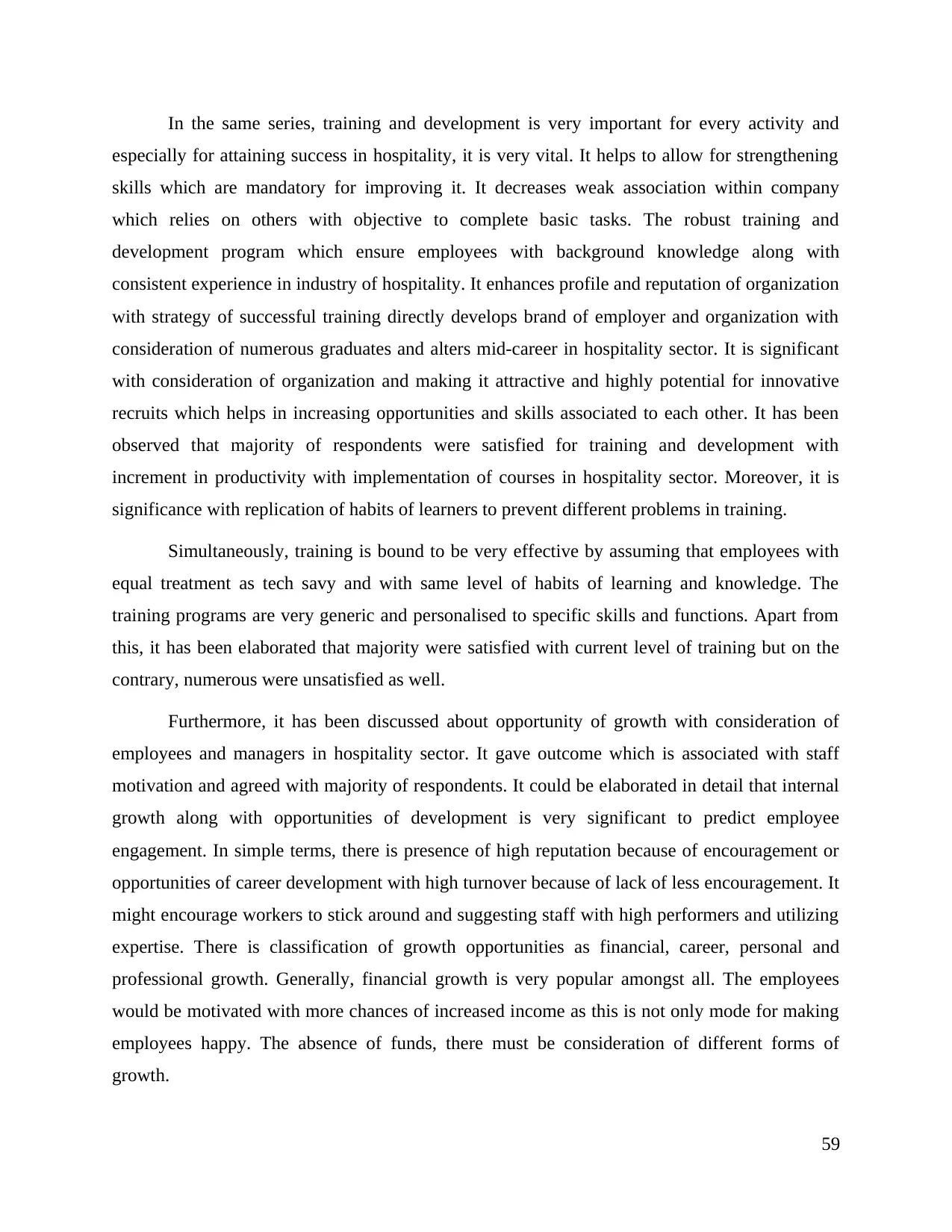
In the same series, training and development is very important for every activity and
especially for attaining success in hospitality, it is very vital. It helps to allow for strengthening
skills which are mandatory for improving it. It decreases weak association within company
which relies on others with objective to complete basic tasks. The robust training and
development program which ensure employees with background knowledge along with
consistent experience in industry of hospitality. It enhances profile and reputation of organization
with strategy of successful training directly develops brand of employer and organization with
consideration of numerous graduates and alters mid-career in hospitality sector. It is significant
with consideration of organization and making it attractive and highly potential for innovative
recruits which helps in increasing opportunities and skills associated to each other. It has been
observed that majority of respondents were satisfied for training and development with
increment in productivity with implementation of courses in hospitality sector. Moreover, it is
significance with replication of habits of learners to prevent different problems in training.
Simultaneously, training is bound to be very effective by assuming that employees with
equal treatment as tech savy and with same level of habits of learning and knowledge. The
training programs are very generic and personalised to specific skills and functions. Apart from
this, it has been elaborated that majority were satisfied with current level of training but on the
contrary, numerous were unsatisfied as well.
Furthermore, it has been discussed about opportunity of growth with consideration of
employees and managers in hospitality sector. It gave outcome which is associated with staff
motivation and agreed with majority of respondents. It could be elaborated in detail that internal
growth along with opportunities of development is very significant to predict employee
engagement. In simple terms, there is presence of high reputation because of encouragement or
opportunities of career development with high turnover because of lack of less encouragement. It
might encourage workers to stick around and suggesting staff with high performers and utilizing
expertise. There is classification of growth opportunities as financial, career, personal and
professional growth. Generally, financial growth is very popular amongst all. The employees
would be motivated with more chances of increased income as this is not only mode for making
employees happy. The absence of funds, there must be consideration of different forms of
growth.
59
especially for attaining success in hospitality, it is very vital. It helps to allow for strengthening
skills which are mandatory for improving it. It decreases weak association within company
which relies on others with objective to complete basic tasks. The robust training and
development program which ensure employees with background knowledge along with
consistent experience in industry of hospitality. It enhances profile and reputation of organization
with strategy of successful training directly develops brand of employer and organization with
consideration of numerous graduates and alters mid-career in hospitality sector. It is significant
with consideration of organization and making it attractive and highly potential for innovative
recruits which helps in increasing opportunities and skills associated to each other. It has been
observed that majority of respondents were satisfied for training and development with
increment in productivity with implementation of courses in hospitality sector. Moreover, it is
significance with replication of habits of learners to prevent different problems in training.
Simultaneously, training is bound to be very effective by assuming that employees with
equal treatment as tech savy and with same level of habits of learning and knowledge. The
training programs are very generic and personalised to specific skills and functions. Apart from
this, it has been elaborated that majority were satisfied with current level of training but on the
contrary, numerous were unsatisfied as well.
Furthermore, it has been discussed about opportunity of growth with consideration of
employees and managers in hospitality sector. It gave outcome which is associated with staff
motivation and agreed with majority of respondents. It could be elaborated in detail that internal
growth along with opportunities of development is very significant to predict employee
engagement. In simple terms, there is presence of high reputation because of encouragement or
opportunities of career development with high turnover because of lack of less encouragement. It
might encourage workers to stick around and suggesting staff with high performers and utilizing
expertise. There is classification of growth opportunities as financial, career, personal and
professional growth. Generally, financial growth is very popular amongst all. The employees
would be motivated with more chances of increased income as this is not only mode for making
employees happy. The absence of funds, there must be consideration of different forms of
growth.
59
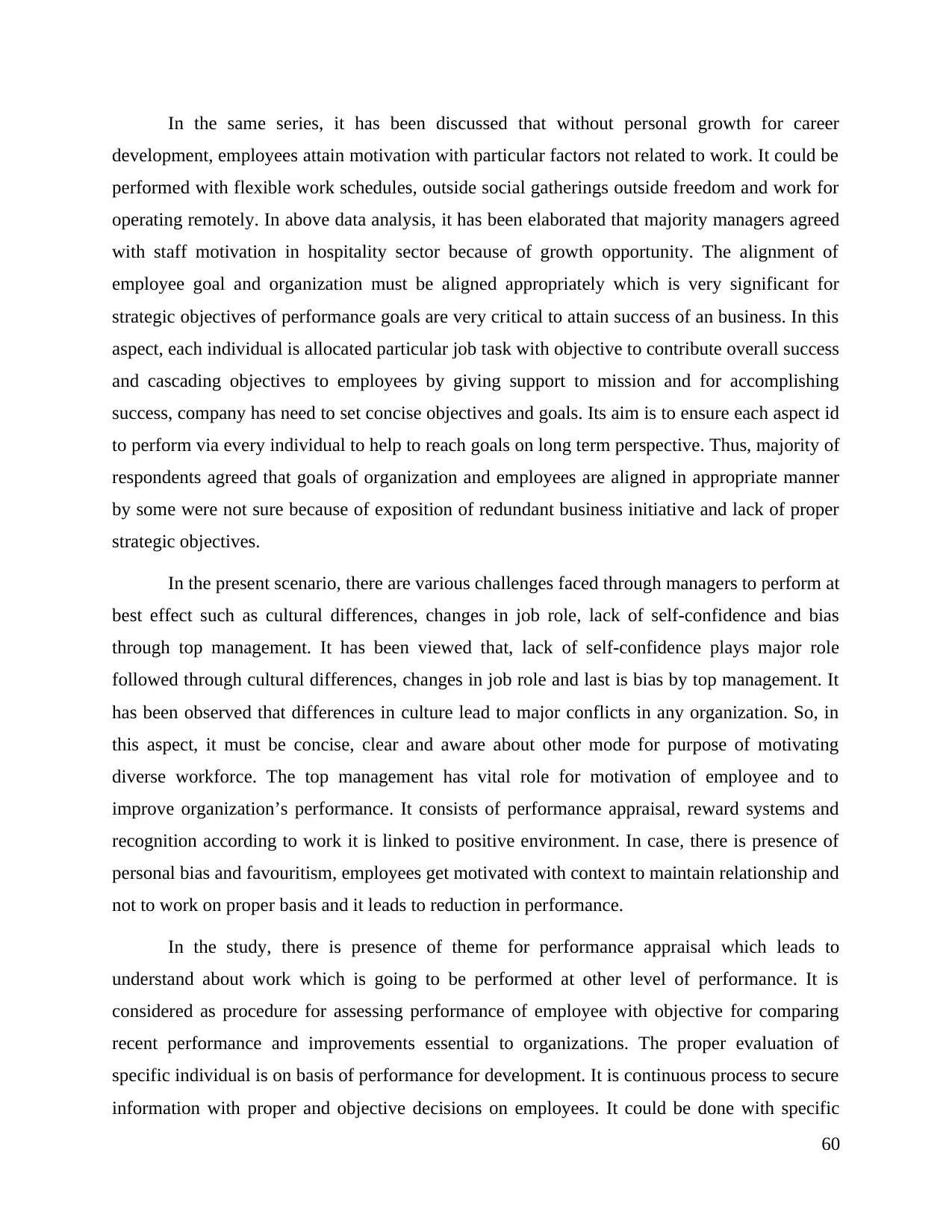
In the same series, it has been discussed that without personal growth for career
development, employees attain motivation with particular factors not related to work. It could be
performed with flexible work schedules, outside social gatherings outside freedom and work for
operating remotely. In above data analysis, it has been elaborated that majority managers agreed
with staff motivation in hospitality sector because of growth opportunity. The alignment of
employee goal and organization must be aligned appropriately which is very significant for
strategic objectives of performance goals are very critical to attain success of an business. In this
aspect, each individual is allocated particular job task with objective to contribute overall success
and cascading objectives to employees by giving support to mission and for accomplishing
success, company has need to set concise objectives and goals. Its aim is to ensure each aspect id
to perform via every individual to help to reach goals on long term perspective. Thus, majority of
respondents agreed that goals of organization and employees are aligned in appropriate manner
by some were not sure because of exposition of redundant business initiative and lack of proper
strategic objectives.
In the present scenario, there are various challenges faced through managers to perform at
best effect such as cultural differences, changes in job role, lack of self-confidence and bias
through top management. It has been viewed that, lack of self-confidence plays major role
followed through cultural differences, changes in job role and last is bias by top management. It
has been observed that differences in culture lead to major conflicts in any organization. So, in
this aspect, it must be concise, clear and aware about other mode for purpose of motivating
diverse workforce. The top management has vital role for motivation of employee and to
improve organization’s performance. It consists of performance appraisal, reward systems and
recognition according to work it is linked to positive environment. In case, there is presence of
personal bias and favouritism, employees get motivated with context to maintain relationship and
not to work on proper basis and it leads to reduction in performance.
In the study, there is presence of theme for performance appraisal which leads to
understand about work which is going to be performed at other level of performance. It is
considered as procedure for assessing performance of employee with objective for comparing
recent performance and improvements essential to organizations. The proper evaluation of
specific individual is on basis of performance for development. It is continuous process to secure
information with proper and objective decisions on employees. It could be done with specific
60
development, employees attain motivation with particular factors not related to work. It could be
performed with flexible work schedules, outside social gatherings outside freedom and work for
operating remotely. In above data analysis, it has been elaborated that majority managers agreed
with staff motivation in hospitality sector because of growth opportunity. The alignment of
employee goal and organization must be aligned appropriately which is very significant for
strategic objectives of performance goals are very critical to attain success of an business. In this
aspect, each individual is allocated particular job task with objective to contribute overall success
and cascading objectives to employees by giving support to mission and for accomplishing
success, company has need to set concise objectives and goals. Its aim is to ensure each aspect id
to perform via every individual to help to reach goals on long term perspective. Thus, majority of
respondents agreed that goals of organization and employees are aligned in appropriate manner
by some were not sure because of exposition of redundant business initiative and lack of proper
strategic objectives.
In the present scenario, there are various challenges faced through managers to perform at
best effect such as cultural differences, changes in job role, lack of self-confidence and bias
through top management. It has been viewed that, lack of self-confidence plays major role
followed through cultural differences, changes in job role and last is bias by top management. It
has been observed that differences in culture lead to major conflicts in any organization. So, in
this aspect, it must be concise, clear and aware about other mode for purpose of motivating
diverse workforce. The top management has vital role for motivation of employee and to
improve organization’s performance. It consists of performance appraisal, reward systems and
recognition according to work it is linked to positive environment. In case, there is presence of
personal bias and favouritism, employees get motivated with context to maintain relationship and
not to work on proper basis and it leads to reduction in performance.
In the study, there is presence of theme for performance appraisal which leads to
understand about work which is going to be performed at other level of performance. It is
considered as procedure for assessing performance of employee with objective for comparing
recent performance and improvements essential to organizations. The proper evaluation of
specific individual is on basis of performance for development. It is continuous process to secure
information with proper and objective decisions on employees. It could be done with specific
60

duration such as yearly, quarterly and on regular basis. Significantly, it is dependent on nature,
size of organization and necessity for managers to taking decisions related to very effective for
particular work environment and vice versa. At every level, there is significant presence of other
work as it is very high, medium and small this could be identified via performance appraisal.
This has been articulated that majority of respondents agreed with performance appraisal lead to
gain best understanding what is done at various level of performance.
CONCLUDING THOUGHTS ON THE CONTRIBUTION OF THIS
RESEARCH, ITS LIMITATIONS AND SUGGESTIONS FOR FURTHER
RESEARCH
Conclusion
By summing up this report it has been concluded that for business growth and
performance enhancement employee motivation needs to be maintained. Moreover, in service
sector, employees are the one who creates distinct image in the mind of customers by offering
quality and innovative services to the customers. Along with this, from secondary data
assessment, it has found that motivated personnel are highly productive as well as innovative
over others. It can be seen in the report that for assessing the influence of employee’s
motivation on the growth as well as performance of Hilton qualitative research type has been
selected. Further, for addressing research questions and aim attainment inductive approach &
interpretivism philosophy has been selected. It can be stated that for fulfilling research aim
primary data has been gathered via survey.
It has been articulated from the evaluation that motivated employees make efforts to find
different ways in relation to offering services to the customers. In addition to this, motivated
workforce also makes contribution in cost reduction and profit maximization to the significant
level. Moreover, motivated employees prefer to work with an existing organization for long-
term. This in turn helps in reducing the level of expenses associated with training activity or
aspects. The reason behind this, demotivation level leads high employee turnover and thereby
imposes expenditure pertaining to training. In this way, by maintaining motivated workforce,
Hilton can exert control on unnecessary expenses and thereby improves profit. Besides this, it
can be inferred that highly motivated employees make effort to resolve queries of personnel to
61
size of organization and necessity for managers to taking decisions related to very effective for
particular work environment and vice versa. At every level, there is significant presence of other
work as it is very high, medium and small this could be identified via performance appraisal.
This has been articulated that majority of respondents agreed with performance appraisal lead to
gain best understanding what is done at various level of performance.
CONCLUDING THOUGHTS ON THE CONTRIBUTION OF THIS
RESEARCH, ITS LIMITATIONS AND SUGGESTIONS FOR FURTHER
RESEARCH
Conclusion
By summing up this report it has been concluded that for business growth and
performance enhancement employee motivation needs to be maintained. Moreover, in service
sector, employees are the one who creates distinct image in the mind of customers by offering
quality and innovative services to the customers. Along with this, from secondary data
assessment, it has found that motivated personnel are highly productive as well as innovative
over others. It can be seen in the report that for assessing the influence of employee’s
motivation on the growth as well as performance of Hilton qualitative research type has been
selected. Further, for addressing research questions and aim attainment inductive approach &
interpretivism philosophy has been selected. It can be stated that for fulfilling research aim
primary data has been gathered via survey.
It has been articulated from the evaluation that motivated employees make efforts to find
different ways in relation to offering services to the customers. In addition to this, motivated
workforce also makes contribution in cost reduction and profit maximization to the significant
level. Moreover, motivated employees prefer to work with an existing organization for long-
term. This in turn helps in reducing the level of expenses associated with training activity or
aspects. The reason behind this, demotivation level leads high employee turnover and thereby
imposes expenditure pertaining to training. In this way, by maintaining motivated workforce,
Hilton can exert control on unnecessary expenses and thereby improves profit. Besides this, it
can be inferred that highly motivated employees make effort to resolve queries of personnel to
61
Secure Best Marks with AI Grader
Need help grading? Try our AI Grader for instant feedback on your assignments.
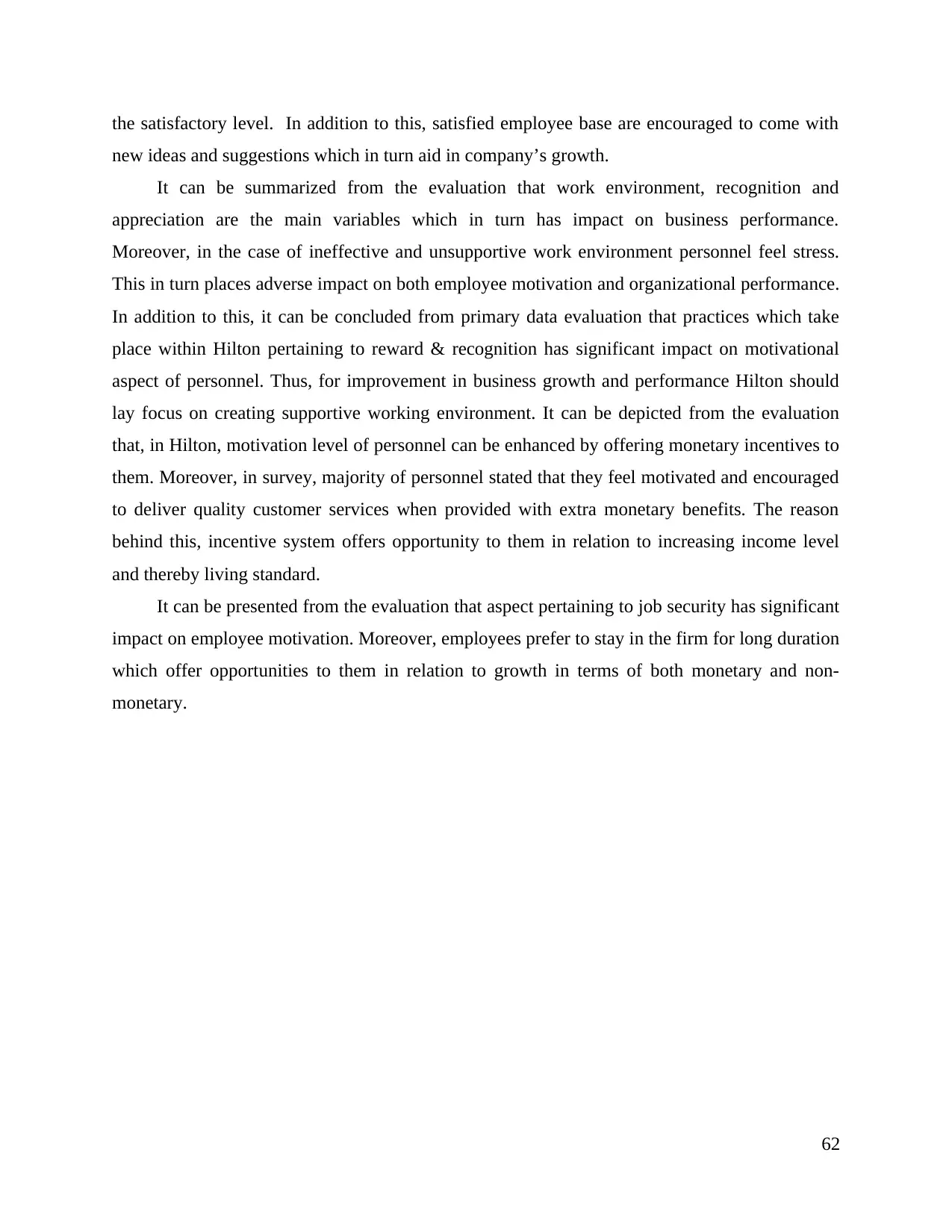
the satisfactory level. In addition to this, satisfied employee base are encouraged to come with
new ideas and suggestions which in turn aid in company’s growth.
It can be summarized from the evaluation that work environment, recognition and
appreciation are the main variables which in turn has impact on business performance.
Moreover, in the case of ineffective and unsupportive work environment personnel feel stress.
This in turn places adverse impact on both employee motivation and organizational performance.
In addition to this, it can be concluded from primary data evaluation that practices which take
place within Hilton pertaining to reward & recognition has significant impact on motivational
aspect of personnel. Thus, for improvement in business growth and performance Hilton should
lay focus on creating supportive working environment. It can be depicted from the evaluation
that, in Hilton, motivation level of personnel can be enhanced by offering monetary incentives to
them. Moreover, in survey, majority of personnel stated that they feel motivated and encouraged
to deliver quality customer services when provided with extra monetary benefits. The reason
behind this, incentive system offers opportunity to them in relation to increasing income level
and thereby living standard.
It can be presented from the evaluation that aspect pertaining to job security has significant
impact on employee motivation. Moreover, employees prefer to stay in the firm for long duration
which offer opportunities to them in relation to growth in terms of both monetary and non-
monetary.
62
new ideas and suggestions which in turn aid in company’s growth.
It can be summarized from the evaluation that work environment, recognition and
appreciation are the main variables which in turn has impact on business performance.
Moreover, in the case of ineffective and unsupportive work environment personnel feel stress.
This in turn places adverse impact on both employee motivation and organizational performance.
In addition to this, it can be concluded from primary data evaluation that practices which take
place within Hilton pertaining to reward & recognition has significant impact on motivational
aspect of personnel. Thus, for improvement in business growth and performance Hilton should
lay focus on creating supportive working environment. It can be depicted from the evaluation
that, in Hilton, motivation level of personnel can be enhanced by offering monetary incentives to
them. Moreover, in survey, majority of personnel stated that they feel motivated and encouraged
to deliver quality customer services when provided with extra monetary benefits. The reason
behind this, incentive system offers opportunity to them in relation to increasing income level
and thereby living standard.
It can be presented from the evaluation that aspect pertaining to job security has significant
impact on employee motivation. Moreover, employees prefer to stay in the firm for long duration
which offer opportunities to them in relation to growth in terms of both monetary and non-
monetary.
62

Recommendations
The above research have clearly depicted the impact of employee motivation of employee
on the growth of business. There are several factors that affect the performance of employee and
have an impact on the overall performance of the organisation. The management of the Hilton
are provided with the following recommendation through which the motivation employee the
staff and employee can be enhanced:
Performance appraisal activities and information: One of the major factor that effects
the motivation of employees in the hospitality sector is the performance appraisal
activities for the employees. For this the organisation can undertake analysing and
evaluation of each activity and task given different employees with set standards. On the
basis of this appraisal and bonus must be decided. This will directly enhance the
performance of the employee as every one want better appraisable and bonus.
Enhancement of cultural integration: The employees of the hotel face problems and
get demotivated by the cutler different among the employee and staff members. For this it
is recommended to take initiative for mitigate the difference regarding the cultural and
preference accordingly. With more integrated culture at the workplace employees build a
sense of belongingness with organisation and perform better.
Employee feedback system: Hilton is advised to lay focus on taking feedbacks from
personnel periodically regarding working activities & practices. This in turn provides
manager with suitable information regarding areas in which personnel are facing
difficulties. Hence, by taking into account such aspects manager can conduct training
session for personnel which in turn leads both employee motivation and performance
enhancement. Moreover, employees feel high level of motivation when they have idea in
relation to carrying out work. Thus, by evolving feedback system within Hilton manager
can build and maintain high employee motivation. Reward and recognition: As per Maslow’s hierarchy theory reward and recognition
system plays a vital role in improving employee motivation level. Higher level managers
feel good when they appreciated for their work. On the basis of such aspect, by providing
managers with rewards for their exceptional performance motivation level can be
The above research have clearly depicted the impact of employee motivation of employee
on the growth of business. There are several factors that affect the performance of employee and
have an impact on the overall performance of the organisation. The management of the Hilton
are provided with the following recommendation through which the motivation employee the
staff and employee can be enhanced:
Performance appraisal activities and information: One of the major factor that effects
the motivation of employees in the hospitality sector is the performance appraisal
activities for the employees. For this the organisation can undertake analysing and
evaluation of each activity and task given different employees with set standards. On the
basis of this appraisal and bonus must be decided. This will directly enhance the
performance of the employee as every one want better appraisable and bonus.
Enhancement of cultural integration: The employees of the hotel face problems and
get demotivated by the cutler different among the employee and staff members. For this it
is recommended to take initiative for mitigate the difference regarding the cultural and
preference accordingly. With more integrated culture at the workplace employees build a
sense of belongingness with organisation and perform better.
Employee feedback system: Hilton is advised to lay focus on taking feedbacks from
personnel periodically regarding working activities & practices. This in turn provides
manager with suitable information regarding areas in which personnel are facing
difficulties. Hence, by taking into account such aspects manager can conduct training
session for personnel which in turn leads both employee motivation and performance
enhancement. Moreover, employees feel high level of motivation when they have idea in
relation to carrying out work. Thus, by evolving feedback system within Hilton manager
can build and maintain high employee motivation. Reward and recognition: As per Maslow’s hierarchy theory reward and recognition
system plays a vital role in improving employee motivation level. Higher level managers
feel good when they appreciated for their work. On the basis of such aspect, by providing
managers with rewards for their exceptional performance motivation level can be
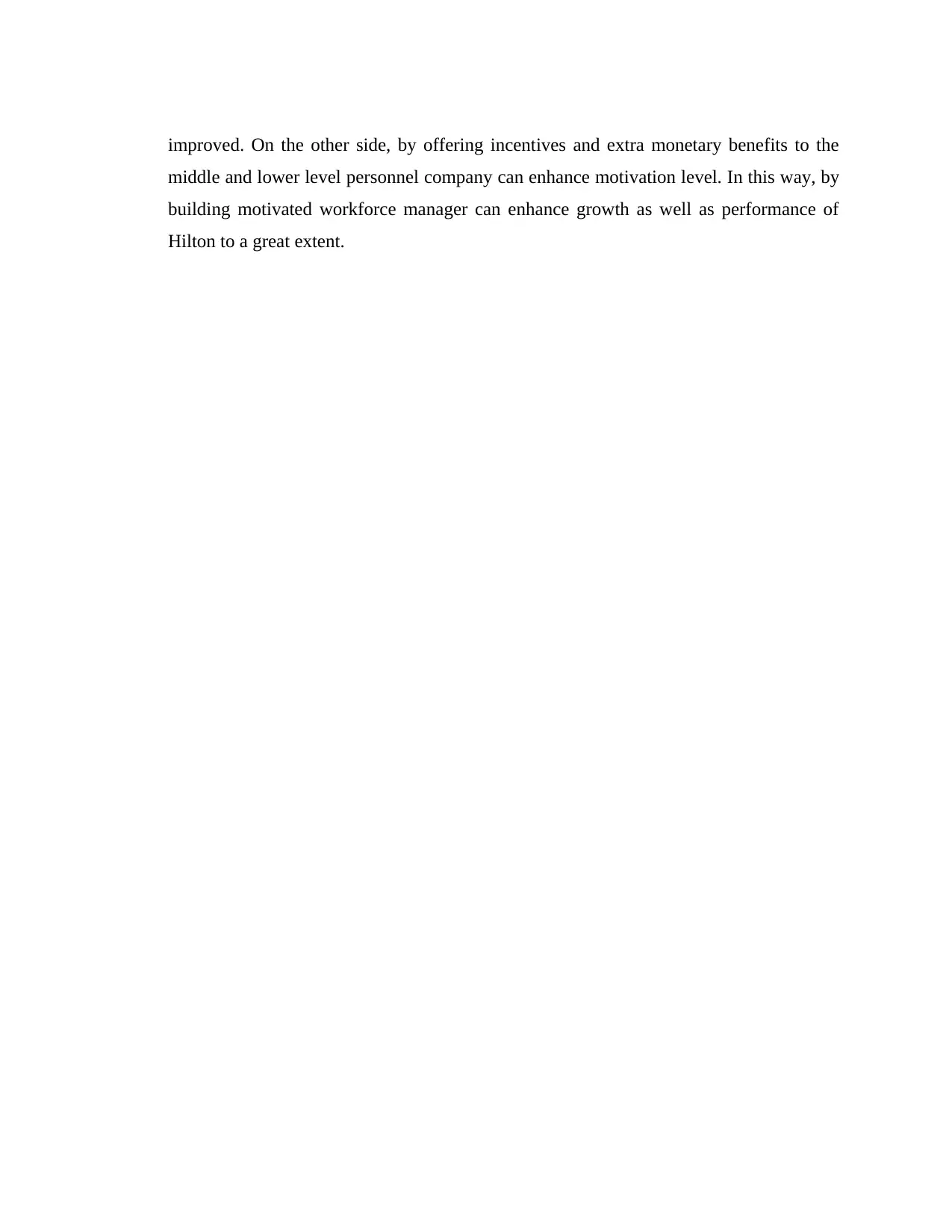
improved. On the other side, by offering incentives and extra monetary benefits to the
middle and lower level personnel company can enhance motivation level. In this way, by
building motivated workforce manager can enhance growth as well as performance of
Hilton to a great extent.
middle and lower level personnel company can enhance motivation level. In this way, by
building motivated workforce manager can enhance growth as well as performance of
Hilton to a great extent.
Paraphrase This Document
Need a fresh take? Get an instant paraphrase of this document with our AI Paraphraser
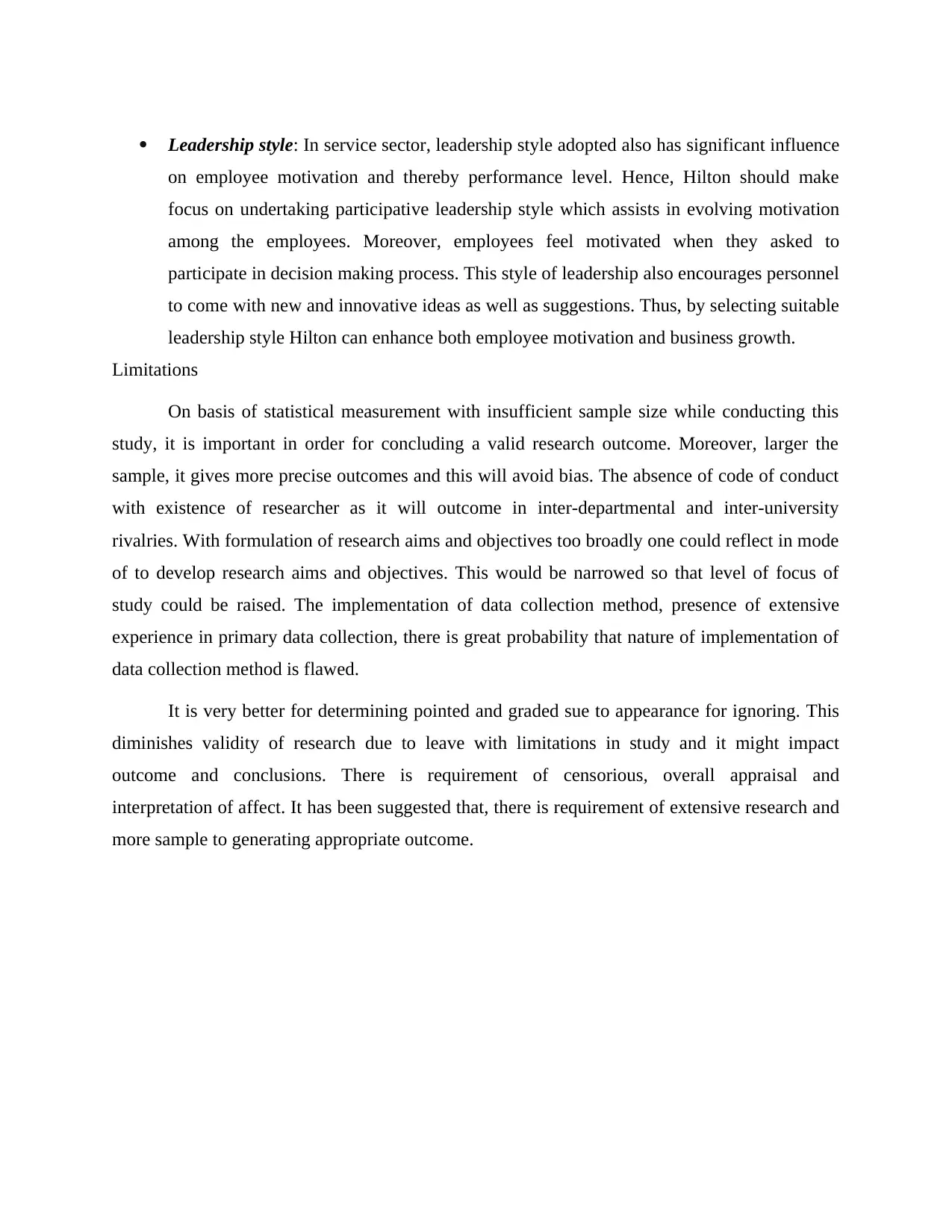
Leadership style: In service sector, leadership style adopted also has significant influence
on employee motivation and thereby performance level. Hence, Hilton should make
focus on undertaking participative leadership style which assists in evolving motivation
among the employees. Moreover, employees feel motivated when they asked to
participate in decision making process. This style of leadership also encourages personnel
to come with new and innovative ideas as well as suggestions. Thus, by selecting suitable
leadership style Hilton can enhance both employee motivation and business growth.
Limitations
On basis of statistical measurement with insufficient sample size while conducting this
study, it is important in order for concluding a valid research outcome. Moreover, larger the
sample, it gives more precise outcomes and this will avoid bias. The absence of code of conduct
with existence of researcher as it will outcome in inter-departmental and inter-university
rivalries. With formulation of research aims and objectives too broadly one could reflect in mode
of to develop research aims and objectives. This would be narrowed so that level of focus of
study could be raised. The implementation of data collection method, presence of extensive
experience in primary data collection, there is great probability that nature of implementation of
data collection method is flawed.
It is very better for determining pointed and graded sue to appearance for ignoring. This
diminishes validity of research due to leave with limitations in study and it might impact
outcome and conclusions. There is requirement of censorious, overall appraisal and
interpretation of affect. It has been suggested that, there is requirement of extensive research and
more sample to generating appropriate outcome.
on employee motivation and thereby performance level. Hence, Hilton should make
focus on undertaking participative leadership style which assists in evolving motivation
among the employees. Moreover, employees feel motivated when they asked to
participate in decision making process. This style of leadership also encourages personnel
to come with new and innovative ideas as well as suggestions. Thus, by selecting suitable
leadership style Hilton can enhance both employee motivation and business growth.
Limitations
On basis of statistical measurement with insufficient sample size while conducting this
study, it is important in order for concluding a valid research outcome. Moreover, larger the
sample, it gives more precise outcomes and this will avoid bias. The absence of code of conduct
with existence of researcher as it will outcome in inter-departmental and inter-university
rivalries. With formulation of research aims and objectives too broadly one could reflect in mode
of to develop research aims and objectives. This would be narrowed so that level of focus of
study could be raised. The implementation of data collection method, presence of extensive
experience in primary data collection, there is great probability that nature of implementation of
data collection method is flawed.
It is very better for determining pointed and graded sue to appearance for ignoring. This
diminishes validity of research due to leave with limitations in study and it might impact
outcome and conclusions. There is requirement of censorious, overall appraisal and
interpretation of affect. It has been suggested that, there is requirement of extensive research and
more sample to generating appropriate outcome.
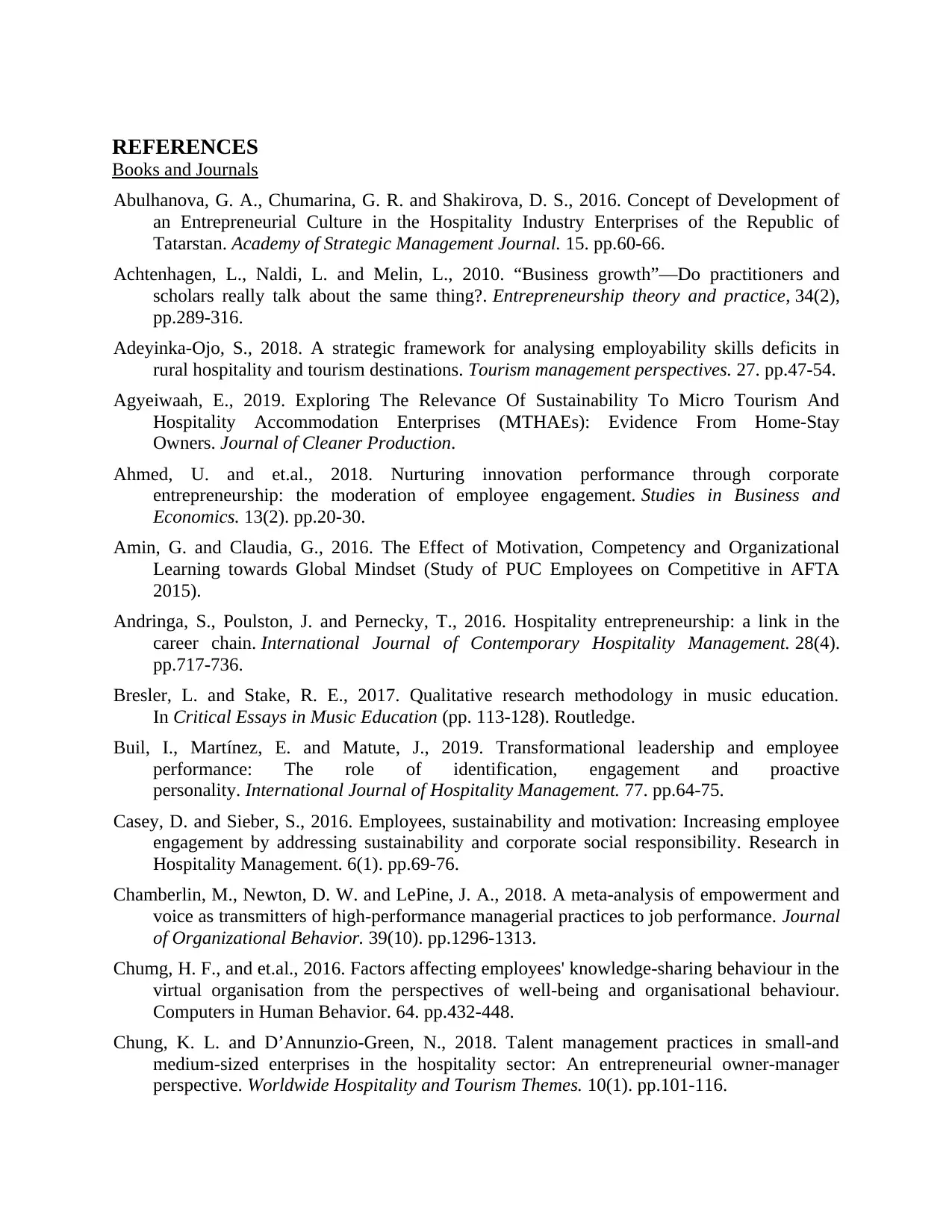
REFERENCES
Books and Journals
Abulhanova, G. A., Chumarina, G. R. and Shakirova, D. S., 2016. Concept of Development of
an Entrepreneurial Culture in the Hospitality Industry Enterprises of the Republic of
Tatarstan. Academy of Strategic Management Journal. 15. pp.60-66.
Achtenhagen, L., Naldi, L. and Melin, L., 2010. “Business growth”—Do practitioners and
scholars really talk about the same thing?. Entrepreneurship theory and practice, 34(2),
pp.289-316.
Adeyinka-Ojo, S., 2018. A strategic framework for analysing employability skills deficits in
rural hospitality and tourism destinations. Tourism management perspectives. 27. pp.47-54.
Agyeiwaah, E., 2019. Exploring The Relevance Of Sustainability To Micro Tourism And
Hospitality Accommodation Enterprises (MTHAEs): Evidence From Home-Stay
Owners. Journal of Cleaner Production.
Ahmed, U. and et.al., 2018. Nurturing innovation performance through corporate
entrepreneurship: the moderation of employee engagement. Studies in Business and
Economics. 13(2). pp.20-30.
Amin, G. and Claudia, G., 2016. The Effect of Motivation, Competency and Organizational
Learning towards Global Mindset (Study of PUC Employees on Competitive in AFTA
2015).
Andringa, S., Poulston, J. and Pernecky, T., 2016. Hospitality entrepreneurship: a link in the
career chain. International Journal of Contemporary Hospitality Management. 28(4).
pp.717-736.
Bresler, L. and Stake, R. E., 2017. Qualitative research methodology in music education.
In Critical Essays in Music Education (pp. 113-128). Routledge.
Buil, I., Martínez, E. and Matute, J., 2019. Transformational leadership and employee
performance: The role of identification, engagement and proactive
personality. International Journal of Hospitality Management. 77. pp.64-75.
Casey, D. and Sieber, S., 2016. Employees, sustainability and motivation: Increasing employee
engagement by addressing sustainability and corporate social responsibility. Research in
Hospitality Management. 6(1). pp.69-76.
Chamberlin, M., Newton, D. W. and LePine, J. A., 2018. A meta‐analysis of empowerment and
voice as transmitters of high‐performance managerial practices to job performance. Journal
of Organizational Behavior. 39(10). pp.1296-1313.
Chumg, H. F., and et.al., 2016. Factors affecting employees' knowledge-sharing behaviour in the
virtual organisation from the perspectives of well-being and organisational behaviour.
Computers in Human Behavior. 64. pp.432-448.
Chung, K. L. and D’Annunzio-Green, N., 2018. Talent management practices in small-and
medium-sized enterprises in the hospitality sector: An entrepreneurial owner-manager
perspective. Worldwide Hospitality and Tourism Themes. 10(1). pp.101-116.
Books and Journals
Abulhanova, G. A., Chumarina, G. R. and Shakirova, D. S., 2016. Concept of Development of
an Entrepreneurial Culture in the Hospitality Industry Enterprises of the Republic of
Tatarstan. Academy of Strategic Management Journal. 15. pp.60-66.
Achtenhagen, L., Naldi, L. and Melin, L., 2010. “Business growth”—Do practitioners and
scholars really talk about the same thing?. Entrepreneurship theory and practice, 34(2),
pp.289-316.
Adeyinka-Ojo, S., 2018. A strategic framework for analysing employability skills deficits in
rural hospitality and tourism destinations. Tourism management perspectives. 27. pp.47-54.
Agyeiwaah, E., 2019. Exploring The Relevance Of Sustainability To Micro Tourism And
Hospitality Accommodation Enterprises (MTHAEs): Evidence From Home-Stay
Owners. Journal of Cleaner Production.
Ahmed, U. and et.al., 2018. Nurturing innovation performance through corporate
entrepreneurship: the moderation of employee engagement. Studies in Business and
Economics. 13(2). pp.20-30.
Amin, G. and Claudia, G., 2016. The Effect of Motivation, Competency and Organizational
Learning towards Global Mindset (Study of PUC Employees on Competitive in AFTA
2015).
Andringa, S., Poulston, J. and Pernecky, T., 2016. Hospitality entrepreneurship: a link in the
career chain. International Journal of Contemporary Hospitality Management. 28(4).
pp.717-736.
Bresler, L. and Stake, R. E., 2017. Qualitative research methodology in music education.
In Critical Essays in Music Education (pp. 113-128). Routledge.
Buil, I., Martínez, E. and Matute, J., 2019. Transformational leadership and employee
performance: The role of identification, engagement and proactive
personality. International Journal of Hospitality Management. 77. pp.64-75.
Casey, D. and Sieber, S., 2016. Employees, sustainability and motivation: Increasing employee
engagement by addressing sustainability and corporate social responsibility. Research in
Hospitality Management. 6(1). pp.69-76.
Chamberlin, M., Newton, D. W. and LePine, J. A., 2018. A meta‐analysis of empowerment and
voice as transmitters of high‐performance managerial practices to job performance. Journal
of Organizational Behavior. 39(10). pp.1296-1313.
Chumg, H. F., and et.al., 2016. Factors affecting employees' knowledge-sharing behaviour in the
virtual organisation from the perspectives of well-being and organisational behaviour.
Computers in Human Behavior. 64. pp.432-448.
Chung, K. L. and D’Annunzio-Green, N., 2018. Talent management practices in small-and
medium-sized enterprises in the hospitality sector: An entrepreneurial owner-manager
perspective. Worldwide Hospitality and Tourism Themes. 10(1). pp.101-116.
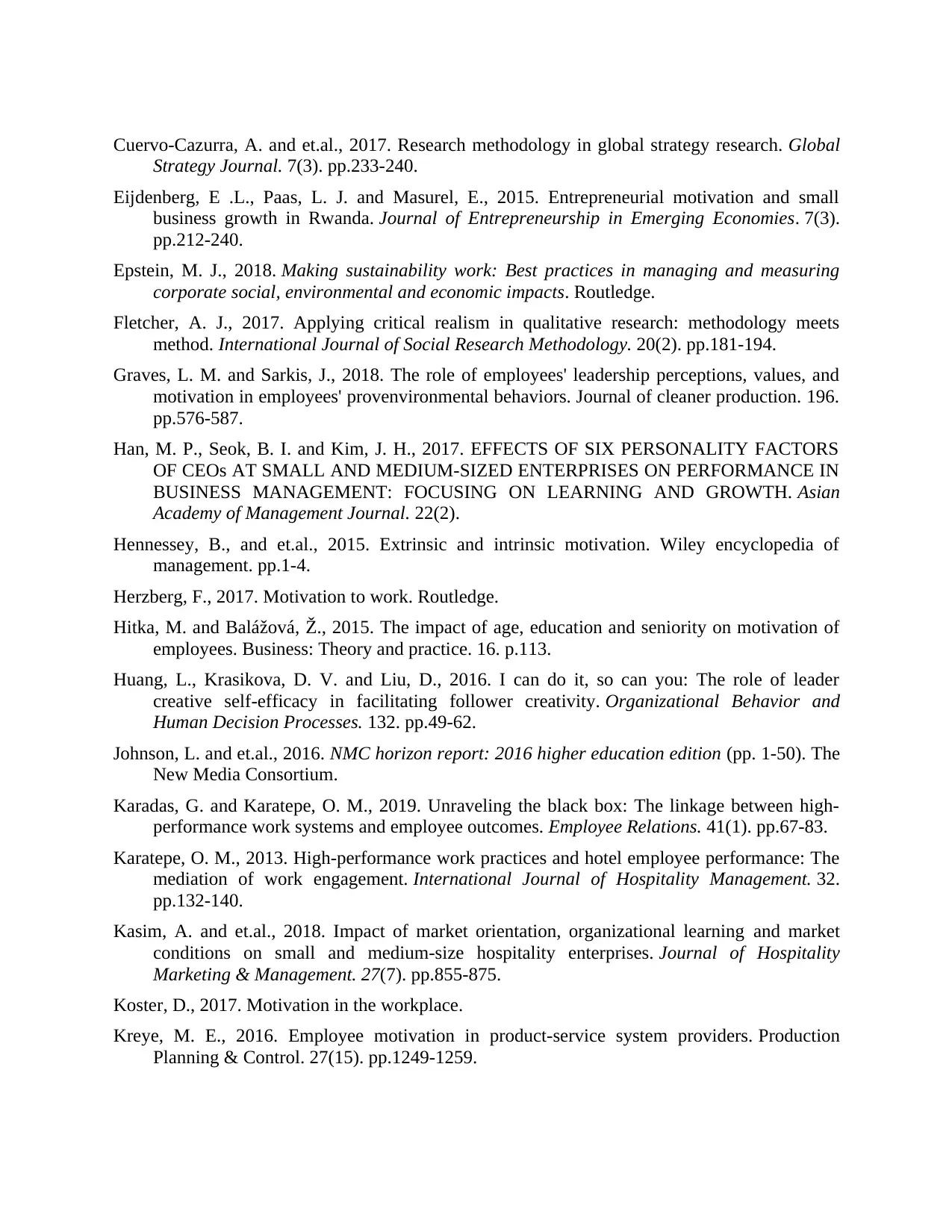
Cuervo‐Cazurra, A. and et.al., 2017. Research methodology in global strategy research. Global
Strategy Journal. 7(3). pp.233-240.
Eijdenberg, E .L., Paas, L. J. and Masurel, E., 2015. Entrepreneurial motivation and small
business growth in Rwanda. Journal of Entrepreneurship in Emerging Economies. 7(3).
pp.212-240.
Epstein, M. J., 2018. Making sustainability work: Best practices in managing and measuring
corporate social, environmental and economic impacts. Routledge.
Fletcher, A. J., 2017. Applying critical realism in qualitative research: methodology meets
method. International Journal of Social Research Methodology. 20(2). pp.181-194.
Graves, L. M. and Sarkis, J., 2018. The role of employees' leadership perceptions, values, and
motivation in employees' provenvironmental behaviors. Journal of cleaner production. 196.
pp.576-587.
Han, M. P., Seok, B. I. and Kim, J. H., 2017. EFFECTS OF SIX PERSONALITY FACTORS
OF CEOs AT SMALL AND MEDIUM-SIZED ENTERPRISES ON PERFORMANCE IN
BUSINESS MANAGEMENT: FOCUSING ON LEARNING AND GROWTH. Asian
Academy of Management Journal. 22(2).
Hennessey, B., and et.al., 2015. Extrinsic and intrinsic motivation. Wiley encyclopedia of
management. pp.1-4.
Herzberg, F., 2017. Motivation to work. Routledge.
Hitka, M. and Balážová, Ž., 2015. The impact of age, education and seniority on motivation of
employees. Business: Theory and practice. 16. p.113.
Huang, L., Krasikova, D. V. and Liu, D., 2016. I can do it, so can you: The role of leader
creative self-efficacy in facilitating follower creativity. Organizational Behavior and
Human Decision Processes. 132. pp.49-62.
Johnson, L. and et.al., 2016. NMC horizon report: 2016 higher education edition (pp. 1-50). The
New Media Consortium.
Karadas, G. and Karatepe, O. M., 2019. Unraveling the black box: The linkage between high-
performance work systems and employee outcomes. Employee Relations. 41(1). pp.67-83.
Karatepe, O. M., 2013. High-performance work practices and hotel employee performance: The
mediation of work engagement. International Journal of Hospitality Management. 32.
pp.132-140.
Kasim, A. and et.al., 2018. Impact of market orientation, organizational learning and market
conditions on small and medium-size hospitality enterprises. Journal of Hospitality
Marketing & Management. 27(7). pp.855-875.
Koster, D., 2017. Motivation in the workplace.
Kreye, M. E., 2016. Employee motivation in product-service system providers. Production
Planning & Control. 27(15). pp.1249-1259.
Strategy Journal. 7(3). pp.233-240.
Eijdenberg, E .L., Paas, L. J. and Masurel, E., 2015. Entrepreneurial motivation and small
business growth in Rwanda. Journal of Entrepreneurship in Emerging Economies. 7(3).
pp.212-240.
Epstein, M. J., 2018. Making sustainability work: Best practices in managing and measuring
corporate social, environmental and economic impacts. Routledge.
Fletcher, A. J., 2017. Applying critical realism in qualitative research: methodology meets
method. International Journal of Social Research Methodology. 20(2). pp.181-194.
Graves, L. M. and Sarkis, J., 2018. The role of employees' leadership perceptions, values, and
motivation in employees' provenvironmental behaviors. Journal of cleaner production. 196.
pp.576-587.
Han, M. P., Seok, B. I. and Kim, J. H., 2017. EFFECTS OF SIX PERSONALITY FACTORS
OF CEOs AT SMALL AND MEDIUM-SIZED ENTERPRISES ON PERFORMANCE IN
BUSINESS MANAGEMENT: FOCUSING ON LEARNING AND GROWTH. Asian
Academy of Management Journal. 22(2).
Hennessey, B., and et.al., 2015. Extrinsic and intrinsic motivation. Wiley encyclopedia of
management. pp.1-4.
Herzberg, F., 2017. Motivation to work. Routledge.
Hitka, M. and Balážová, Ž., 2015. The impact of age, education and seniority on motivation of
employees. Business: Theory and practice. 16. p.113.
Huang, L., Krasikova, D. V. and Liu, D., 2016. I can do it, so can you: The role of leader
creative self-efficacy in facilitating follower creativity. Organizational Behavior and
Human Decision Processes. 132. pp.49-62.
Johnson, L. and et.al., 2016. NMC horizon report: 2016 higher education edition (pp. 1-50). The
New Media Consortium.
Karadas, G. and Karatepe, O. M., 2019. Unraveling the black box: The linkage between high-
performance work systems and employee outcomes. Employee Relations. 41(1). pp.67-83.
Karatepe, O. M., 2013. High-performance work practices and hotel employee performance: The
mediation of work engagement. International Journal of Hospitality Management. 32.
pp.132-140.
Kasim, A. and et.al., 2018. Impact of market orientation, organizational learning and market
conditions on small and medium-size hospitality enterprises. Journal of Hospitality
Marketing & Management. 27(7). pp.855-875.
Koster, D., 2017. Motivation in the workplace.
Kreye, M. E., 2016. Employee motivation in product-service system providers. Production
Planning & Control. 27(15). pp.1249-1259.
Secure Best Marks with AI Grader
Need help grading? Try our AI Grader for instant feedback on your assignments.
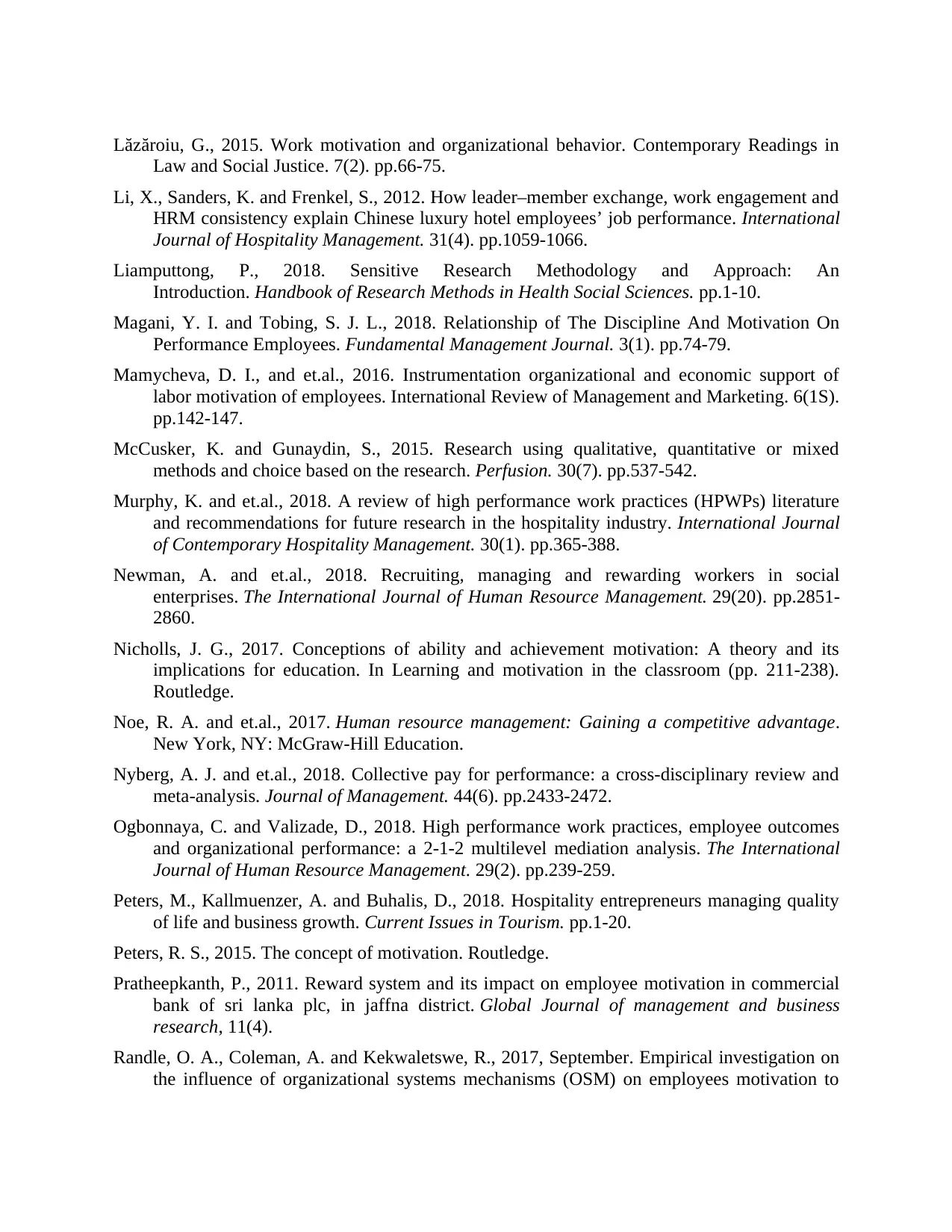
Lăzăroiu, G., 2015. Work motivation and organizational behavior. Contemporary Readings in
Law and Social Justice. 7(2). pp.66-75.
Li, X., Sanders, K. and Frenkel, S., 2012. How leader–member exchange, work engagement and
HRM consistency explain Chinese luxury hotel employees’ job performance. International
Journal of Hospitality Management. 31(4). pp.1059-1066.
Liamputtong, P., 2018. Sensitive Research Methodology and Approach: An
Introduction. Handbook of Research Methods in Health Social Sciences. pp.1-10.
Magani, Y. I. and Tobing, S. J. L., 2018. Relationship of The Discipline And Motivation On
Performance Employees. Fundamental Management Journal. 3(1). pp.74-79.
Mamycheva, D. I., and et.al., 2016. Instrumentation organizational and economic support of
labor motivation of employees. International Review of Management and Marketing. 6(1S).
pp.142-147.
McCusker, K. and Gunaydin, S., 2015. Research using qualitative, quantitative or mixed
methods and choice based on the research. Perfusion. 30(7). pp.537-542.
Murphy, K. and et.al., 2018. A review of high performance work practices (HPWPs) literature
and recommendations for future research in the hospitality industry. International Journal
of Contemporary Hospitality Management. 30(1). pp.365-388.
Newman, A. and et.al., 2018. Recruiting, managing and rewarding workers in social
enterprises. The International Journal of Human Resource Management. 29(20). pp.2851-
2860.
Nicholls, J. G., 2017. Conceptions of ability and achievement motivation: A theory and its
implications for education. In Learning and motivation in the classroom (pp. 211-238).
Routledge.
Noe, R. A. and et.al., 2017. Human resource management: Gaining a competitive advantage.
New York, NY: McGraw-Hill Education.
Nyberg, A. J. and et.al., 2018. Collective pay for performance: a cross-disciplinary review and
meta-analysis. Journal of Management. 44(6). pp.2433-2472.
Ogbonnaya, C. and Valizade, D., 2018. High performance work practices, employee outcomes
and organizational performance: a 2-1-2 multilevel mediation analysis. The International
Journal of Human Resource Management. 29(2). pp.239-259.
Peters, M., Kallmuenzer, A. and Buhalis, D., 2018. Hospitality entrepreneurs managing quality
of life and business growth. Current Issues in Tourism. pp.1-20.
Peters, R. S., 2015. The concept of motivation. Routledge.
Pratheepkanth, P., 2011. Reward system and its impact on employee motivation in commercial
bank of sri lanka plc, in jaffna district. Global Journal of management and business
research, 11(4).
Randle, O. A., Coleman, A. and Kekwaletswe, R., 2017, September. Empirical investigation on
the influence of organizational systems mechanisms (OSM) on employees motivation to
Law and Social Justice. 7(2). pp.66-75.
Li, X., Sanders, K. and Frenkel, S., 2012. How leader–member exchange, work engagement and
HRM consistency explain Chinese luxury hotel employees’ job performance. International
Journal of Hospitality Management. 31(4). pp.1059-1066.
Liamputtong, P., 2018. Sensitive Research Methodology and Approach: An
Introduction. Handbook of Research Methods in Health Social Sciences. pp.1-10.
Magani, Y. I. and Tobing, S. J. L., 2018. Relationship of The Discipline And Motivation On
Performance Employees. Fundamental Management Journal. 3(1). pp.74-79.
Mamycheva, D. I., and et.al., 2016. Instrumentation organizational and economic support of
labor motivation of employees. International Review of Management and Marketing. 6(1S).
pp.142-147.
McCusker, K. and Gunaydin, S., 2015. Research using qualitative, quantitative or mixed
methods and choice based on the research. Perfusion. 30(7). pp.537-542.
Murphy, K. and et.al., 2018. A review of high performance work practices (HPWPs) literature
and recommendations for future research in the hospitality industry. International Journal
of Contemporary Hospitality Management. 30(1). pp.365-388.
Newman, A. and et.al., 2018. Recruiting, managing and rewarding workers in social
enterprises. The International Journal of Human Resource Management. 29(20). pp.2851-
2860.
Nicholls, J. G., 2017. Conceptions of ability and achievement motivation: A theory and its
implications for education. In Learning and motivation in the classroom (pp. 211-238).
Routledge.
Noe, R. A. and et.al., 2017. Human resource management: Gaining a competitive advantage.
New York, NY: McGraw-Hill Education.
Nyberg, A. J. and et.al., 2018. Collective pay for performance: a cross-disciplinary review and
meta-analysis. Journal of Management. 44(6). pp.2433-2472.
Ogbonnaya, C. and Valizade, D., 2018. High performance work practices, employee outcomes
and organizational performance: a 2-1-2 multilevel mediation analysis. The International
Journal of Human Resource Management. 29(2). pp.239-259.
Peters, M., Kallmuenzer, A. and Buhalis, D., 2018. Hospitality entrepreneurs managing quality
of life and business growth. Current Issues in Tourism. pp.1-20.
Peters, R. S., 2015. The concept of motivation. Routledge.
Pratheepkanth, P., 2011. Reward system and its impact on employee motivation in commercial
bank of sri lanka plc, in jaffna district. Global Journal of management and business
research, 11(4).
Randle, O. A., Coleman, A. and Kekwaletswe, R., 2017, September. Empirical investigation on
the influence of organizational systems mechanisms (OSM) on employees motivation to
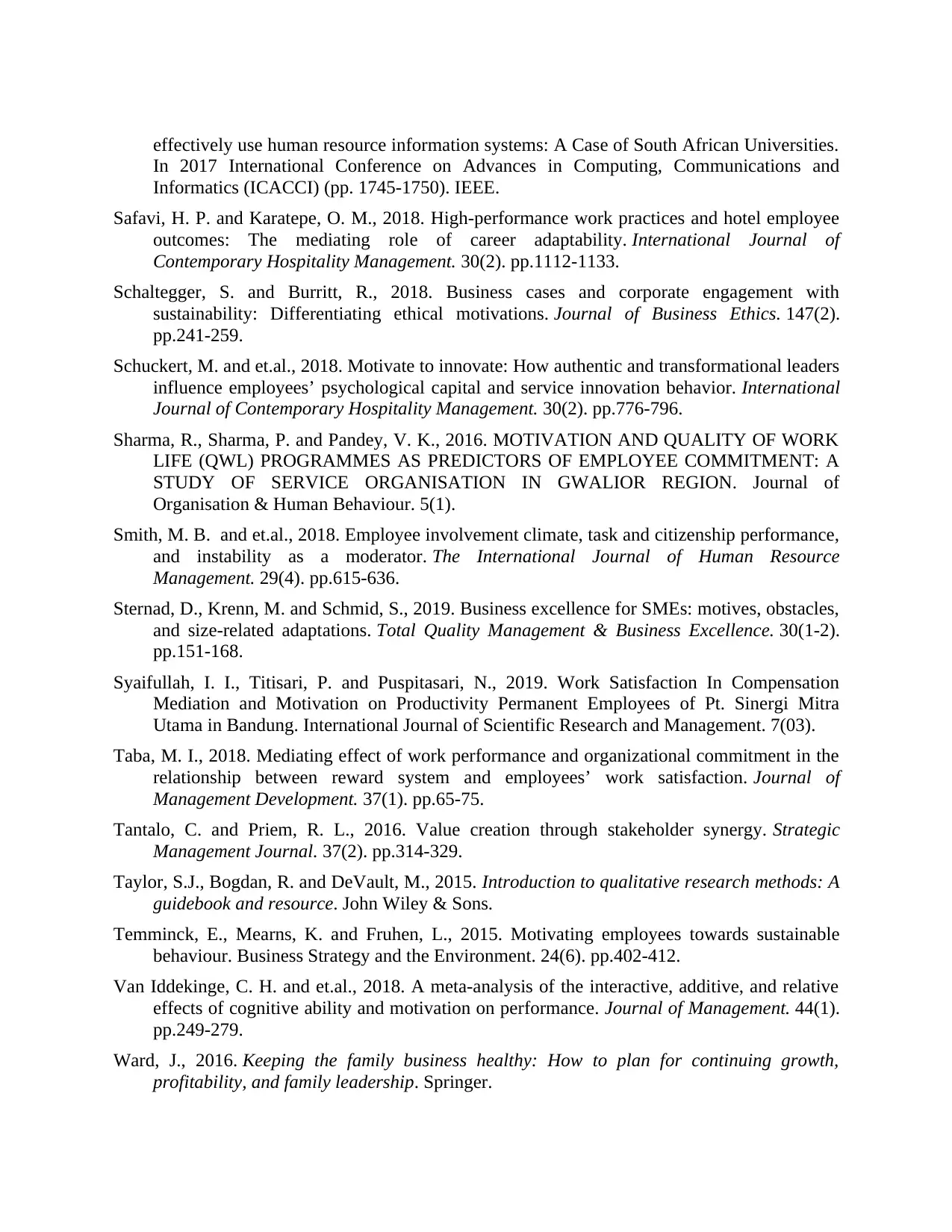
effectively use human resource information systems: A Case of South African Universities.
In 2017 International Conference on Advances in Computing, Communications and
Informatics (ICACCI) (pp. 1745-1750). IEEE.
Safavi, H. P. and Karatepe, O. M., 2018. High-performance work practices and hotel employee
outcomes: The mediating role of career adaptability. International Journal of
Contemporary Hospitality Management. 30(2). pp.1112-1133.
Schaltegger, S. and Burritt, R., 2018. Business cases and corporate engagement with
sustainability: Differentiating ethical motivations. Journal of Business Ethics. 147(2).
pp.241-259.
Schuckert, M. and et.al., 2018. Motivate to innovate: How authentic and transformational leaders
influence employees’ psychological capital and service innovation behavior. International
Journal of Contemporary Hospitality Management. 30(2). pp.776-796.
Sharma, R., Sharma, P. and Pandey, V. K., 2016. MOTIVATION AND QUALITY OF WORK
LIFE (QWL) PROGRAMMES AS PREDICTORS OF EMPLOYEE COMMITMENT: A
STUDY OF SERVICE ORGANISATION IN GWALIOR REGION. Journal of
Organisation & Human Behaviour. 5(1).
Smith, M. B. and et.al., 2018. Employee involvement climate, task and citizenship performance,
and instability as a moderator. The International Journal of Human Resource
Management. 29(4). pp.615-636.
Sternad, D., Krenn, M. and Schmid, S., 2019. Business excellence for SMEs: motives, obstacles,
and size-related adaptations. Total Quality Management & Business Excellence. 30(1-2).
pp.151-168.
Syaifullah, I. I., Titisari, P. and Puspitasari, N., 2019. Work Satisfaction In Compensation
Mediation and Motivation on Productivity Permanent Employees of Pt. Sinergi Mitra
Utama in Bandung. International Journal of Scientific Research and Management. 7(03).
Taba, M. I., 2018. Mediating effect of work performance and organizational commitment in the
relationship between reward system and employees’ work satisfaction. Journal of
Management Development. 37(1). pp.65-75.
Tantalo, C. and Priem, R. L., 2016. Value creation through stakeholder synergy. Strategic
Management Journal. 37(2). pp.314-329.
Taylor, S.J., Bogdan, R. and DeVault, M., 2015. Introduction to qualitative research methods: A
guidebook and resource. John Wiley & Sons.
Temminck, E., Mearns, K. and Fruhen, L., 2015. Motivating employees towards sustainable
behaviour. Business Strategy and the Environment. 24(6). pp.402-412.
Van Iddekinge, C. H. and et.al., 2018. A meta-analysis of the interactive, additive, and relative
effects of cognitive ability and motivation on performance. Journal of Management. 44(1).
pp.249-279.
Ward, J., 2016. Keeping the family business healthy: How to plan for continuing growth,
profitability, and family leadership. Springer.
In 2017 International Conference on Advances in Computing, Communications and
Informatics (ICACCI) (pp. 1745-1750). IEEE.
Safavi, H. P. and Karatepe, O. M., 2018. High-performance work practices and hotel employee
outcomes: The mediating role of career adaptability. International Journal of
Contemporary Hospitality Management. 30(2). pp.1112-1133.
Schaltegger, S. and Burritt, R., 2018. Business cases and corporate engagement with
sustainability: Differentiating ethical motivations. Journal of Business Ethics. 147(2).
pp.241-259.
Schuckert, M. and et.al., 2018. Motivate to innovate: How authentic and transformational leaders
influence employees’ psychological capital and service innovation behavior. International
Journal of Contemporary Hospitality Management. 30(2). pp.776-796.
Sharma, R., Sharma, P. and Pandey, V. K., 2016. MOTIVATION AND QUALITY OF WORK
LIFE (QWL) PROGRAMMES AS PREDICTORS OF EMPLOYEE COMMITMENT: A
STUDY OF SERVICE ORGANISATION IN GWALIOR REGION. Journal of
Organisation & Human Behaviour. 5(1).
Smith, M. B. and et.al., 2018. Employee involvement climate, task and citizenship performance,
and instability as a moderator. The International Journal of Human Resource
Management. 29(4). pp.615-636.
Sternad, D., Krenn, M. and Schmid, S., 2019. Business excellence for SMEs: motives, obstacles,
and size-related adaptations. Total Quality Management & Business Excellence. 30(1-2).
pp.151-168.
Syaifullah, I. I., Titisari, P. and Puspitasari, N., 2019. Work Satisfaction In Compensation
Mediation and Motivation on Productivity Permanent Employees of Pt. Sinergi Mitra
Utama in Bandung. International Journal of Scientific Research and Management. 7(03).
Taba, M. I., 2018. Mediating effect of work performance and organizational commitment in the
relationship between reward system and employees’ work satisfaction. Journal of
Management Development. 37(1). pp.65-75.
Tantalo, C. and Priem, R. L., 2016. Value creation through stakeholder synergy. Strategic
Management Journal. 37(2). pp.314-329.
Taylor, S.J., Bogdan, R. and DeVault, M., 2015. Introduction to qualitative research methods: A
guidebook and resource. John Wiley & Sons.
Temminck, E., Mearns, K. and Fruhen, L., 2015. Motivating employees towards sustainable
behaviour. Business Strategy and the Environment. 24(6). pp.402-412.
Van Iddekinge, C. H. and et.al., 2018. A meta-analysis of the interactive, additive, and relative
effects of cognitive ability and motivation on performance. Journal of Management. 44(1).
pp.249-279.
Ward, J., 2016. Keeping the family business healthy: How to plan for continuing growth,
profitability, and family leadership. Springer.
1 out of 72
Related Documents
Your All-in-One AI-Powered Toolkit for Academic Success.
+13062052269
info@desklib.com
Available 24*7 on WhatsApp / Email
![[object Object]](/_next/static/media/star-bottom.7253800d.svg)
Unlock your academic potential
© 2024 | Zucol Services PVT LTD | All rights reserved.





